Dimitrios Konidaris's Blog, page 6
September 18, 2022
ASCSA AS A LONG ARM OF AMERICAN POLITICS & VEHICLE OF ANTIHELLENISM
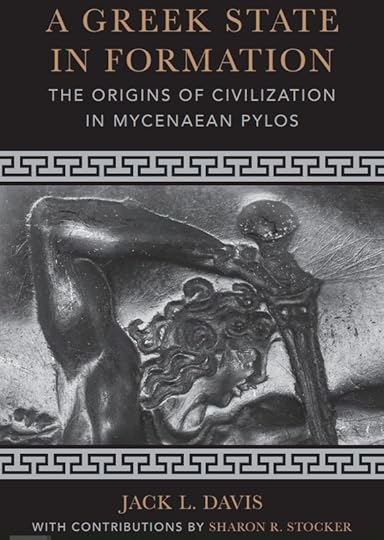
Î ÏÏÏÏαÏα ÎºÏ ÎºÎ»Î¿ÏÏÏηÏε Ïο βιβλίο ΠΥÎÎΣ: ÎÎÎ ÎÎÎÎÎÎÎÎ ÎΡÎΤÎΣ ΥΠΠÎÎΤÎΣÎÎÎ¥ÎÎ (A Greek State in Formation: The Origins of Mycenaean Pylos) αÏÏ Ïον Jack L. Davis και με ÏÏ Î¼Î¼ÎµÏοÏή ÏÎ·Ï ÏÏ Î¶ÏÎ³Î¿Ï ÏÎ¿Ï Sharon R. Stocker.
Î ÏÏ Î³Î³ÏαÏÎÎ±Ï Ï ÏήÏξε Î´Î¹ÎµÏ Î¸Ï Î½ÏÎ®Ï ÏÎ·Ï ÎμεÏÎ¹ÎºÎ±Î½Î¹ÎºÎ®Ï Î£ÏÎ¿Î»Î®Ï ÎλαÏικÏν ΣÏÎ¿Ï Î´Ïν ÏÏην Îθήνα (ASCSA) καθÏÏ ÎºÎ±Î¹ ÏÏ Î½Î´Î¹ÎµÏ Î¸Ï Î½ÏÎ®Ï ÏÏν αναÏκαÏÏν ÏÏην Î Ïλο, Î¼Î±Î¶Ï Î¼Îµ Ïην ÏÏÎ¶Ï Î³Ï ÏÎ¿Ï Stocker, ÎµÎ½Ï Î±Î¼ÏÏÏεÏοι ÏιÏÏÏνονÏαι Ïην αναÏκαÏή ÏÎ¿Ï ÏάÏÎ¿Ï ÏÎ¿Ï ÎÏÏÏα ΠολεμιÏÏή!η οÏοία ÏÏ Î¼Î¼ÎµÏείÏε και Το ÏÏολιαζÏμενο βιβλίο ÏεÏιλαμβάνει μιά ÏειÏά αÏÏÏÎµÎ¹Ï ÏÎ¿Ï ÏÏοκαλοÏν Ïον Îλληνα αναγνÏÏÏη και θα ÏÏολιαÏθοÏν εν ÏÏ Î½Ïομία ÏÏα εÏÏμενα. Τα αÏοÏÏάÏμαÏα ÏαÏαÏίθενÏαι καÏÏÏÎÏÏ, μεÏαÏÏαÏμÎνα αÏÏ Ïον γÏάÏονÏα, και ÏολιάζονÏαι:
ΠΤÏοÏνÏÎ±Ï ÎºÎ±Î¹ Ïο ÎµÎ¸Î½Î¹ÎºÏ Î±Ïήγημα(α) ο αÏÏαιολÏÎ³Î¿Ï Î¤ÏοÏνÏÎ±Ï ÎÏÏι, ενÏÏμάÏÏÏε μια αÏÏαιολογικά θεμελιÏμÎνη ÏÏοÏÏÏοÏία μÎÏα ÏÏο αÏήγημα ÏÎ¿Ï 1885 για Ïην Îλληνική εθνική ÏÏ Î½ÎÏεια ÏÎ¿Ï ÏÏ Î½ÎµÏÎθη αÏÏ Ïον Îλληνα εθνικιÏÏή ιÏÏοÏÎ¹ÎºÏ ÎÏνÏÏανÏίνο ΠαÏαÏÏηγÏÏÎ¿Ï Î»Î¿.[2]
Îή Îλληνική η ÎινÏική(β) Î ÎινÏική γλÏÏÏα δεν ήÏαν ελληνική οÏÏε ανήκε ÏÏην Î¹Î½Î´Î¿ÎµÏ ÏÏÏαÏκή οικογÎνεια γλÏÏÏÏν.[4]
ÎÏ ÎºÎ·Î½Î±Î¯Î¿Î¹ αλλά μή ÎλληνÏÏÏνοι!
(γ) Îεν μÏοÏεί ÏλÎον να Ï ÏοÏεθεί ÏÏι Ïλοι ÏÏοι μοιÏάζονÏαν Ïον ÎÏ ÎºÎ·Î½Î±ÏÎºÏ ÏολιÏιÏÎ¼Ï Î®Ïαν ελληνÏÏÏνοι ή ÏÏι ο ÎÏ ÎºÎ·Î½Î±ÏκÏÏ ÏολιÏιÏμÏÏ Î®Ïαν αναÏÏÏÎµÏ ÎºÏη ÎκÏÏαÏη οÏοιαÏδήÏοÏε Î»Î±Î½Î¸Î¬Î½Î¿Ï ÏÎ±Ï ÎµÎ»Î»Î·Î½Î¹ÎºÎ®Ï ÏÎ±Ï ÏÏÏηÏαÏ.[6]
Î ÏÏÏεÏονÏα κÏάÏη & Îλλάδα
(δ) Τα ÏεÏιÏÏÏÏεÏα αμεÏικανικά ÏανεÏιÏÏημιακά μαθήμαÏα ÏÎ¿Ï Î±ÏÏολοÏνÏαι με Ïην ÏÏοÎÎ»ÎµÏ Ïη ÏÎ¿Ï ÎºÏάÏÎ¿Ï Ï ÎµÏικενÏÏÏνονÏαι ÏÏα αÏοκαλοÏμενα ÏÏÏÏεÏονÏα ή ÏαÏθÎνα κÏάÏη, ÏεÏιοÏÎÏ ÏÎ¿Ï ÎºÏÏÎ¼Î¿Ï ÏÏÎ¿Ï Î¿Î¹ ÏολιÏιÏμοί - αÏÏαία ÎεÏοÏοÏαμία, ÎÎ¯Î³Ï ÏÏοÏ, ÎεÏοαμεÏική (ÎÎÎÎÎ!)ή Îίνα - Ï ÏοÏίθεÏαι ÏÏι ÏÏοÎÎºÏ Ïαν ανεξάÏÏηÏα αÏÏ ÎµÎ¾ÏÏεÏικÎÏ ÎµÏιÏÏοÎÏ. Îι ÏÏοÏÏÏοÏικοί αναγνÏÏÎ¯Î¶Î¿Ï Î½ ÏÏι οι γενικÎÏ Î´Î¹Î±Î´Î¹ÎºÎ±ÏÎ¯ÎµÏ ÏÎ¿Ï Î¿Î´Î®Î³Î·Ïαν ÏÏο ÏÏημαÏιÏÎ¼Ï ÎºÏάÏÎ¿Ï Ï Î®Ïαν Ïε μεγάλο Î²Î±Î¸Î¼Ï Î¿Î¹ Î¯Î´Î¹ÎµÏ ÏανÏÎ¿Ï ÏÏον κÏÏμο. [https://www.sociostudies.org/.../seh/...± κÏάÏη ÏÏην Îλλάδα, ÏÏÏÏÏο, θεÏÏοÏνÏαι Î´ÎµÏ ÏεÏεÏονÏα κÏάÏη και ÏÏ Ïνά ÏανÏάζονÏαι ÏÏι Î´Î·Î¼Î¹Î¿Ï Ïγήθηκαν ÏÏ Î±ÏάνÏηÏη ÏÏην εÏαÏή με Ïα ÏÏÏÏεÏονÏα κÏάÏη ÏÎ·Ï ÎÎÏÎ·Ï ÎναÏÎ¿Î»Î®Ï ÎºÎ±Î¹ ÏÎ·Ï ÎιγÏÏÏÎ¿Ï . ÎιαÏί ÏÏÏε να μελεÏήÏÎ¿Ï Î¼Îµ Ïην ÏÏοÎÎ»ÎµÏ Ïη ÏÏν ÏÏÏιμÏν κÏαÏÏν ÏÏην Îλλάδα; Î Îλλάδα (130.000 Ï.Ïλμ.) είναι μικÏή Ïε ÏÏγκÏιÏη με Ïη ÎεÏοÏοÏαμία (500.000 Ï.Ïλμ.), Ïη ÏÏγÏÏονη ÎÎ¯Î³Ï ÏÏο (1 εκαÏομμÏÏιο Ï.Ïλμ.) ή Ïη ÏÏγÏÏονη Îίνα (9,5 εκαÏ. Ï.Ïλμ.), ÏÎ¿Î»Ï Î¼Î¹ÎºÏÏÏεÏη ακÏμη και αÏÏ Ïην καÏδιά ÏÏν Îάγια ÏÏη ÎεÏοαμεÏική (390.000 Ï.Ïλμ. )[8]
ÎθÏμανικÏÏ 'Î¶Ï Î³ÏÏ'! (ε) ο ÎθÏμανικÏÏ Î¶Ï Î³ÏÏ ÏίθεÏαι ενÏÏÏ ÎµÎ¹ÏαγÏγικÏν![10]
ÎÎμαÏα ÏÏονολογήÏεÏÏ
(z) η Î ÏÏιμη ÎινÏική Î ÏÏÏÏ ÎºÎ±Î¹ η Î Î Î ÏοÏοθεÏοÏνÏαι αÏÏÏÎ¼ÎµÎ½ÎµÏ ÏÏο 3100 Ï.Χ. ανÏι ÏÎ¿Ï 3500 Ï.Χ.! [12]
Î Îλλάδα ÏÏ Î´Î·Î¼Î¹Î¿ÏÏγημα ÏÎ·Ï Î±ÏÏαιολογίαÏ! (η) Σε ανÏίθεÏη με ÏÎ¹Ï ÏÏÏÎ¹Î¼ÎµÏ ÏÏνθεÏÎµÏ ÎºÎ¿Î¹Î½ÏÎ½Î¯ÎµÏ ÏÏην ÎÎÏη ÎναÏολή και Ïην ÎÎ¯Î³Ï ÏÏο, ÏÎ¿Ï Î®Ïαν εγγÏάμμαÏεÏ, η Îλλάδα ÏÎ·Ï ÎÏοÏÎ®Ï ÏÎ¿Ï Î§Î±Î»ÎºÎ¿Ï ÎµÎ¯Î½Î±Î¹ Ïε μεγάλο Î²Î±Î¸Î¼Ï Î´Î·Î¼Î¹Î¿ÏÏγημα ÏÎ·Ï Î±ÏÏÎ±Î¹Î¿Î»Î¿Î³Î¯Î±Ï â γεγονÏÏ ÏÎ¿Ï Ïα ÏÎµÎ»ÎµÏ Ïαία 150 ÏÏÏνια ÎÏει κάνει Ïο Ïεδίο ιδιαίÏεÏα ÎµÏ Î±Î¯ÏθηÏο ÏÏη ÏειÏαγÏγηÏη αÏÏ Î´Ï Î½Î¬Î¼ÎµÎ¹Ï ÏÎ¿Ï ÎµÎ¸Î½Î¹ÎºÎ¹ÏμοÏ, ειδικά αλλά ÏÏι αÏοκλειÏÏικά Î±Ï ÏÎÏ ÏÎ¿Ï Î¬ÏκηÏε Ïο Î½ÎµÎ¿ÎµÎ»Î»Î·Î½Î¹ÎºÏ ÎÎ¸Î½Î¿Ï -κÏάÏοÏ.[14]
Î ÏοÏθÎÏÏ Î±ÏÏ Ïο Warriors for the Fatherland:[20] Σε Î±Ï ÏÏν Ïον αιÏνα, η αÏÏαιολογία ÎÏει Ïαίξει Ïε ÏολλÎÏ ÏεÏιÏÏÏÏÎµÎ¹Ï ÏημανÏÎ¹ÎºÏ ÎºÎ±Î¹ μεÏικÎÏ ÏοÏÎÏ ÎµÏίÏημο ÏÏλο ÏÏÎ¹Ï ÎµÏεκÏαÏικÎÏ ÏολιÏικÎÏ ÏÎ¿Ï ÎÎ»Î»Î·Î½Î¹ÎºÎ¿Ï ÎÎ¸Î½Î¿Ï Ï (βλ. Hamilakis and Yalouri 1996 για μια αναÏκÏÏηÏη ÏÏν μελεÏÏν ÏÎ¿Ï ÏÏεÏίζονÏαι με Î±Ï ÏÏ Ïο θÎμα). Îε Î±Ï ÏÏν Ïον ÏÏÏÏο, η Îλλάδα δεν αÏοÏελεί καθÏÎ»Î¿Ï ÎµÎ¾Î±Î¯ÏεÏη μεÏÎ±Î¾Ï ÏÏν ÎµÏ ÏÏÏαÏκÏν κÏαÏÏν, Ïημείο ÏÏο οÏοίο θα εÏανÎÎ»Î¸Ï Î±ÏγÏÏεÏα Ïε Î±Ï ÏÏ Ïο άÏθÏο. Îια μελÎÏη ÏÎ·Ï Î±ÏÏÎ±Î¹Î¿Î»Î¿Î³Î¯Î±Ï ÏÎ¿Ï ÎµÎ¸Î½Î¹ÎºÎ¹ÏÎ¼Î¿Ï ÏÏην Îλλάδα, ÏÏÏÏÏο, ÏÏοÏÏÎÏει ιδιαίÏεÏÎµÏ ÎµÏ ÎºÎ±Î¹ÏÎ¯ÎµÏ Ïε Îναν αÏÏαιολÏγο ÏÎ¿Ï ÎµÎ¾ÎµÏάζει ÏÎ¹Ï ÏÏÎÏÎµÎ¹Ï Î¼ÎµÏÎ±Î¾Ï ÏÎ·Ï ÎºÏ Î²ÎµÏνηÏÎ¹ÎºÎ®Ï ÏολιÏÎ¹ÎºÎ®Ï ÎºÎ±Î¹ ÏÎ·Ï ÎÏÎµÏ Î½Î±Ï ÏÎ¿Ï ÏαÏελθÏνÏοÏ. ÎÎ½Î±Ï Ï ÏηλÏÏ Î²Î±Î¸Î¼ÏÏ Î³ÏαÏειοκÏαÏÎ¹ÎºÎ¿Ï ÎµÎ»ÎγÏÎ¿Ï ÎÏει διαÏηÏηθεί ÏÏην αÏÏαιολογική ÎÏÎµÏ Î½Î± αÏÏ ÏÏÏε ÏÎ¿Ï Î¹Î´ÏÏθηκε Ïο ÎµÎ»Î»Î·Î½Î¹ÎºÏ ÎºÏάÏÎ¿Ï ÏÏÎ¹Ï Î±ÏÏÎÏ ÏÎ¿Ï 19Î¿Ï Î±Î¹Ïνα. Î¥ÏάÏÏÎ¿Ï Î½ λοιÏÏν άÏθονα δημοÏÎ¹ÎµÏ Î¼Îνα αÏÏεία ÏÎ¿Ï Î¼ÏοÏεί να καÏαγÏάÏÎ¿Ï Î½ λεÏÏομεÏÏÏ Î±ÎºÏμη και μικÏά εÏειÏÏδια αÏÏÎ±Î¹Î¿Î»Î¿Î³Î¹ÎºÎ®Ï ÎµÏιÏÏÏÎ¹Î±Ï ÎÏÎµÏ Î½Î±Ï. ÎÏιÏλÎον, θεÏÏείÏαι δεδομÎνο ÏÏι η εθνική ελληνική ÏÎ±Ï ÏÏÏηÏα Ï ÏήÏÏε ÏÏιν αÏÏ Ïο ÏÏημαÏιÏÎ¼Ï ÎµÎ»Î»Î·Î½Î¹ÎºÎ¿Ï ÎºÏάÏÎ¿Ï Ï (ÎιÏÏÎ¿Î¼Î·Î»Î¯Î´Î·Ï 1989). ΤÏÏο οι ÎÎ»Î»Î·Î½ÎµÏ ÏÏο και οι μη ÎÎ»Î»Î·Î½ÎµÏ ÎºÎ»Î±Ïικοί αÏÏαιολÏγοι ÎÏÎ¿Ï Î½ Ï ÏοθÎÏει ÏÏι Î±Ï Ïή η ÏÎ±Ï ÏÏÏηÏα μÏοÏεί να ανιÏÎ½ÎµÏ Î¸ÎµÎ¯ ÏÏον αÏÏαίο Ï Î»Î¹ÎºÏ ÏολιÏιÏμÏ. ÎαÏά ÏÏ Î½ÎÏεια, Ïο κÏάÏÎ¿Ï Î¼ÏοÏεί να δικαιολογηθεί να ÏÏηÏιμοÏοιήÏει αÏÏαιολογικά ÏÏοιÏεία για να ÏεκμηÏιÏÏει ÏÎ¹Ï ÏÏγÏÏÎ¿Î½ÎµÏ Î´Î¹ÎµÎºÎ´Î¹ÎºÎ®ÏÎµÎ¹Ï ÎµÏί εδαÏÏν, αν αÏοδειÏθεί ÏÏι οι κάÏοικοί ÏÎ¿Ï Ï ÏÏο ÏαÏελθÏν είÏαν κοινή «Îλληνική» εθνική ÏÏ Î½ÎµÎ¯Î´Î·Ïη. ΤÎλοÏ, δεδομÎÎ½Î¿Ï ÏÏι Ïε αÏκεÏÎÏ ÏεÏιÏÏÏÏÎµÎ¹Ï Ïον 19ο και Ïον 20Ï Î±Î¹Ïνα, Ïο κÏάÏÎ¿Ï ÏÎ·Ï ÎÎ»Î»Î¬Î´Î±Ï Î±ÎºÎ¿Î»Î¿ÏθηÏε Î¿Ï ÏιαÏÏικά ÏÏÏαÏηγικÎÏ ÎµÎ´Î±ÏÎ¹ÎºÎ®Ï ÎµÏεκÏάÏεÏÏ, είναι Î´Ï Î½Î±ÏÏν να ÏεÏιγÏαÏεί λεÏÏομεÏÏÏ Î¿ ÏÏÎ»Î¿Ï ÏÎ¿Ï ÎÏαιξε η αÏÏαιολογία Ïε Î±Ï ÏÎÏ ÏÎ¹Ï ÎµÏιÏειÏήÏειÏ...
ΣÏεÏÎ¹ÎºÏ Î¼Îµ Ïην ίδια εÏγαÏία είναι άÏθÏο ÏÎ·Ï Natalia Vogeikoff-Brogan Ïο οÏοίο ÏÏολιάζει Ïην, καÏά Ïην άÏοÏή ÏηÏ, Ï Î¹Î¿Î¸ÎÏηÏη ÏÎ·Ï Î±ÏÏÎ±Î¹Î¿Î»Î¿Î³Î¯Î±Ï ÏÏοκειμÎÎ½Î¿Ï Ïο ÎÎ»Î»Î·Î½Î¹ÎºÏ ÎºÏάÏÎ¿Ï Ïο 1912-1913 να διεκδικήÏει ÏÎ¿Ï Ï Î±ÏÏ Ïαλαιά Ï ÏάÏÏονÏÎµÏ ÏολιÏιÏÏικοÏÏ Î´ÎµÏμοÏÏ ÏÎ·Ï 'ÎÏÏÎ¹Î±Ï ÎλβανίαÏ' (ενν. ÎοÏÎµÎ¯Î¿Ï ÎÏείÏÎ¿Ï ) με Ïην Îλλάδα,[22] άÏοÏη ÏÎ¿Ï Î»Î¯Î³Î¿ ÏαÏακάÏÏ ÎµÏαναλαμβάνει για Ïην ÎÏνία ÏÎ·Ï ÏεÏιÏÎ´Î¿Ï 1919-1922. ΣÏην ÏεÏίÏÏÏÏη ÏÎ·Ï ÎÏÏÎ¹Î±Ï ÎÎ»Î²Î±Î½Î¯Î±Ï [ενν. ÎοÏÎµÎ¯Î¿Ï ÎÏείÏÎ¿Ï ], ο Davis Ï ÏοÏÏήÏιξε ÏÏι καÏά Ïη ÏÏνÏομη καÏοÏή ÏÎ·Ï Î±ÏÏ Ïην Îλλάδα Ïο 1912-1913, Ïο ÎÎ»Î»Î·Î½Î¹ÎºÏ ÎÏάÏÎ¿Ï ÏÏηÏιμοÏοίηÏε Ïην αÏÏαιολογία για να διεκδικήÏει ÏανάÏÏÎ±Î¹Î¿Ï Ï ÏολιÏιÏÏικοÏÏ Î´ÎµÏμοÏÏ Î¼Îµ Ïην Îλλάδα. ÎÏ ÏÏ Îγινε με Ïην ÏÏοÏθηÏη ÏÎ·Ï Î¼ÎµÎ»ÎÏÎ·Ï ÏÏν Î²Ï Î¶Î±Î½ÏινÏν μνημείÏν, με Ïη βοήθεια ÏÏον εξελληνιÏÎ¼Ï ÏÏν ÏοÏικÏν ÏοÏÏÎ½Ï Î¼Î¯Ïν και με Ïην ιεÏάÏÏηÏη ÏÎ·Ï Î±Î½Î±ÏκαÏÎ®Ï ÎµÎ»Î»Î·Î½Î¹ÏÏικÏν νεκÏοÏαÏείÏν. ΣÏην ÎικÏά ÎÏία, καÏά Ïη ÏÏνÏομη ÏεÏίοδο αÏÏ Ïο 1919 ÎÏÏ Ïο 1922, Ïο ÎµÎ»Î»Î·Î½Î¹ÎºÏ ÎºÏάÏÎ¿Ï ÏÏηÏιμοÏοίηÏε ξανά Ïην αÏÏαιολογία για να Ï ÏοÏÏηÏίξει εθνικιÏÏικÎÏ Î±ÏζÎνÏεÏ. Σαν ÏÏÏαÏιÏÏÎµÏ ÏÎ¿Ï Î±Î³ÏνίζονÏαι για Ïην αÏÎµÎ»ÎµÏ Î¸ÎÏÏÏη ÏÎ·Ï ÏαÏÏίδαÏ, οι ÎÎ»Î»Î·Î½ÎµÏ Î±ÏÏαιολÏγοι ÏÏάλθηκαν ÏÏη ÎικÏά ÎÏία για να ÏÏοÏθήÏÎ¿Ï Î½ Ïην ÏολιÏιÏÏική ενÏÏηÏα ÏÏν δÏο ÏÎ»ÎµÏ ÏÏν ÏÎ¿Ï ÎÎ¹Î³Î±Î¯Î¿Ï Î±Î½Î±ÏκαÏÎÏ Î±ÏÏαίÏν ελληνικÏν και Î²Ï Î¶Î±Î½ÏινÏν ÏοÏοθεÏιÏν. ÎεÏά αÏÏ Ïην ÎÏÏαιολογική ÎÏαιÏεία, η ÎμεÏικανική ΣÏολή ÎλαÏικÏν ΣÏÎ¿Ï Î´Ïν ÏÏην Îθήνα (ASCSA ή ΣÏολή ÏÏο εξήÏ) ÎÏÏειλε εÏίÏÎ·Ï Î¼Î¹Î± ομάδα αÏÏαιολÏγÏν για να αναÏκάÏει Ïην αÏÏαία ÎολοÏÏνα, αναμειγνÏονÏÎ±Ï ÎÏÏι Ïην εÏιÏÏήμη με Ïον ÏολιÏÎ¹ÎºÏ ÎºÎ±Î¹ÏοÏκοÏιÏμÏ. Îίναι ÏÏοÏανÎÏ ÏÏι η ÎºÏ Ïία, ÏÏÎλεÏÎ¿Ï ÎºÎ±Î¹ Î±Ï Ïή ÏÎ·Ï ASCSA, οÏÏα - ÏÏÏÏ ÏÎ¹Î¸Î±Î½Î¿Î»Î¿Î³Ï - γÏÎ½Î¿Ï Î»Î±Î¸ÏαίÏÏ ÎµÎ¹ÏελθοÏÏÎ±Ï ÏÏην ÏÏÏα, εÏαιδεÏθηκε ÎµÎ´Ï ÎºÎ±Î¹ ÎÏÏ Ïε ÏειÏÎ¬Ï Ï ÏοÏÏοÏιÏν ÏÏοκειμÎÎ½Î¿Ï Î½Î± Ï ÏηÏεÏήÏει Ïην ανθελληνική αÏζÎνÏα ÏÎ·Ï ÏÏολήÏ, αγνοοÏÏα - ÏÏ ÏÎ¹ÎºÏ ÏÏ Î»ÏÎ³Ï ÏÏ Î¼Î· Îλληνίδα - ÏÎ¿Ï Ï ÏανάÏÏÎ±Î¹Î¿Ï Ï Î´ÎµÏμοÏÏ Î¼Î±Ï ÏÏÏον με Ïην Î. ÎÏειÏο ÏÏον και με Ïην ÎÏνία!
ΣÏο ίδιο Î¼Î®ÎºÎ¿Ï ÎºÏμαÏÎ¿Ï Î¼Îµ Ïον Davis κινείÏαι και ÎλληνÏÏÏÎ½Î¿Ï ÎµÏÎµÏ Î½Î·ÏήÏ, καÏήγοÏÎ¿Ï ÏÎ·Ï ÎºÎµÏαλαιοκÏαÏÎ¯Î±Ï ÎºÎ±Î¹ ÏÎ·Ï Î±ÏοικιοκÏαÏίαÏ, εδÏεÏÏν ÏÏην ÎδÏα ÏÎ¿Ï ÎºÎµÏÎ±Î»Î±Î¯Î¿Ï , ιδÏÏ Î¸ÎµÎ¯Ïα αÏÏ Ïην μεγάλη Ïαλαιά αÏοικιοκÏαÏική Î. ÎÏεÏÏανία! Î ÏÏ Î¬Î½Ï, άλλÏÏÏε, και δÏαÏÏηÏιοÏοιείÏαι εÏίÏÎ·Ï Ï ÏÎÏ ÏÎ¿Ï ÎºÎ¹Î½Î®Î¼Î±ÏÎ¿Ï Î»Î±Î¸Ïο-ειÏÎ²Î¿Î»Î®Ï ÏÏην Îλλάδα (αλλά ÏÏι ÏÏÎ¹Ï ÎÎ Î!), δηλÏνει δε Ïε ÏÏεÏÎ¹ÎºÏ ÏÏνημά ÏÎ¿Ï :[30]
ÎÏ ÏÏ ÏÎ¿Ï Î²Î»ÎÏÎ¿Ï Î¼Îµ ÎµÎ´Ï ÎµÎ¯Î½Î±Î¹ μάλλον μια διαδικαÏία διÏÎ»Î¿Ï Î±ÏοικιÏμοÏ: ÏÏÏÏον, Ïον αÏοικιÏÎ¼Ï (ή κÏÏ ÏÏοαÏοικιÏμÏ) ÏÎ·Ï ÏεÏιοÏÎ®Ï ÏÎ¿Ï ÏήμεÏα Î¿Î½Î¿Î¼Î¬Î¶Î¿Ï Î¼Îµ Îλλάδα με Ïα ιδανικά ÏÎ¿Ï ÎµÎ»Î»Î·Î½Î¹ÏμοÏ,[81] και δεÏÏεÏον, Ïον αÏοικιÏÎ¼Ï ÏÏ Î³ÎºÎµÎºÏιμÎνÏν ÏοÏοθεÏιÏν, ÏÏÏÏ Î· Ïαλιά ÏÏ Î½Î¿Î¹ÎºÎ¯Î± ÏÎ·Ï ÎθήναÏ, αÏÏ Ïον μηÏανιÏÎ¼Ï ÏÎ·Ï Î¼Î¿Î½ÏεÏνιÏÏÎ¹ÎºÎ®Ï Î±ÏÏαιολογίαÏ, ÏÏο Ï ÏηÏεÏία ÏÎ¿Ï ÎλληνιÏμοÏ. ΤÏÏοn οι ÎÎ»Î»Î·Î½ÎµÏ ÏÏοn και οι ÎμεÏικανοί κοινÏνικοί ÏαÏάγονÏεÏ, ÎµÎ½Ï Ï ÏοÏÏήÏιζαν και αÏκοÏÏαν Ïην εθνική αÏÏαιολογία, ÏÏ Î¼Î¼ÎµÏείÏαν εÏίÏÎ·Ï Ïε Î±Ï ÏÏν Ïον διÏÎ»Ï Î±ÏοικιÏμÏ, αν και με διαÏοÏεÏικοÏÏ ÏÏÎ»Î¿Ï Ï, και ÏÏ Ïνά Ï Ïοβλήθηκαν Ïε Î±Ï ÏÏηÏÎÏ Î¹ÎµÏαÏÏÎ¯ÎµÏ ÎµÎ¾Î¿Ï ÏίαÏ, αÏοδεικνÏονÏÎ±Ï ÎÏÏι, ανÏίθεÏα με Ïον Trigger,82 ÏÏι εθνικιÏÏικÎÏ, αÏοικιοκÏαÏικÎÏ ÎºÎ±Î¹ ιμÏεÏιαλιÏÏικÎÏ Î±ÏÏÎ±Î¹Î¿Î»Î¿Î³Î¯ÎµÏ Î´ÎµÎ½ ÏÏÎÏει να θεÏÏοÏνÏαι ÏÏ Î´Î¹Î±ÎºÏιÏοί και ξεÏÏÏιÏÏοί ÏÏÏοι, αλλά ÏÏ Ï Î²ÏιδικÎÏ, ÏαÏάÏÎ»ÎµÏ ÏεÏ, αÏοικιÏÏικÎÏ Î¼Î¿ÏÏÎÏ ÏÎ·Ï Î´Ï ÏÎ¹ÎºÎ®Ï ÎºÎ±ÏιÏαλιÏÏÎ¹ÎºÎ®Ï Î½ÎµÏÏεÏικÏÏηÏαÏ.
ΣÎÎÎÎΩΣÎÎΣ
[2]. Davis 2022, p. 8.
[4]. Ï.Ï. p. 70.
[6]. Ï.Ï. p. xxi.
[8]. Ï.Ï. p. 1.
[10]. Ï.Ï. p. 29.
[12]. Ï.Ï. p. xxvi.
[14]. Ï.Ï. p. 4.
[20]. Davis, J. 2000, p. 77.
[22]. <https://nataliavogeikoff.com/2020/02/...
ÎÎÎÎÎÎÎΡÎΦÎÎ
https://luminosoa.org/site/books/m/10...
Davis, J. L. 2022. A Greek State in Formation: The Origins of Mycenaean Pylos, California: University of California Press. DOI: https://doi.org/10.1525/luminos.121
https://www.sociostudies.org/journal/..., H. J. M. 2016. "The Emergence of Pristine States," Social Evolution & History 15 (1), pp. 3â57.
https://www.academia.edu/28728515/J_D..., J. 2000. "Warriors for the Fatherland: National Consciousness and Archaeology in 'Barbarian' Epirus and 'Verdant' Ionia, 1912-1922," Journal of Mediterranean Archaeology 13, pp. 76-98.
https://www.jstor.org/stable/10.2972/..., J. L. & N. Vogeikoff-Brogan. 2013. Philhellenism, Philanthropy, or Political Convenience? American Archaeology in Greece (Hesperia: The Journal of the American School of Classical Studies at Athens 82 (1), Special Issue), ASCSA.
Hamilakis, Y. 2013. "Double Colonization: The Story of the Excavations of the Athenian Agora (1924â1931)," Hesperia 82 (1), pp. 153-177.
September 17, 2022
ORALITY & SCRIPT
Ï ÏάÏÏει η εÏιγÏαÏή:
Îι λÎÎ¾ÎµÎ¹Ï ÏÏÎÏει να αÏοÏÏηθίζονÏαι, ÏÏι να λÎγονÏαι ("Words are meant to be memorized. Not to be spoken")
με Ïον αναÏÏήÏανÏα να ÏÏοÏθÎÏει:
Î ÏοÏία ÏÎ¿Ï ÎοÏδα είÏε ÏκαλιÏÏεί με κÏÏο ÏÎ¬Î½Ï ÏÏην ÏÎÏÏα με ÏÎÏοια εξαιÏεÏική καλλιγÏαÏία. ΠγλÏÏÏÎ·Ï ÏÏÎÏει να διάβαζε Ïη ÏοÏÏÏα με Ïην καÏδιά και Ïην ÏÏ Ïή ÏÎ¿Ï . (This is my personal footnote marking the picture of this exquisitely carved Buddhist stone pagoda of the 4th century which was unearthed in Dunhuang in 1981).
ΠαÏάλληλη μÏοÏεί να θεÏÏηθεί, ÏημειÏθείÏα αÏÏ Ïον Derrida, αναÏοÏά ÏÎ¿Ï Î£ÏκÏάÏÎ¿Ï Ï ÏÏην δεÏÏεÏη ΠλαÏÏνική εÏιÏÏολή ÏÏÎ¿Ï Î¿ ΣÏκÏάÏÎ·Ï ÎµÎ¼ÏανίζεÏαι Ï ÏοÏÏηÏίζÏν ÏαÏαÏλήÏια άÏοÏη (Pl. L. 314.b.7 â 314.c.4):[2]
ΣκεÏÏείÏε Î±Ï Ïά Ïα γεγονÏÏα και να ÏÏοÏÎξεÏε να μην ÏÏ Î¼Î²ÎµÎ¯ ÏÏÏε μεÏικÎÏ ÏοÏÎÏ Î½Î± μεÏανοήÏεÏε για Ïο ÏÏι αÏεÏίÏκεÏÏα ÎÏεÏε δημοÏιεÏÏει ÏÎ¹Ï Î±ÏÏÏÎµÎ¹Ï ÏαÏ. Îίναι ÏÎ¿Î»Ï Ïιο αÏÏαλÎÏ Î½Î± αÏοÏÏÎ·Î¸Î¯Î¶ÎµÎ¹Ï Î±ÏÏ Ïο να γÏάÏÎµÎ¹Ï ..Îίναι αδÏναÏον ÏÏι ÎÏει γÏαÏεί να μην δημοÏιοÏοιείÏαι (μεγίÏÏη δὲ ÏÏ Î»Î±Îºá½´ Ïὸ μὴ γÏάÏειν á¼Î»Î»á¾½ á¼ÎºÎ¼Î±Î½Î¸Î¬Î½ÎµÎ¹Î½) ΠκαλÏÏεÏη ÏÏοÏÏλαξη είναι να μην γÏάÏÎµÎ¹Ï Î±Î»Î»Î¬ να μαθαίνειÏ, γιαÏί δεν γίνεÏαι να μην ÏÎÏÎ¿Ï Î½ κάÏοÏε Ïα γÏαÏÏά Ïε ακαÏάλληλα ÏÎÏια. Îια Ïον λÏγο Î±Ï ÏÏ Î´ÎµÎ½ ÎÏÏ Î³ÏάÏει κι ÎµÎ³Ï ÏοÏÎ ÏίÏοÏα ÏÏεÏÎ¹ÎºÏ Î¼Îµ ÏοÏÏα. Îεν Ï ÏάÏÏει οÏÏε θα Ï ÏάÏξει ÎÏγο ÏÎ¿Ï Î Î»Î¬ÏÏνα, ÎµÎ½Ï ÏÏα ÏήμεÏα ÏαÏακÏηÏίζονÏαι ÎÏÏι Î±Î½Î®ÎºÎ¿Ï Î½ ÏÏον ΣÏκÏάÏη, αÏÏ Ïην εÏοÏή ÏÎ¿Ï Î®Ïαν ÏÏÎ±Î¯Î¿Ï ÎºÎ±Î¹ νÎοÏ.»[4]
... ÎÏ ÏÏÏ ÎµÎ¯Î½Î±Î¹ ο λÏÎ³Î¿Ï Î³Î¹Î± Ïον οÏοίο δεν ÎÏÏ Î³ÏάÏει ÏίÏοÏα για Î±Ï Ïά Ïα ÏÏάγμαÏα, και γιαÏί δεν Ï ÏάÏÏει και δεν θα Ï ÏάÏξει καμία γÏαÏÏή ÎÏγο ÏÎ¿Ï Î Î»Î¬ÏÏνα δική â¦. ÎÏοια ÎÏγα θεÏÏοÏνÏαι ÏÏÏα ÏÎ¿Ï Î Î»Î¬ÏÏνοÏ, ÏÏην ÏÏαγμαÏικÏÏηÏα αÏοÏελοÏν ÎÏγα ÏÎ¿Ï Î£ÏκÏάÏÎ¿Ï Ï ..ÏÏολιÏμÎÎ½Î¿Ï ÎºÎ±Î¹ εκÏÏ Î³ÏÏονιÏθÎνÏÎ¿Ï ÎµÎ¯ (Ïá½° δὲ νῦν λεγÏμενα ΣÏκÏάÏÎ¿Ï Ï á¼ÏÏὶν καλοῦ καὶ νÎÎ¿Ï Î³ÎµÎ³Î¿Î½ÏÏοÏ). ÎνÏίο και ÏιÏÏεÏÏ. ÎιαβάÏÏε Ïην εÏιÏÏολή Î±Ï Ïή ÏÏÏα ÏÎ±Ï ÏÏÏÏονα ÏολλÎÏ ÏοÏÎÏ ÎºÎ±Î¹ καÏÏε Ïην." (ÎÏιÏÏολή Î, 314)
 ÎÏαÏ
ÏμÎνη BοÏ
διÏÏική αναθημαÏική λίθινη ÏαγÏδα (Collection of Dunhuang Museum)[4]
ÎÏαÏ
ÏμÎνη BοÏ
διÏÏική αναθημαÏική λίθινη ÏαγÏδα (Collection of Dunhuang Museum)[4]Î ÏÏάÏη Î±Ï Ïή ÎνανÏι ÏÎ·Ï ÏÏοÏοÏικÏÏηÏÎ¿Ï Î±ÏοÏελεί άλλο Îνα ÏÏοιÏείο ÏÎ¿Ï , ενδεÏομÎνÏÏ, ÏημαÏοδοÏεί Ïην ÏÏαÏξη εÏαÏÏν [μεÏÎ±Î¾Ï ÎÎ¿Ï Î´Î¹ÏÎ¼Î¿Ï ÎºÎ±Î¹ ÎλλάδοÏ], οÏÏÏδήÏοÏε ÏμÏÏ Ïην διεθνοÏοίηÏη ιδεÏν, ÏÏεÏίζεÏαι με Ïην Ï ÏοÏιμηÏική ή και αÏοÏÏιÏÏική ÏÎ·Ï ÎºÎ±ÏαγÏαÏÎ®Ï ÏÎ¿Ï Î³ÏαÏÏÎ¿Ï Î»ÏÎ³Î¿Ï ÏÏάÏη, η οÏοία ÏαίνεÏαι να διαÏεÏνά Ïον ÎÎ¿Ï Î´Î¹ÏμÏ, ÏÎ¿Ï Î»Î¬ÏιÏÏον Ïε ÏÏÏιμο ÏÏάδιο. Î ÏάγμαÏι ο ÎÎ¿Ï Î´Î¹ÏμÏÏ, αναÏÏÏ ÏÎ¸ÎµÎ¯Ï Ïε ÏεÏιβάλλον ÏÏÎ¿Ï ÎµÏεκÏάÏη η ÏÏοÏοÏική ÏαÏάδοÏη, αÏÎκÏηÏε ÏÏάÏη Ï ÏοÏÏηÏικÏική ÏÎ·Ï Î±ÏομνημονεÏÏεÏÏ, αÏÎ¿Ï Î¬Î»Î»ÏÏÏε καÏηγοÏία μοναÏÏν ÏÎ¿Ï Î®Ïαν εÏιÏοÏÏιÏμÎνη με Ïην αÏομνημÏÎ½ÎµÏ Ïη ÏÏν αÏÏειακÏν κειμÎνÏν και Ïην διδαÏκαλία με Î±Ï Ïά ÏÏν ÏιÏÏÏν.
ΧÏÏÎ¯Ï Ïην διάθεÏη να Ï ÏειÏÎÎ»Î¸Î¿Ï Î¼Îµ ÏÏο μεγάλο Î±Ï ÏÏ Î¸Îμα ÏÏοÏθÎÏÎ¿Ï Î¼Îµ ÎµÎ´Ï Î¼Ïνον ÏÏι ο Havelock[5] ÎÏεÏε εÏανάÏÏαÏη ÏÏον ÏÏÏÏο με Ïον οÏοίο οι μελεÏηÏÎÏ Î±Î½ÎÎ»Ï Ïαν Ïα ÎμηÏικά ÎÏη Ï ÏοÏÏηÏίζονÏÎ±Ï ÏÏι Î±Ï Ïά Ïα ÎÏγα ÏÎÏÎ½Î·Ï ÏÏι μÏνο Ï ÏήÏξαν ÏÏοÏÏνÏα ÏÎ·Ï ÏÏοÏοÏÎ¹ÎºÎ®Ï ÏαÏαδÏÏεÏÏ, αλλά και ÏÏι οι ÏÏεÏεÏÏÏ ÏÎµÏ ÎµÎºÏÏάÏειÏ[6] οι οÏÎ¿Î¯ÎµÏ ÏÏ Ïνά αÏανÏοÏν ÏÏο ÏÏμα ÏÎ¿Ï Ï ÏÏηÏÎ¯Î¼ÎµÏ Ïαν ÏÏ Î¼ÎÏον ÏÏÏε οι αÏÏαίοι ÎÎ»Î»Î·Î½ÎµÏ Î½Î± εÏιÏÏÏÎ¿Ï Î½ Ïην διαÏήÏηÏη Î±Ï ÏÎ®Ï ÏÎ·Ï ÏολιÏιÏÏÎ¹ÎºÎ®Ï Î³Î½ÏÏεÏÏ ÎµÏί ÏολλÎÏ Î´Î¹Î±Î´Î¿ÏικÎÏ Î³ÎµÎ½Î¹ÎÏ (New World Encyclopedia, s.v. Oral Tradition (literature). ΠαÏομνημÏÎ½ÎµÏ Ïη, εÏομÎνÏÏ, και η ÏÏοÏοÏικÏÏÎ·Ï Î±ÏεÏÎλεÏαν ÏÏÏον για Ïον ÎÎ»Î»Î·Î½Î¹ÎºÏ ÎºÏÏμο ÏÏον και γιά Ïον ÎÎ¿Ï Î´Î¹ÏÏÎ¹ÎºÏ Î±Î¾Î¯ÎµÏ Î¿Î¹ οÏÎ¿Î¯ÎµÏ ÎµÎ¾ÎµÏιμοÏνÏο ιδιαίÏεÏα, δεν είναι δε άÏÏεÏη η άÏοÏη ÏÎ¿Ï Î Î»Î¬ÏÏÎ½Î¿Ï Î³Î¹Î¬ Ïον αÏοκλειÏÎ¼Ï ÏÏν ÏοιηÏÏν αÏÏ Ïην ιδανική ΠολιÏεία!
ΣÎÎÎÎΩΣÎÎΣ[1]. https://www.facebook.com/michael.leun...
[2]. Derrida 1972, pp. 212â213.[3]. ΠλάÏÏν «ÎÏιÏÏολή Î» 314.b.7 â 314.c.4)}}.«μεγίÏÏη δὲ ÏÏ Î»Î±Îºá½´ Ïὸ μὴ γÏá½±Ïειν á¼Î»Î»á¾½ á¼ÎºÎ¼Î±Î½Î¸á½±Î½ÎµÎ¹Î½â¢ Î¿á½ Î³á½°Ï á¼ÏÏιν Ïá½° γÏαÏένÏα μὴ οá½Îº á¼ÎºÏεÏεá¿Î½. διὰ ÏαῦÏα οá½Î´á½²Î½ Ïá½½ÏοÏá¾½ á¼Î³á½¼ ÏεÏὶ ÏούÏÏν γέγÏαÏα, οá½Î´á¾½ á¼ÏÏιν ÏύγγÏαμμα ΠλάÏÏÎ½Î¿Ï Î¿á½Î´á½²Î½ οá½Î´á¾½ á¼ÏÏαι, Ïá½° δὲ νῦν λεγόμενα ΣÏκÏá½±ÏÎ¿Ï Ï á¼ÏÏὶν καλοῦ καὶ Î½á½³Î¿Ï Î³ÎµÎ³Î¿Î½á½¹ÏοÏ.» Îλ. και <https://hellenictheologyandplatonicph... & <https://el.wikisource.org/wiki/%CE%CF.... <https://www.facebook.com/michael.leun... State of Northern Liang, 397-439 AD. ΦÎÏει Ïην εÏιγÏαÏή: "Îι λÎÎ¾ÎµÎ¹Ï ÎµÎ¯Î½Î±Î¹ γÏαÏÏÏ Î½Î± αÏομνημονεÏονÏαι. Îεν ÏÏÎÏει να λÎγονÏαι."
[6]. Havelock 1963; (New World Encyclopedia, s.v. Oral Tradition (literature), βλ. <https://www.newworldencyclopedia.org/....
[7]. ÎονιδάÏηÏ, Ï ÏÏ ÎκδοÏη β'. Τα εÏικά ÏÏεÏεÏÏÏ Ïα ÏÏήμαÏα ονομάζονÏαι εÏίÏÎ·Ï ÏÏιÏÎ¿Ï Ïγικοί ÏÏÏÏοι (formula) ή λογÏÏÏ Ïοι. Τον λογÏÏÏ Ïο ο Parry οÏίζει ÏÏ âομάδα λÎξεÏν η οÏοία Ï Î¹Î¿Î¸ÎµÏείÏαι ÏÏ Ïικά Ï ÏÏ ÏÎ¹Ï Î¯Î´Î¹ÎµÏ Î¼ÎµÏÏικÎÏ ÏÏ Î½Î¸Î®ÎºÎµÏ Î¼Îµ ÏκοÏÏ Ïην αÏÏδοÏη δεδομÎÎ½Î·Ï ÏÏοιÏειÏÎ´Î¿Ï Ï Î¹Î´ÎÎ±Ï â ÏÏ Î»Î»Î®ÏεÏÏ. ÎναλÏγÏÏ Î¿ Nagy ÏημειÏνει (Ïε ελεÏθεÏη μεÏάÏÏαÏη): Το ÏÏιÏÎ¿Ï ÏÎ³Î¹ÎºÏ ÏÏεÏεÏÏÏ Ïο είναι μία ÏÏάÏη η οÏοία ÏαÏάγεÏαι διαÏÏονικά αÏÏ Ïο θÎμα Ïο οÏοίο εκÏÏάζει, ÎµÎ½Ï ÏÏοÏαÏμÏζεÏαι ÏÏ Î³ÏÏονικά αÏÏ Ïο μÎÏÏο ενÏÏÏ ÏÎ¿Ï Î¿ÏÎ¿Î¯Î¿Ï ÏεÏιÎÏεÏαι. Î Ruijgh αναÏÎÏεÏαι Ïε âαÏολιθÏμÎνα ÏÏεÏεÏÏÏ Ïαâ ενÏÏÏ ÏÏν εÏÏν καθÏÏ ÎºÎ±Î¹ για âκληÏονομηθείÏÎµÏ ÏÏοÏÏ Î½ÏεθειμÎÎ½ÎµÏ Î¿Î¼Î¬Î´ÎµÏ Î»ÎξεÏνâ, ÎµÎ½Ï Î¿ ÎαÏÏοÏÎ¹Î¬Î´Î·Ï Î¿Î¼Î¹Î»ÎµÎ¯ για âÏÏ Î¸Î¼Î¹ÎºÎ¬ κÏÏÏαÏαâ.
ÎÎÎÎÎÎÎΡÎΦÎÎ
Derrida, J. 1972. La dissémination, Paris.
Havelock, E. A. 1963. Preface to Plato I: A History of the Greek Mind, Massachusetts.
Î ÎÎÎΠΠΡÎΣΦÎΤΠÎÎ ÎÎÎÎÎÎÎ - ÎÎÎ ÎÎΥΤÎΣÎÎΣ: 180922
September 11, 2022
GREEK INFLUENCE ON SOGDIANA
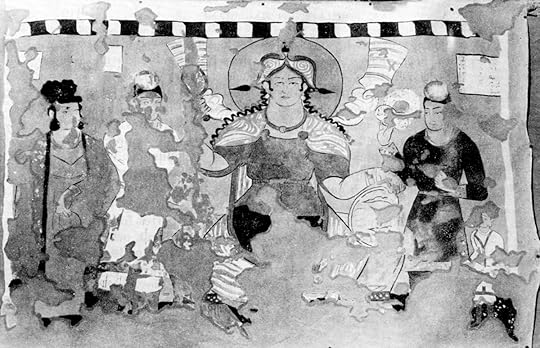 Dilberjin Tepe, Athena AnahitaFrescoe: 7th-8th century artist. Photographs: Irina Gruklikova - Fouilles de la Mission Archaeologique Sovieto-Afghane
Dilberjin Tepe, Athena AnahitaFrescoe: 7th-8th century artist. Photographs: Irina Gruklikova - Fouilles de la Mission Archaeologique Sovieto-AfghaneÎÎ ÎΣΠÎΣÎÎ Î'[5]
that the figure depicted on the terra-cottas is the same figure depicted on the Panjikent wall paintings.The Sogdian cithara player has been compared to the god Apollo,[27] but it is most unlikely that a Greek god appears on the terra-cottas on which a seated figure is shown playing this instrument. The Sogdian musicians are much closer to the many representations in Late Antique and early Byzantine art of a seated Orpheus [28] who, as a Thracian, was depicted by artists as a barbarian wearing garments resembling those of a Parthian or of the local nobility of Roman Syria.[5a1] In the early third century. Flavius Philostratus[5a2] described the image of Orpheus in Parthian Babylonia: "They are, by the way, favorably disposed toward Orpheus more for his tiara and wide trousers than for his skill in playing the cithara or singing, which had such an enchanting force. [29] A reinterpretation of this image in Judaic land (subsequently in early Christian) art as King David [30] facilitated the conversion of a seated cithara player in Oriental clothes into a Sogdian regal deity. The Sogdians learned about Christianity primarily from Nestorian missionaries [ÎÎΧΤ COLUMN] from the Sasanian Empire. Among the early Christians, Orpheus represented Christ, while David was a prototype of Christ. Occasionally Orpheus, seated on a throne in a royal Sasanian pose with splayed knees and surrounded with beasts and mythological monsters shown listening to him reverently, appears as the Almighty {Î ÎÎΤÎÎÎ¥ÎÎÎÎΣ}.[31] However, such compositions, which were not Christian images, were interpreted merely as allegories. Sogdians in search of iconographic images could turn to Orpheus imagery without fear of being mistaken for Christians. In doing so, the Sogdians not only emphasized the features that already resembled a Sasanian king in the prototype but also depicted a seated cithara player on a throne with elephant supports, [32] which, like all zoomorphic thrones of the gods, certainly carried a symbolic meaning. [33] In Sogdiana, each deity had a corresponding animal on which he might be shown riding; his throne might resemble the supine animal or he supported by such animals. All three variants are equivalent in Sogdian art, so that a zoomorphic throne may be regarded as similar to a vahana, the vehicle of an Indian god.
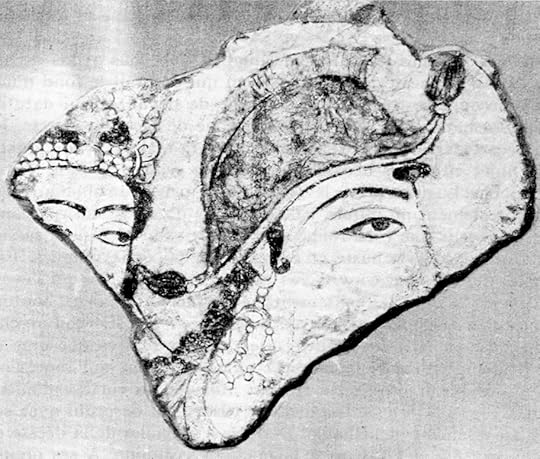 Dilberjin Tepe, Athena Anahita in profileFrescoe: 7th-8th century artist. Photographs: Irina Gruklikova ÎÎÎÎÎ - ANAHITA Ïε ÏοιÏογÏαÏία ÏÏο Dilberjin
Dilberjin Tepe, Athena Anahita in profileFrescoe: 7th-8th century artist. Photographs: Irina Gruklikova ÎÎÎÎÎ - ANAHITA Ïε ÏοιÏογÏαÏία ÏÏο DilberjinÎÎ ÎΣΠÎΣÎÎ Î'[6]As a matter of fact, the Sogdians equated their gods to the Indian gods and, for example, likened their own Adhag to Shakra (Indra), whose vahana was the elephant. [34] Such comparisons, reflected in Sogdian Buddhist texts, arose in a Buddhist environment, but the Panjikent representation of the god Veshparkar, identified with Mahadeva [Shiva], indicates that they also influenced the local non-Buddhist iconography. [35] Thus, the god with the cithara or lyre may be Adbag, equivalent to lndra, the Indian lord of the heavens, Ahura Mazda himself appears in Sogdian texts under the name of Adhag. [36] Could the cithara player in our mural be so exalted a deity? In scale he is larger than the supposed Vashagn and stands in front of him. The royal ribbons issue from his crown, and there are equally long ribbons on his boots, in contrast to the costume of Vashagn. Ribbons on boots of this type could have no functional purpose but instead must have been adopted from Sasanian costume as a royal attribute. Yet, could a god of so high a rank as Adhag be an intercessor before the four-armed goddess?Interpretation of the Northern Wall MuralThe obviously metaphorical trophy of Vashagn suggests that the painter depicted not the gods themselves but actors playing their parts. And here, the actor-gods are shown on a larger scale (close to that of the figure of the goddess) than the minor figures who portray mere mortals. There is no analogy in the royal costume to the strange ungirded clothes of "Adbag" cut at the lower edge into four long, pointed triangular pieces. Perhaps, like the varying buckles an the boots, they are specific details of an actor's attire, which could be rather extravagant, as demonstrated by the painting of Sogdiana and eastern Turkestan. An-other example is a garment with four triangular sections trimmed with bells at the lower edge..When creating their cultic iconography in the fifth-sixth centuries AD, the Sogdians turned to foreign models, of India and Greece (Silenus, Athena, Heracles, and others) and, occasionally, Kushan Tokharistan. All these models underwent change under the influence of Sasanian art, probably in areas controlled by the Kushano-Sasanians. This occurred both under the Sasanians and later, under the Kidarites and the Hephthalites, throughout the fourth-sixth centuries AD. From these sources came the poses of the enthroned goddesses, the typically Sasanian wavy ribbons, and other characteristics of cultic compositions. [37] However, despite these borrowings, the Sogdians pursued their own identity, representing in concrete, distinct depictions a multiplicity of gods worshiped by individual families and communities. Rather than portraying the major Buddhist, Christian, or Manichean images, they found it suitable to borrow the mi-
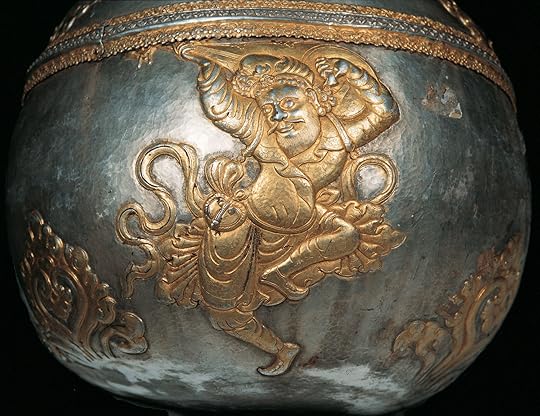 FIG. 3-6. Detail of Jug: figure playing pipa. Tibet or Sogdiana, 7thâ8th century. Silver with gilding, H. approx. 80 cm. Lhasa Jokhang, Tibet.
FIG. 3-6. Detail of Jug: figure playing pipa. Tibet or Sogdiana, 7thâ8th century. Silver with gilding, H. approx. 80 cm. Lhasa Jokhang, Tibet.ÎÎ ÎΣΠÎΣÎÎ Î'[7]
This series also includes the goddess on a lion,[71] the god on the camel throne,[72] and the goddess resembling Athena (the latter has been recorded in painting only in Tokharistan). [73] The Tokharistan mural from Dilbarjin with the goddess who resembles Athena, like the figures examined here, demonstrates an interpretation of the Classical heritage under the impact of Sasanian art.
Îη-Ïογδιανά ÏÏγανα, ÏÏÏÏ Î· ÎÎÎÎÎÎΣΤÎÎΠλÏÏα/κιθάÏα, αÏεικονίζονÏαι να ÏαίζονÏαι αÏÏ ÏÎ¿Ï Ï Î¸ÎµÎ¿ÏÏ, ÏιθανÏÏ Î±ÎºÏμη και αÏÏ Ïον ίδιο Ïον ÎÏοÏÏα ÎάζνÏα. ÎÏ Ïά Ïα ÏÏγανα και Ïο Î¹Î½Î´Î¹ÎºÏ ÏÏξο εμÏανίζονÏαι Ïε μεÏικά αÏÏ Ïα μεÏαγενÎÏÏεÏα ÎÏγα, δείÏνονÏÎ±Ï Ïην εÏιÏÏοή ÏÏν ÎÏÏμÏν ÏÎ¿Ï ÎεÏÎ±Î¾Î¹Î¿Ï ÏÏην ίδια Ïη Σογδιανή Î¼Î¿Ï Ïική.[10]ΣÎÎÎÎ ÎΡÎÎÎÎ¥ (ÎÎΠΤÎÎ ÎΠΩÎÎÎΠΤÎΣ Î ÎΡΣÎΦÎÎÎΣ ?) ÎΠΤÎÎ NANA & ΤÎÎ ÎÎÎÎΤΡΠÎΠΠΤÎÎΧÎÎΡÎΦÎΠΤÎÎ¥ ÎÎΡÎÎ¥ ÎΠΣΤΠPANJIKENT[15](Mourning Scene. Panjikent, Tajikistan, south wall of main hall of Temple II, Wall painting, 6th c. CE, The State Hermitage Museum, SA-16236)
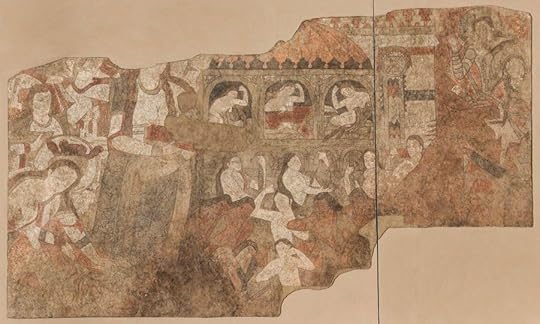
[image error] ΤοιÏογÏαÏία 'θÏÎ®Î½Î¿Ï ' αÏÏ Ïον νÏÏιο ÏοίÏο ÏÎ·Ï ÎºÏÏÎ¹Î±Ï Î±Î¯Î¸Î¿Ï ÏÎ±Ï ÏÎ¿Ï Î¹ÎµÏÎ¿Ï II[17]
ÎÏ Ïή η αÏοÏÏαÏμαÏική ÏοιÏογÏαÏία αÏÏ Ïην κÏÏια Î±Î¯Î¸Î¿Ï Ïα ÏÎ¿Ï ÎεÏÎ¿Ï II ÏÏο Panjikent είναι μια αÏÏ ÏÎ¹Ï Ïιο γνÏÏÏÎÏ Î±Î½Î±ÎºÎ±Î»ÏÏÎµÎ¹Ï Î±ÏÏ Ïα ÏÏÏÏα ÏÏÏνια ÏÎ·Ï ÏÏ ÏÏημαÏÎ¹ÎºÎ®Ï Î±Î½Î±ÏκαÏÎ®Ï ÏÎ·Ï ÏÏλεÏÏ ÏÏα ÏÎλη ÏÎ·Ï Î´ÎµÎºÎ±ÎµÏÎ¯Î±Ï ÏÎ¿Ï 1940. Îια ζÏηÏή και ÏολÏÏλοκη ÏÏνθεÏη αÏεικονίζει Ïον θÏήνο για Ïον νεκÏÏ, ο οÏÎ¿Î¯Î¿Ï [θÏήνοÏ] είναι οÏαÏÏÏ Î¼ÎÏα αÏÏ ÏÎ¹Ï ÏÏÎµÎ¹Ï ÏοξÏÏÎÏ ÎºÎ±Î¼Î¬ÏÎµÏ Î¼Î¹Î±Ï Î¸Î¿Î»ÏÏÎ®Ï ÎºÎ±ÏαÏÎºÎµÏ Î®Ï. Το ÏÏμα είναι ÎµÎ½Î´ÎµÎ´Ï Î¼Îνο ÏÏα κÏκκινα με μακÏιÎÏ ÏÏÎÏÎµÏ ÎºÎ±Î¹ ÏεÏίÏεÏνη κÏμμÏÏη. ÎÎÏα αÏÏ ÏÎ¹Ï ÎºÎ±Î¼Î¬ÏÎµÏ Î¼ÏοÏοÏμε εÏίÏÎ·Ï Î½Î± δοÏμε ÏÏÎµÎ¹Ï Î³Ï Î½Î±Î¯ÎºÎµÏ ÏÎ¿Ï Î¸ÏηνοÏν να ÏÎºÎ¯Î¶Î¿Ï Î½ Ïα μαλλιά ÏÎ¿Ï Ï, ÎµÎ½Ï Î±ÏÏ ÎºÎ¬ÏÏ Î¸ÏηνοÏν και άνδÏÎµÏ ÎºÎ±Î¹ Î³Ï Î½Î±Î¯ÎºÎµÏ, με ÏÎ¿Ï Ï Î¬Î½Î´ÏÎµÏ Î½Î± κÏÎ²Î¿Ï Î½ Ïα γÎνια ÏÎ¿Ï Ï. ΣÏα αÏιÏÏεÏά ÏÎ·Ï ÏÏ Î½Î¸ÎÏεÏÏ ÎµÎ¼ÏανίζονÏαι ÏÏÎµÎ¹Ï Î¼ÎµÎ³Î±Î»ÏÏεÏÎµÏ Î¼Î¿ÏÏÎÏ. ΠμεγαλÏÏεÏη είναι μια ÏÏθια θεά με ÏÏÏοÏÏÎÏανο, με ÏÎÏÏεÏα ÏÎÏια, δηλαδή η NANA, ÏÏα δεξιά ÏηÏ, μια άλλη μοÏÏή με ÏÏÏοÏÏÎÏανο, ÏÎ¿Ï Î´ÎµÎ½ ÎÏει ακÏμη αναγνÏÏιÏÏεί, γοναÏίζει και ÏαίνεÏαι να ÏÎºÎ¿Ï Ïίζει Ïο ÎδαÏÎ¿Ï Î¼ÏÏοÏÏά ÏÏη ÏÏθια θεÏÏηÏα. ΠίÏÏ ÏÎ¿Ï Ï ÏÏÎκεÏαι μια ÏÏίÏη μοÏÏή, με Ïο αÏιÏÏεÏÏ ÏÎ·Ï ÏÎÏι ÏηκÏμÎνο και Ïο δεξί να κÏαÏά άγνÏÏÏο ανÏικείμενο.[20]ΣÎÎÎÎΩΣÎ: Πμή αναγνÏÏιÏθείÏα [ÏÏμÏÏνα με Ïην ÎÎ¿Ï Î´Î®Î¸ Judith A. Lerner & Ïο ÎδÏÏ Î¼Î± Îεβή - Leon Levy Foundation - γνÏÏÏÏ ÏÏ Ï ÏοÏÏηÏίξαν Ïον CίÏÏα ..] ÏÎ±Ï ÏοÏοιείÏαι ÏÏμÏÏνα με ÏÎ¿Ï Ï Frantz Grenet; & Samra Azarnoush [Where are the Sogdian Magi?] με Ïην Îλληνίδα θεά ÎÎÎÎΤΡÎ! ÎλλÏÏÏε Ïο Ïνομα ÏÎ·Ï ÎήμηÏÏÎ±Ï ÎÏει ÏιÏÏοÏοιηθεί ÏÏι εÏÏηÏιμοÏοιείÏο αÏÏ Î£Î¿Î³Î´Î¹Î±Î½Î¿ÏÏ ÏÏ Î¸ÎµÎ¿ÏοÏικÏ. Î .Ï. Ïο Ïνομα Jimatvande, γνÏÏÏÏ Î£Î¿Î³Î´Î¹Î±Î½Ï Ïνομα Ïημαίνει Ïον 'Ï ÏηÏÎÏη ÏÎ·Ï ÎήμηÏÏαÏ"
-------------------------------------------------------------------------------
Zymtyc, the 11th month of the Sogdian calendar, is named after a god Zymt, who is mentioned in the name Shewupantuo (29) (*dźi̯a mi̯uÉt bÊ»uân dʻâ; Ikeda, 1965, p. 64) = zymt-βntk. In the light of its Bactrian counterpart drÄmatigano, Sims-Williams (2000, p. 190) proves that the god originated from the Greek earth goddess Demeter. A Middle Persian loanword for âTuesdayâ is found in the name Wenhan (30) (*ËËuÉn xân, cf. British Library MS S. 542, line 74; Ikeda, 1979, p. 537) = wnxʾn.[30]
Το Zymtyc, ο 11Î¿Ï Î¼Î®Î½Î±Ï ÏÎ¿Ï Î£Î¿Î³Î´Î¹Î±Î½Î¿Ï Î·Î¼ÎµÏÎ¿Î»Î¿Î³Î¯Î¿Ï , ÏήÏε Ïο Ïνομά ÏÎ¿Ï Î±ÏÏ Îναν Î¸ÎµÏ Zymt, ο οÏÎ¿Î¯Î¿Ï Î±Î½Î±ÏÎÏεÏαι ÏÏο Ïνομα Shewupantuo (29) (*dźi̯a mi̯uÉt bÊ»uân dʻâ; Ikeda, 1965, Ïελ. 64) = zymt-βt. Î¥ÏÏ Ïο ÏÏÏ ÏÎ¿Ï Î±Î½ÏίÏÏοιÏÎ¿Ï ÏÎ·Ï ÎακÏÏÎ¹Î±Î½Î®Ï drÄmatigano, ο Sims-Williams (2000, Ï. 190) αÏοδεικνÏει ÏÏι ο θεÏÏ ÏÏοÎÏÏεÏαι αÏÏ Ïην ελληνική θεά ÏÎ·Ï Î³Î·Ï ÎήμηÏÏα. Encyclopaedia Iranica, s.v. PERSONAL NAMES, SOGDIAN i. IN CHINESE SOURCES
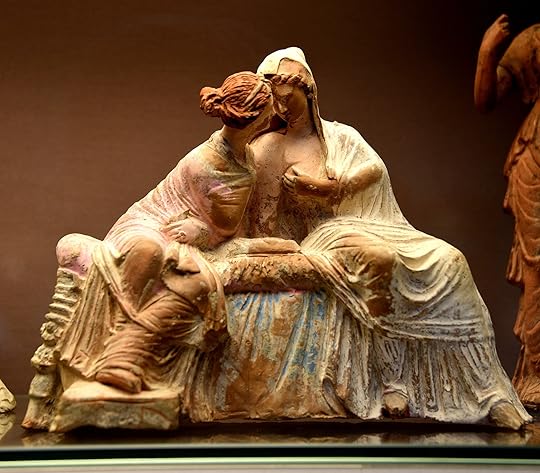 ÎεÏÎ±Î¼ÎµÎ¹ÎºÏ ÏÏμÏλεγμα δÏο καθήμενÏν γÏ
ναικÏν, ÏιθανÏÏ ÎήμηÏÏÎ±Ï - ΠεÏÏεÏÏνηÏ[32]
ÎεÏÎ±Î¼ÎµÎ¹ÎºÏ ÏÏμÏλεγμα δÏο καθήμενÏν γÏ
ναικÏν, ÏιθανÏÏ ÎήμηÏÏÎ±Ï - ΠεÏÏεÏÏνηÏ[32]----------------------------This fragmentary wall painting from the main hall of Temple II in Panjikent is one of the best-known discoveries from the early years of systematic excavation of the city in the late 1940s. A vivid and complex composition depicts the lamentation for the deceased, who is visible through the three arches of a domed structure. The body is dressed in red with long tresses and an elaborate headdress. Through the arches we can also see three mourning women tearing their hair; below, men and women also mourn, with the men cutting their beards. To the left of the composition appear three larger figures. The largest is a standing, haloed, four-armed goddess; to her right, another haloed figure, yet to be identified, kneels and seems to sweep the ground in front of the standing deity. Behind them stands a third figure, her left arm raised and her right holding an unidentified object.[40]----------------Finally, there were elements foreign to the Iranian religion, nevertheless integrated into the festive calendar: the Mesopotamian cult of Ishtar, called Nana in Central Asia, and a surprising discovery made in recent years, a CULT OF DEMETER associated with the cult of Ishtar in seasonal celebrations. This transplantation of the mysteries of Eleusis can only be identified as a legacy of the Greek era, even if no Greek coin from Bactria includes the image of the associated divinities...[45]-------------THE OHIO STATE UNIVERSITY: An Introduction to Uzbekistan ... Although much of what we know about Zoroastrianism today was codified by the Sasanians, it is likely that the religion that the Sogdians and other Central Asian peoples practiced was a slightly broader version of old Iranian religion, which included the worship of the god Ahura Mazda, and at times included worship of the Greek goddess Demeter and the Hindu god Shiva.[50]---------------------------------7 Luckily the epitaph of a Sogdian with the same clan name Shi å², likely representing their original city-state Kish in Central Asia, contained a segment inscribed in Sogdian that cited a personal name δrymtβntk/ ŽÄmatvande, which according to Yutaka Yoshida was, if not the same å°å¿æ§é, at least a namesake. 38 Nicholas Sims-Williams further interprets the Sogdian name as âslave of Demetra.â 39 The deity Demetra/Demeter, representing the eleventh month of the Sogdian and Bactrian calendars, was originally the Greek goddess of agriculture, which makes this acase of Sino-Greco-Sogdian cultural fusion in the medieval Chinese onomasticon, adding a Hellenistic touch to the Iranization of Chinese nomenclature.[55]
--------------------Î ÏεÏίÏημη 'Ïκηνή ÏÎ¿Ï Î¸ÏÎ®Î½Î¿Ï ' ÏÎ¿Ï ÏεÏιλαμβάνεÏαι ÏÏον ζÏγÏαÏÎ¹ÎºÏ Î´Î¹Î¬ÎºÎ¿Ïμο ÏÎ·Ï ÏεÏÏάÏÏÏ Î»Î·Ï Î±Î¯Î¸Î¿Ï ÏÎ±Ï ÏÎ¿Ï ÎεÏÏ II ÏÏο Panjikent ÏÏονολογείÏαι αÏÏ Ïον 6ο αι. ÎνακαλÏÏθηκε Ïο 1948 και εÏανεξεÏάζεÏαι Ï ÏÏ Ïο ÏÏίÏμα ÏÏÏÏÏαÏÎ·Ï ÎÏÎµÏ Î½Î±Ï. Î ÏεÏÏάÏειÏη θεά ÏÎ¿Ï Î±Î½Î±Î»Î±Î¼Î²Î¬Î½ÎµÎ¹ Ïον κÏÏιο ÏÏλο ÏÏοÏδιοÏίÏÏηκε αÏÏ Ïην αÏÏή οÏθÏÏ ÏÏ Î· Îανά, αλλά Ïο θεμελιÏδÏÏ Î¼ÎµÏοÏοÏÎ±Î¼Î¹Î±ÎºÏ Ï ÏÏÏÏÏÏμα ÏÎ¿Ï ÏελεÏÎ¿Ï ÏÎ³Î¹ÎºÎ¿Ï ÏÎ¿Ï Î±ÏεικονίζεÏαι ÏÏη ÏÏνθεÏη ÏαίνεÏαι Ïιο καθαÏά αÏÏ Î¼Î¹Î± ενδελεÏή Î±Î½Î¬Î»Ï Ïη δÏο ÏÏεÏικÏν κειμÎνÏν: Ïα ÎÏομνημονεÏμαÏα ÏÎ¿Ï ÎινÎÎ¶Î¿Ï Î±ÏεÏÏαλμÎÎ½Î¿Ï Wei Tsie (ÏÎ¿Ï Ïο ÏεÏιγÏάÏει ÏÏην ΣαμαÏκάνδη, με ÏαÏή αναÏοÏά ÏÏο Tammuz) και Ïο ÏÎ¿Î»ÎµÎ¼Î¹ÎºÏ Î¼Î±Î½Î¹ÏαÏÏÏÎ¹ÎºÏ Î±ÏÏÏÏαÏμα M 549 (ÏÎ¿Ï Ïο καÏαδικάζει). Σε ανÏίθεÏη με Ïη ÏÏ Ïνή ÏεÏοίθηÏη, η ξαÏλÏμÎνη ÏÏÏÏÏ ÏÎ¬Î½Ï ÏÏο οÏοίο θÏηνοÏν η θεά και οι άνδÏÎµÏ ÎµÎ¯Î½Î±Î¹ Î±Ï ÏÏ Î¼Î¹Î±Ï Î½ÎµÎ±ÏÎ¬Ï Î³Ï Î½Î±Î¯ÎºÎ±Ï. Î ÏÏκειÏαι καÏά ÏάÏα ÏιθανÏÏηÏα για Ïην Gestinanna, αδελÏή ÏÎ¿Ï Tammuz, η οÏοία ÏÏον μÏθο ÏÎ·Ï ÎεÏοÏοÏÎ±Î¼Î¯Î±Ï Î±Î½ÏικαθιÏÏά Ïον αδελÏÏ ÏÎ·Ï ÏÏον κάÏÏ ÎºÏÏμο αÏκεÏοÏÏ Î¼Î®Î½ÎµÏ Ïον ÏÏÏνο. ΣÏην Σογδιανή εκδοÏή η εικÏνα ÏÎ·Ï ÎµÎ¯Ïε ίÏÏÏ ÏÏ Î³ÏÏÎ½ÎµÏ Î¸ÎµÎ¯ με Î±Ï Ïήν ÏÎ·Ï Î ÎµÏÏεÏÏνηÏ, καθÏÏ Î¼Î¹Î± νÎα ανάγνÏÏη ÏÎ¿Ï Î¼Î±Î½Î¹ÏαÏÏÏÎ¹ÎºÎ¿Ï ÎºÎ¿Î¼Î¼Î±ÏÎ¹Î¿Ï Î±ÏÏ Ïον Î. ΣιμÏ-ÎÎ¿Ï Î¯Î»Î¹Î±Î¼Ï Î´ÎµÎ¯Ïνει Ïην ÎήμηÏÏα να ÏÏ Î½Î±Î½Î±ÏÏÏÎÏεÏαι με Ïη Îανά ÏÏο ÏÎνθοÏ. ΤÎλοÏ, μεÏικά άλλα εικονιÏÏικά ÎγγÏαÏα αÏÏ Ïην Σογδιανή και Ïην ÎακÏÏία δείÏÎ½Î¿Ï Î½ Ïην Îανά να ÏÏεÏίζεÏαι με Îναν Î¸ÎµÏ ÏοξÏÏη. Î ÏοÏείνεÏαι να ÏÎ±Ï ÏιÏÏεί με Ïον Tistrya-Tir, ÎÏÎ±Î½Ï Î¸ÎµÏ ÏÎ¿Ï ÏλανήÏÎ¿Ï ÎÏμοÏ, ο οÏÎ¿Î¯Î¿Ï ÎµÎ¯Ïε αναλάβει ÏÎ¹Ï Î»ÎµÎ¹ÏÎ¿Ï ÏÎ³Î¯ÎµÏ ÏÎ¿Ï ÎÎ±Î²Ï Î»ÏÎ½Î¹Î±ÎºÎ¿Ï Nabu, Î¸ÎµÎ¿Ï ÏÎ·Ï Î³ÏαÏήÏ, ÏÎ·Ï ÎµÎ³Î³ÏαμμαÏοÏÏÎ½Î·Ï ÎºÎ±Î¹ ÏÎ·Ï ÎµÏιÏÏήμηÏ. ---------------------------------------------------------------------------------The famous "scene of mourning" included in the painted decoration of the tetrastyle hall of Temple II at Panjikent dates from the VIth c. A.D. Discovered in 1948, it is reexamined in the light of recent research. The four-armed goddess who assumes the main role was from the beginning correctly identified as Nana, but the fundamentally Mesopotamian substratum of the ritual depicted in the composition appears more clearly from a thorough analysis of two relevant texts : the Memoir of theChinese envoy Wei Tsie (who describes it at Samarkand, with a clear reference to Tammuz) and the polemical Manichaean fragment M 549 (which condemns it). Contrary to frequent belief, the lying corpse upon which the goddess and the men are lamenting is that of a young lady. She is in all probability Gestinanna, Tammuz 's sister, who in the Mesopotamian myth replaces her brother in the underworld several months a year. In Sogdiana her image had perhaps fused with that of Persephone, as a new reading of the Manichaean fragment by N. Sims-Williams shows Demeter associate with Nana in the mourning. Lastly, some other figurative documents from Sogdiana and Bactria show Nana associated with an archer god. It is proposed to identify him as Tistrya-Tir, the Iranian god of the planet Mercury, who had assumed the functions of Babylonian Nabu.[60]---------------------The Hellenistic cultural factor continues in acceptance and imitation. The ancient city of Pianchi Kent [Pendjikent], built in the 5th century AD, is relatively well preserved. Although more than 6 centuries have passed since the end of the Greek rule in the mid-2nd century BC, both the architectural style and the content of the murals are of Hellenistic culture. The strong proof of the remains of Sogdiana proves the continuation of Hellenistic cultural factors in Sogdiana, and the Hellenistic cultural factors are mainly manifested in the use of some details and image forms.The appearance of the story of Aesop's Fables on the frescoes is an example of Sogdiana's Hellenistic influence. Room 41/6 reflects the 53rd fable in Aesop's Fables, Father and Son, depicting a father admonishing his sons that brothers are like a bundle of sticks, if together they are It is not easy to take apart, but if they are independent, they are easily defeated by the enemy. Room 1/21 reflects the fables "The Goose Laying the Golden Egg" and "The Lion and the Rabbit". There are other examples of classical themes in the frescoes, but some are unclear in imagery, and some may be completely Sogdian in the costumes, so it is difficult to discern.On the frescoes on the north wall of the hall, there is a picture of "Feasting Figures", which depicts "four people sitting in pairs, wearing knee-length silk robes, sitting on a splendid blanket, holding golden Laitong cups, some of which are horn cups. Bird heads, some blue sheep. One holds a bouquet of flowers with bare hands, the other wears a fur hat with colorful fringing, watching the flower bearer. Another is turning his head back, holding up a The wine in his hand is pouring from the corner glass, and it just falls into the mouth." The Greek god Demeter appears in the fresco mourning scene, and Demeter also{see figure below!}The form appears in the Sogdian calendar and is used to denote the month of November. In addition to the above-mentioned Hellenistic features, the figurative and pictorial features on the walls are also part of the Hellenistic cultural heritage. The heads of the figures on the frescoes show a typical three-quarter scale, with a certain distance between the figures and less overlap. Mural art uses the "Boundary Breaking Method", that is, "the wall is divided up and down into long strips of painting to strengthen the horizontal movement space produced by the horizontal visual effect. This 'Boundary Breaking Method' is sometimes more subtle, limited to the top of the character's head and the The subtle details of the soles of the feet superimpose the figures' heads and feet on the top and bottom borders of the picture, creating a feeling of going beyond the borders." The murals are arranged in left-to-right or right-to-left order. If the content is in the upper and lower rows, the lower row is from left to right, and the upper row is from right to left, and vice versa. This order not only makes the mural content look vivid, but also facilitates the painter's operation. This method is similar to the spelling rules of early Greek and is called "Boustrophedon" (Greek). ÎÎΥΣΤΡÎΦÎÎÎÎ For the overall silhouette, painters generally tend to use convex curves (Convex curves), combined with ochre color (Ochre), to express a strong reality. The pictorial features of Chiaroscuro and Without Shadows are prevalent in Sogdiana frescoes. This Greek-Sogdian pictorial character and artistic approach emerged in the centuries following the end of Hellenistic rule, and in itself reflects the far-reaching influence of Hellenism.[65]
 The form appears in the Sogdian calendar and is used to denote the month of November[67]------------------------------Studies by B. I. Marshak and F. Grene showed that the four-armed goddess, who plays the main role in the mural composition âLamentationâ, was correctly identified as Nana from the very beginning. At the same time, the Mesopotamian basis of the ritual depicted in the composition clearly manifested itself after studying the notes of Wei Jie and the Sogdian Manichaean fragment M 549. As can be judged from these written sources, the rite of mourning, which is known in the Near Asian myth of Tammuz, is led by âLady Nanaâ. On the mural, Nana, along with other gods and people, mourns a girl who could be Geshtinanna (Belili), the sister of Tammuz, or Persephone, the daughter of Demeter. In Mesopotamian myth Geshtinanna replaces Tammuz every year for several months. In Sogd, the image of Geshtinanna could merge with the image of Persephone. According to N. Sims-Williams, the Greek name of Demeter in his Sogdian adaptation Zhimat is mentioned in the text M 549, and this theonym could have penetrated into Sogdian from the Bactrian language.The Sogdian deity Takhsich was associated with Nana, whose name, according to the etymology proposed by K. Tremblay, means "Returning". Perhaps, as V. B. Henning suggested, Takhsich is the Sogdian hypostasis of Tammuz, who annually returns to earth. It is also possible that Takhsich is an epithet that replaces the main name of the deity. In Sogdian iconography, Nana has many companions, one of the most important being the deity with an arrow in his hand. This image reminiscent of a play on words in Middle Persian - mir - âarrowâ and Tir (i) - the name of the Near Asian deity and the name of the planet Mercury, as well as the name of the deity, often identified with the Avestan Tishtriya, the genius of the star Sirius and the deity rain (Grenet, Marshak 1998, pp. 5â18). This interpretation once again showed the complexity of the tasks facing the researcher studying the ambiguous and multifaceted Sogdian paintings. B. I. Marshak solved such problems more than once with brilliance thanks to attention to detail, his erudition and the ability to see a well-known fact from a new perspective, which always led to unexpected discoveries in the history of culture. This was the essence of the researcher's method.[70]Thus, from small pieces, combining the reconstructing of figures from small details, analogies and logical analysis he solved the âjigsaw-puzzleâ of a painting in XXVI/3, the depiction of a festival with dancers, acrobats, masters of puppets, Dionysian mysteries and exposition of figures of gods.[72]
The form appears in the Sogdian calendar and is used to denote the month of November[67]------------------------------Studies by B. I. Marshak and F. Grene showed that the four-armed goddess, who plays the main role in the mural composition âLamentationâ, was correctly identified as Nana from the very beginning. At the same time, the Mesopotamian basis of the ritual depicted in the composition clearly manifested itself after studying the notes of Wei Jie and the Sogdian Manichaean fragment M 549. As can be judged from these written sources, the rite of mourning, which is known in the Near Asian myth of Tammuz, is led by âLady Nanaâ. On the mural, Nana, along with other gods and people, mourns a girl who could be Geshtinanna (Belili), the sister of Tammuz, or Persephone, the daughter of Demeter. In Mesopotamian myth Geshtinanna replaces Tammuz every year for several months. In Sogd, the image of Geshtinanna could merge with the image of Persephone. According to N. Sims-Williams, the Greek name of Demeter in his Sogdian adaptation Zhimat is mentioned in the text M 549, and this theonym could have penetrated into Sogdian from the Bactrian language.The Sogdian deity Takhsich was associated with Nana, whose name, according to the etymology proposed by K. Tremblay, means "Returning". Perhaps, as V. B. Henning suggested, Takhsich is the Sogdian hypostasis of Tammuz, who annually returns to earth. It is also possible that Takhsich is an epithet that replaces the main name of the deity. In Sogdian iconography, Nana has many companions, one of the most important being the deity with an arrow in his hand. This image reminiscent of a play on words in Middle Persian - mir - âarrowâ and Tir (i) - the name of the Near Asian deity and the name of the planet Mercury, as well as the name of the deity, often identified with the Avestan Tishtriya, the genius of the star Sirius and the deity rain (Grenet, Marshak 1998, pp. 5â18). This interpretation once again showed the complexity of the tasks facing the researcher studying the ambiguous and multifaceted Sogdian paintings. B. I. Marshak solved such problems more than once with brilliance thanks to attention to detail, his erudition and the ability to see a well-known fact from a new perspective, which always led to unexpected discoveries in the history of culture. This was the essence of the researcher's method.[70]Thus, from small pieces, combining the reconstructing of figures from small details, analogies and logical analysis he solved the âjigsaw-puzzleâ of a painting in XXVI/3, the depiction of a festival with dancers, acrobats, masters of puppets, Dionysian mysteries and exposition of figures of gods.[72]ΣÎÎÎÎΩΣÎÎΣ
[5]. Marshak and Raspopova 1994, p. 197.[5a1]. ΠΣογδιανÏÏ ÎºÎ¹Î¸Î±ÏÏδÏÏ ÎÏει ÏÏ Î³ÎºÏιθεί με Ïον Î¸ÎµÏ ÎÏÏλλÏνα, αλλά είναι ÏÎ¿Î»Ï Î±Ïίθανο ÎÎ½Î±Ï ÎÎ»Î»Î·Î½Î±Ï Î¸ÎµÏÏ Î½Î± εμÏανίζεÏαι ÏÏα κεÏαμεικά ÏÏα οÏοία εμÏανίζεÏαι μια καθιÏÏή μοÏÏή να Ïαίζει Î±Ï ÏÏ Ïο ÏÏγανο. Îι Σογδιανοί Î¼Î¿Ï Ïικοί είναι ÏÎ¿Î»Ï Ïιο κονÏά ÏÏÎ¹Ï ÏολλÎÏ Î±Î½Î±ÏαÏαÏÏάÏÎµÎ¹Ï ÏÏην ÎÏÏεÏη ÎÏÏαιÏÏηÏα και Ïην Î ÏÏιμη ÎÏ Î¶Î±Î½Ïινή ÏÎÏνη ενÏÏ ÎºÎ±Î¸Î¹ÏÏÎ¿Ï ÎÏÏÎÏÏ Î¿ οÏοίοÏ, ÏÏ ÎÏακιÏÏηÏ, αÏεικονιζÏÏαν αÏÏ ÎºÎ±Î»Î»Î¹ÏÎÏÎ½ÎµÏ ÏÏ Î²Î¬ÏβαÏÎ¿Ï ÏÎ¿Ï ÏοÏοÏÏε ενδÏμαÏα ÏÎ¿Ï Î¼Î¿Î¹Î¬Î¶Î¿Ï Î½ με εκείνα ενÏÏ Î Î¬ÏÎ¸Î¿Ï Î® ÏÏν ÏοÏικÏν ÎµÏ Î³ÎµÎ½Ïν ÏÎ·Ï Î¡ÏμαÏÎºÎ®Ï Î£Ï ÏίαÏ. [5a2]. Greek sophist of the Roman period Athens.[6]. Marshak and Raspopova 1994, p. 198.[7]. Marshak and Raspopova 1994, p. 202.[10]. Furniss, I. THE SOGDIANS.[15]. Mourning Scene. Panjikent, Tajikistan, south wall of main hall of Temple II, Wall painting, 6th c. CE, The State Hermitage Museum, SA-16236.[17]. pl. 6 in p. 156 of: V. G. Skoda (St. Petersburg)[20]. de la Vaissière 2003.[30]. Encyclopaedia Iranica, s.v. PERSONAL NAMES, SOGDIAN i. IN CHINESE SOURCES.[32]. Terracotta group of two seated women, perhaps Demeter and her daughter Persephone. Made at Myrina, north-west Asia-Minor (????), circa 180 BCE. Said to be from Asia-Minor. (The British Museum 1885,0316.1).[40]. ICOSMOS. Spring 2021.[45]. Grenet 2013.[50]. The Ohio State University.[55]. Sanping Chen 2019, p. 423.[60]. Grenet and Marshak 1998[65]. Qi Xiaoyan 2022.[67]. Qi Xiaoyan 2022.[70]. Shkoda 2013, pp. 156-157.[72]. Shkoda 2013, pp. 484.
ÎÎÎÎÎÎÎΡÎΦÎÎhttps://www.jstor.org/stable/24048774
Marshak, B. I. and V. I. Raspopova. 1994. "Worshipers from the Northern Shrine of Temple II, Panjikent," Bulletin of the Asia Institute (New Series) 8 (The Archaeology and Art of Central Asia Studies From the Former Soviet Union), pp. 187-207.
https://sogdians.si.edu/sidebars/retr..., I. THE SOGDIANS Influencers on the Silk Roads. RETRACING THE SOUNDS OF SOGDIANA. Online exhibition by the Freer Gallery of Art and Arthur M. Sackler Gallery, Smithsonian Institution.
https://dnkonidaris.blogspot.com/2022...
https://www.academia.edu/35720137/Div..., A. 2017. "Divine and Human Figures on the Sealings Unearthed from Kafir-kala," Japan Society for Hellenistic-Islam Archaeological Studies 24, pp. 203-212.
https://www.jstor.org/stable/24048351..., B., and V. Solov'ev. 1990. "The Architecture and Art of Kafyr Kala (Early Medieval Tokharistan)," Bulletin of the Asia Institute 4 (In honor of Richard Nelson Frye: Aspects of Iranian Culture), pp. 61-75. p. 61:
https://www.jstor.org/stable/24048767..., G. V. 1994. "Ancient Samarkand: Capital of Soghd," Bulletin of the Asia Institute, New Series 8 (The Archaeology and Art of Central Asia Studies From the Former Soviet Union), pp. 81-99.
https://www.academia.edu/36102643/_Th..., M. 2017. "The Religion and the Pantheon of the Sogdiands (5thâ8th centuries CE) in Light of their Sociopolitical Structures,â Journal Asiatique 2017/2, pp. 191-209.
https://archive.org/details/legendsta..., B. 2002. Legends, Tales, and Fables in the Art of Sogdiana, New York.
https://www.academia.edu/23521408/%D0... of the State Hermitage Museum LXII. Sogdians, their precursors, contemporaries and heirs, Based on proceedings of conference âSogdians at Home and Abroadâheld in memoryof Boris Ilâich Marshak (1933â2006), St. Petersburg The State Hermitage Publishers 2013
https://www.jstor.org/stable/24048897..., B. I. 1996. "The Tiger, Raised from the Dead: Two Murals from Panjikent," Bulletin of the Asia Institute, New Series 10 (Studies in Honor of Vladimir A. Livshits), pp. 207-217.
https://www.jstor.org/stable/24048903..., V. G. 1996. "Fifty Years of Archaeological Exploration in Panjikent," Bulletin of the Asia Institute, New Series 10 (Studies in Honor of Vladimir A. Livshits), pp. 259-264.
https://www.persee.fr/doc/arasi_0004-... Grenet, F. and B. Marshak. 1998. "Le mythe de Nana dans l'art de la Sogdiane," Arts Asiatiques 53, pp. 5-18.
http://www.silkroadfoundation.org/new... la Vaissière, E. 2003. "Sogdians in China," The Silk Road 1 (2), pp. 23-27.
ICOSMOS. Spring 2021. Serial Transnational Nomination For World Heritage of Silk Roads, <http://www.iicc.org.cn/UserFiles/Arti...
https://www.academia.edu/24470615/Whe..., S., and F. Grenet. 2007. "Where Are the Sogdian Magi?," Bulletin of the Asia Institute (New Series) 21, pp. 159-177.
Grenet, F. 2013. "Refocusing Central Asia. Inaugural Lecture delivered on Thursday 7 November 2013. <https://books.openedition.org/cdf/429...
The Ohio State University. "An Introduction to Uzbekistan," The Ohio State University, <https://u.osu.edu/uzbekistan/history/... (11 Sept. 2022).
https://www.jstor.org/stable/10.7817/... Chen. 2019. â'Godly Worm' and the 'Literati Prism' of Chinese Sources," Journal of the American Oriental Society 139.2, pp. 417-431.
https://www.academia.edu/23521408/%D0..., V. G. 2013. "Boris Marshak and Panjikent Painting (Researcher's Method)," in Sogdians, their precursors, contemporaries and heirs , St. Petersburg (The State Hermitage Publishers), pp. 147-158.
https://www.academia.edu/24461082/Le_..., F. and B. Marshak. 1998. "Le mythe de Nana dans l'art de la Sogdiane," Arts Asiatiques 53, pp. 5-18.
https://inf.news/en/travel/9871506597... Xiaoyan. 2022. "Frontier Time and Space, The introduction and continuation of Hellenistic culture in the ancient city of Sogdiana," <https://inf.news/en/travel/9871506597... (11 Sept. 2022).
Î ÎÎÎΠΠΡÎΣΦÎΤÎΣ ÎÎÎ ÎÎΥΤÎΣÎÎΣ - ÎÎ ÎÎÎÎÎÎÎ: 110922
September 9, 2022
THE ARCHIMEDES CODEX, Netz & Noel
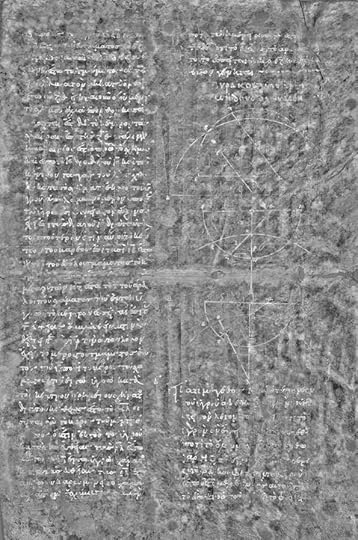
ΠΡεβίλ ÎεÏÏ Î´ÎµÎ½ ÏίÏÏÎµÏ Îµ ÏÏα μάÏια ÏÎ¿Ï ÏÏαν άνοιξε Ïο e-mail ÏÎ¿Ï Î¼Î¹Î± μÎÏα ÏÎ¿Ï 1998. ÎαιÏÏ ÏÏÏα εÏοίμαζε μια νÎα μεÏάÏÏαÏη και ÎκδοÏη ÏÎ»Î¿Ï ÏÎ¿Ï ÎÏÎ³Î¿Ï ÏÎ¿Ï ÎÏÏιμήδη, και η ÏημανÏικÏÏεÏη Ïηγή κειμÎνÏν ÏÎ¿Ï ÏÎ¿Ï ÎλειÏε ήÏαν Îνα γνÏÏÏÏ Î±Î»Î»Î¬ ÏαμÎνο Î²Ï Î¶Î±Î½ÏÎ¹Î½Ï ÏαλίμÏηÏÏο. Το ηλεκÏÏÎ¿Î½Î¹ÎºÏ Î³Ïάμμα Îλεγε ÏÏι Ïο ÏολÏÏιμο Î±Ï ÏÏ ÏειÏÏγÏαÏο είÏε αίÏÎ½Î·Ï ÎµÎ¼ÏανιÏÏεί. Îαι ήÏαν ÎÏοιμο να βγει Ïε δημοÏÏαÏία ÏÏν ÎÏίÏÏÎ¹Ï ÏÏη ÎÎα Î¥ÏÏκη...ΣÏον ÎÏδικα ÏÎ¿Ï ÎÏÏÎ¹Î¼Î®Î´Î¿Ï Ï, ο ÎεÏÏ, μαζί με Ïον ÎÎ¿Ï Î¯Î»Î¹Î±Î¼ ÎοÎλ, ÎÏοÏο ÏÎ¿Ï Î¼Î¿Ï ÏÎµÎ¯Î¿Ï ÏÏο οÏοίο καÏÎληξε Ïο ÏαλίμÏηÏÏο μεÏά Ïην αγοÏά ÏÎ¿Ï ÎνανÏι 2.000.000 δολαÏίÏν αÏÏ Î¬Î³Î½ÏÏÏο ÏλειοδÏÏη (ÏημειÏÏÎον ÏÏι ÏÏη δημοÏÏαÏία ÏήÏε μÎÏÎ¿Ï ÏÏÏÎ¯Ï ÎµÏιÏÏ Ïία και Ïο ÎµÎ»Î»Î·Î½Î¹ÎºÏ ÎºÏάÏοÏ), ÏαÏÎ±ÎºÎ¿Î»Î¿Ï Î¸Î¿Ïν Ïο αÏίÏÏÎµÏ Ïο Ïαξίδι Î±Ï ÏÎ¿Ï ÏÎ¿Ï Î±ÏÏÎ±Î¯Î¿Ï ÎºÏδικα αÏÏ Ïη γÎννηÏή ÏÎ¿Ï Ï' Îνα μοναÏÏήÏι ÏÎ·Ï ÎÏνÏÏανÏινοÏÏÎ¿Î»Î·Ï ÎºÎ±Î¹ Ïην εξοÏία ÏÎ¿Ï ÏÏÎ¿Ï Ï ÎÎ³Î¯Î¿Ï Ï Î¤ÏÏÎ¿Ï Ï ÎºÎ±Î¹ ÏÏην εμÏÏλεμη ÎÏ ÏÏÏη, μÎÏÏι Ïην ÏÏÏÏÏαÏη εÏανεμÏάνιÏή ÏÎ¿Ï ÏÏÎ¹Ï ÎÎ Î. ΣÏη διαδÏομή Î±Ï Ïή, ÎÏονÏÎ±Ï Î±Î½Î±ÎºÏ ÎºÎ»Ïθεί Ïαν ÏÏοÏÎµÏ ÏηÏάÏιο γÏαμμÎνο ÏÎ¬Î½Ï ÏÏο αÏÏαίο κείμενο, Ï ÏÎÏÏη ÏοβαÏÎÏ ÏθοÏÎÏ ÎºÎ±Î¹ Îμεινε ξεÏαÏμÎνο Ïε Î²Î¹Î²Î»Î¹Î¿Î¸Î®ÎºÎµÏ ÎºÎ±Î¹ Ï ÏÏγεια. ΣήμεÏα, ÏάÏη Ïε μια ενÏÏ ÏÏÏιακή διεθνή ÏÏ Î½ÎµÏγαÏία ÏÎ¿Ï ÏεÏιλαμβάνει ÏÏ Î½ÏηÏηÏÎÏ ÏειÏογÏάÏÏν, ειδικοÏÏ ÏÎ·Ï Î·Î»ÎµÎºÏÏÎ¿Î½Î¹ÎºÎ®Ï Î±ÏεικÏνιÏηÏ, κλαÏικοÏÏ ÏιλολÏÎ³Î¿Ï Ï ÎºÎ±Î¹ ÏÏγÏÏÎ¿Î½Î¿Ï Ï Î¼Î±Î¸Î·Î¼Î±ÏικοÏÏ, Ïα ÏαμÎνα κείμενα και ÏÏεδιαγÏάμμαÏα ÏÎ¿Ï ÎÏÏιμήδη ÎÏÏονÏαι εÏιÏÎÎ»Î¿Ï Ï ÏÏο ÏÏÏ.ÎÏÏÏ ÏÏοκÏÏÏει αÏÏ Ïο βιβλίο, ÏμήμαÏα ÏÎ¿Ï ÎÏδικα ÏÎ¿Ï Î¼ÏÏÏεÏαν να διαβαÏÏοÏν για ÏÏÏÏη ÏοÏά δείÏÎ½Î¿Ï Î½ ÏÏι ο ÎÏÏÎ¹Î¼Î®Î´Î·Ï ÎµÎ¯Ïε μια ανÏίληÏη ÏÎ¿Ï "αÏείÏÎ¿Ï " ÏÎ¿Ï Î®Ïαν ÏÎ¿Î»Ï Î¼ÏÏοÏÏά αÏÏ Ïην εÏοÏή ÏÎ¿Ï , ήÏαν δε ο ÏÏÏÏÎ¿Ï Î¿ οÏÎ¿Î¯Î¿Ï Î±ÏÏολήθηκε ÏοβαÏά με Ïη ÏÏ Î½Î´Ï Î±ÏÏική. ÎÏÏÏ Ï ÏοÏÏηÏίζει ο ÎεÏÏ, αν Ïο μαθημαÏÎ¹ÎºÏ ÏÎ¿Ï ÎÏγο, ÏÎ¿Ï ÏÏÏα αÏοκαλÏÏÏεÏαι Ï' Ïλο ÏÎ¿Ï Ïο εÏÏÎ¿Ï ÎºÎ±Î¹ Ïο βάθοÏ, ÏÏοÏÏεθεί ÏÏÎ¹Ï Ïιο γνÏÏÏÎÏ ÏÏ Î¼Î²Î¿Î»ÎÏ ÏÎ¿Ï ÏÏη ÏÏ Ïική και Ïη μηÏανική, γίνεÏαι ολοÏάνεÏο ÏÏι ο ÎÏÏÎ¹Î¼Î®Î´Î·Ï ÎµÎ¯Î½Î±Î¹ "Î Î ÎΠΣÎÎÎÎΤÎÎÎΣ ÎÎ ÎΣΤÎÎΩΠΠÎÎ¥ ÎÎÎΣΠΠÎΤÎ". " ... ΠκαÏάÏÏαÏη ÏÎ¿Ï ÏειÏογÏάÏÎ¿Ï Î´ÎµÎ½ είναι καθÏÎ»Î¿Ï ÎºÎ±Î»Î®. ΣÏην ÏÏαγμαÏικÏÏηÏα η καÏάÏÏαÏή ÏÎ¿Ï Î®Ïαν κακή ήδη Ïην εÏοÏή ÏÎ¿Ï Ïο μελÎÏηÏε για ÏÏÏÏη ÏοÏά ο ΧάινμÏεÏγκ, ÏÏÎ¹Ï Î±ÏÏÎÏ ÏÎ¿Ï 20Î¿Ï Î±Î¹Ïνα ... ΣήμεÏα ÏμÏÏ Ïο ÏειÏÏγÏαÏο διαβάÏÏηκε ÏÏο ÏÏÎ½Î¿Î»Ï ÏÎ¿Ï , ÏάÏη ÏÏη βοήθεια ÏÎ¿Ï ÏÏÏÏÏεÏε η ÏÏγÏÏονη ÏεÏνολογία. ΧÏηÏιμοÏοιήθηκε ÎÎ½Î±Ï ÏÏ Î½Î´Ï Î±ÏμÏÏ Î´Î¹Î±ÏÏÏÏν ÏεÏνικÏν. ÎξελιγμÎÎ½ÎµÏ ÏεÏνικÎÏ ÏηÏÎ¹Î±ÎºÎ®Ï ÏÏÏογÏάÏηÏÎ·Ï (ÏÎ¿Î»Ï ÏαÏμαÏική αÏεικÏνιÏη, αÏεικÏνιÏη ÏθοÏιÏÎ¼Î¿Ï Î±ÎºÏίνÏν Χ), ÏεÏνικÎÏ ÎµÏεξεÏγαÏÎ¯Î±Ï ÎºÎ±Î¹ βελÏιÏÏοÏοίηÏÎ·Ï ÏÎ·Ï ÏηÏÎ¹Î±ÎºÎ®Ï ÎµÎ¹ÎºÏναÏ, ÎµÎ½Ï ÏÏεδιάÏÏηκε και Îνα ÎµÎ¹Î´Î¹ÎºÏ Î»Î¿Î³Î¹ÏÎ¼Î¹ÎºÏ Î±Î½Î±Î³Î½ÏÏίÏεÏÏ ÏαÏακÏήÏÏν (ÎCR) ... ΤÏία αÏÏ Ïα εÏÏά κείμενα ÏÎ¿Ï ÎÏÏιμήδη ÏÎ¿Ï ÏεÏιÎÏει Ïο ÏαλίμÏηÏÏο δεν Î±Î½ÎµÏ ÏίÏκονÏαι Ïε κανÎνα άλλο αÏÏ Ïα γνÏÏÏά ÏειÏÏγÏαÏα ÏÎ¿Ï ÎÏÏιμήδη, και Î±Ï ÏÏ Î±ÎºÏιβÏÏ ÎµÎ¯Î½Î±Î¹ ÏÎ¿Ï ÎºÎ±Î¸Î¹ÏÏά ανεκÏίμηÏη Ïην αξία ÏÎ¿Ï . Îν δεν Ï ÏήÏÏε Ïο ÏαλίμÏηÏÏο, δεν θα γνÏÏίζαμε Ïα εν λÏÎ³Ï ÎÏγα ÏÎ¿Ï ÎÏÏιμήδη και εÏομÎνÏÏ Î· εικÏνα ÏÎ¿Ï Î¸Î± είÏαμε για Ïην εÏιÏÏημονική ÏÏοÏÏÏικÏÏηÏά ÏÎ¿Ï Î¸Î± ήÏαν ÏεÏιοÏιÏμÎνη και αÏελήÏ." (ÎÏÏ Ïην ÏαÏÎ¿Ï ÏίαÏη ÏÎ·Ï ÎµÎºÎ´ÏÏεÏÏ ÏÎ·Ï Î ÎÎÎΤÎÎÎΣ)
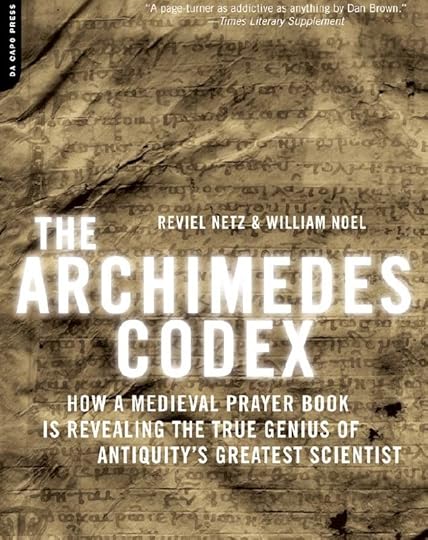
Î Îγγλική ÎκδοÏη (AMAZON 2007) αναÏÎÏει Ïον ÎÏÏιμήδη ÏÏ 'Ïον μεγαλÏÏεÏο ÎαθημαÏÎ¹ÎºÏ ÏÎ¿Ï Î±ÏÏÎ±Î¯Î¿Ï ÎºÏÏÎ¼Î¿Ï ' και 'Îναν αÏÏ ÏÎ¿Ï Ï Î¼ÎµÎ³Î±Î»ÏÏεÏÎ¿Ï Ï Î´Î¹Î±Î½Î¿Î·ÏÎÏ ÏÎ¿Ï ÎζηÏαν ÏοÏÎ' (ÏÏÏλογοÏ, Ïελ. 1). ΦαίνεÏαι ÏÏι η ÎκδοÏη ÏÎ·Ï Î ÎÎÎΤÎÎÎÏ ÏÏÏÏοÏÏÏηÏε ονομαζονÏÎ¬Ï Ïον "Î Î ÎΠΣÎÎÎÎΤÎÎÎΣ ÎÎ ÎΣΤÎÎΩΠΠÎÎ¥ ÎÎÎΣΠΠÎΤÎ" ÏÏάÏη ÏÎ¿Ï ÏÏάγμαÏι εξεÏÏÏμιÏε ο ÏÏ Î³Î³ÏαÏÎÎ±Ï ÏÏην Ïελ. 284! ..
ΠΡÎΣÎÎÎÎ Î: ΦαίνεÏαι ÏÏι κάÏοια ÏÏιγμή νÏÏÎ¯Ï ÏÏÎ¹Ï Î±ÏÏÎÏ ÏÎ¿Ï ÎÏÎ¿Ï Ï 1229, ÎÎ»Î»Î·Î½Î±Ï Î¹ÎµÏÎαÏ, ονÏμαÏι ÎÏÎ¬Î½Î½Î·Ï ÎÏÏÏναÏ, ÏÏειάÏÏηκε ÏεÏγαμηνή για Îνα βιβλίο ÏÏοÏÎµÏ ÏήÏ, ÏήÏε λοιÏÏν μία ÏÏ Î»Î»Î¿Î³Î® ÎÏγÏν ÏÎ¿Ï ÎÏÏÎ¹Î¼Î®Î´Î¿Ï Ï ÏÎ¿Ï Î®Ïαν γÏαμμÎνη Ïε ÏεÏγαμηνή ÏεÏίÏÎ¿Ï 250 ÏÏÏνια νÏÏίÏεÏα και διÎγÏαÏε, ÏÏο καλÏÏεÏα μÏοÏοÏÏε, Ïο κείμενο ÏÎ¿Ï ÎÏÏÎ¹Î¼Î®Î´Î¿Ï Ï Î±ÏÏ ÎµÎºÎµÎ¯Î½ÎµÏ ÏÏν ÏελίδÏν ÏÎ¿Ï ÏÎ¿Ï Î®Ïαν ακÏμη ÏÏήÏιμεÏ. ÎÏ ÏÏÏ ÎµÎ½ ÏÏ Î½ÎµÏεία ÏÏηÏιμοÏοίηÏε Î±Ï ÏÎÏ ÏÎ¹Ï ÏÎµÎ»Î¯Î´ÎµÏ Î³Î¹Î± να γÏάÏει Ïο κείμενο Î¼Î¹Î±Ï ÏÏ Î»Î»Î¿Î³Î®Ï ÎµÎ»Î»Î·Î½Î¹ÎºÏν ÏÏοÏÎµÏ ÏÏν Ïε οÏθή γÏνία ÏÏÏÏ Ïο ÎÏÏιμήδειο κείμενο αÏÏ ÎºÎ¬ÏÏ. ΣÏην ÏÏαγμαÏικÏÏηÏα ÏμÏÏ Î¿ ÎÏÏÏÎ½Î±Ï ÏÏειαζÏÏαν ÏεÏιÏÏÏÏεÏη ÏεÏγαμηνή αÏÏ Ï, Ïι θα μÏοÏοÏÏε να ÏÏοÏÏÎÏει ο ÏαλιÏÏ ÎÏÏÎ¹Î¼Î®Î´ÎµÎ¹Î¿Ï ÎºÏδικαÏ, οÏÏÏε εÏενÎβη καÏά Ïον ίδιο ÏÏÏÏο και Ïε άλλα εÏίÏÎ·Ï ÏημανÏικά και ÏÏÏα ÏαμÎνα, κείμενα ..... (Îλλά Î±Ï Ïή είναι μια άλλη ιÏÏοÏία.)[5]
ΠΡÎΣÎÎÎÎ Î': âThe safest general characterization of the European scientific tradition is that it consists of a series of footnotes to Archimedes.â ή "ΠαÏÏαλÎÏÏεÏÎ¿Ï Î³ÎµÎ½Î¹ÎºÏÏ ÏαÏακÏηÏιÏμÏÏ ÏÎ·Ï ÎµÏ ÏÏÏαÏÎºÎ®Ï ÎµÏιÏÏÎ·Î¼Î¿Î½Î¹ÎºÎ®Ï ÏαÏαδÏÏεÏÏ ÎµÎ¯Î½Î±Î¹ ÏÏι ÏÏ Î½Î¯ÏÏαÏαι αÏÏ Î¼Î¯Î± ÏειÏά Ï ÏοÏημειÏÏεÏν ÏÏον ÎÏÏιμήδη."
ÎÎÎ ÎΡΩΤÎÎÎ: ΦανÏάζεÏÏε - ÏÏÏÏ Î¸Î± ÏÏοÏιμοÏÏα και ÎµÎ³Ï ÎºÎ±Ï' αÏÏήν - Ïο ÏαλίμÏηÏÏο να αγοÏαζÏÏαν ÏελικÏÏ Î±ÏÏ Ïο 'ÎλληνικÏ' ÎημÏÏιο και να ανεÏίθεÏο η μελÎÏη ÏÎ¿Ï Ï.Ï. ÏÏον κ. Î ÎÎÎΤÎÎ ? ÎÏÎ¿Ï ÎºÎ±Î¹ να ανεÏίθεÏο Î¿Ï Î´ÎµÎ¯Ï ÎλληνÏÏÏÎ½Î¿Ï ÎºÎ±Î¸Î·Î³Î·ÏÎ®Ï Î´ÎµÎ½ θα αÏοÏολμοÏÏε να γÏάÏει ÏÏι ÎγÏαÏαν οι ÎÏÏαηλινoί ειδικοί Netz & Noel .. Σε Ïλην Ïην ομάδα ÏÏÏÏÏάμε Ïολλά ..
ΠΡÎΣÎÎÎÎ Î': The Newtonian program of reducing physical systems to geometrical representations obeying mathematical laws was taken from the Archimedean blueprint for science.And so, without Archimedes, there would be neither Galileo nor Newton. And for that matter, there would be no Boltzmann or Shannon either. Το ÎÎµÏ ÏÏνειο ÏÏÏγÏαμμα αναγÏÎ³Î®Ï ÏÏν ÏÏ ÏικÏν ÏÏ ÏÏημάÏÏν Ïε γεÏμεÏÏικÎÏ Î±Î½Î±ÏαÏαÏÏάÏÎµÎ¹Ï Î¿Î¹ οÏÎ¿Î¯ÎµÏ Ï ÏακοÏÎ¿Ï Î½ Ïε μαθημαÏικοÏÏ Î½ÏÎ¼Î¿Ï Ï ÏÏοήλθε αÏÏ Ïο ÏÏÎδιο ÏÎ¿Ï ÎÏÏÎ¹Î¼Î®Î´Î¿Ï Ï Î³Î¹Î± Ïην εÏιÏÏήμη. Îαι ÎÏÏι, ÏÏÏÎ¯Ï Ïον ÎÏÏιμήδη, δεν θα Ï ÏήÏÏε κανÎÎ½Î±Ï Galileo οÏÏε Newton, οÏÏε Boltzmann or Shannon .. [10]
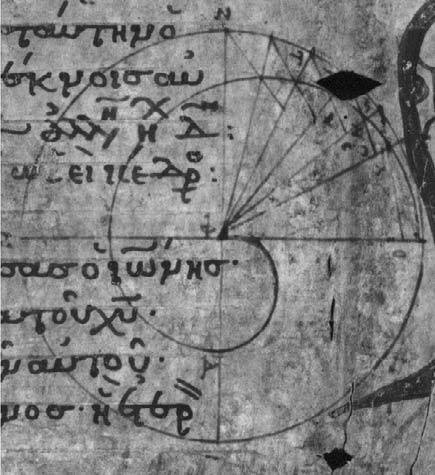
ÎÎÎÎ ÎÎÎÎΣÎÎΥΣÎ: Archimedes is the most important scientist who ever lived. This conclusion can be reached as follows.The British philosopher A. N. Whitehead once famously remarked: âThe safest general characterization of the European philosophical tradition is that it consists of a series of footnotes to Plato.â This judgment may sound outrageous, but in fact it is quite sober minded. Platoâs immediate followers, such as Aristotle, tried above all to refute or to refine Platoâs arguments.Later philosophers debated whether it was best to follow Plato or Aristotle. And so, in a real sense, all later Western philosophy is but a footnote to Plato.The safest general characterization of the European scientific tradition is that it consists of a series of footnotes to Archimedes. By which I mean, roughly the same kind of genealogy that Whitehead meant for Plato applies to Archimedes. As an example, we need only to look at one of the most influential books of modern science, Galileoâs Discourses Concerning Two New Sciences. This book was published in 1638, by which time Archimedes had been dead for exactly 1,850 yearsâa very long time indeed.Yet throughout it, Galileo is in debt to Archimedes. Essentially, Galileo advances the two sciences of statics (how objects behave in rest) and dynamics (how objects behave in motion). For statics, Galileoâs principal tools are centers of gravity and the law of the balance. Galileo borrows both of these conceptsâ explicitly, always expressing his admirationâfrom Archimedes. For dynamics, Galileoâs principal tools are the approximation of curves and the proportions of times and motions. Both of which, once again, derive directly from Archimedes. No other authority is as frequently quotedor quoted with equal reverence. Galileo essentially started out from where Archimedes left off, proceeding in the same direction as defined by his Greek predecessor.This is true not only of Galileo but also of the other great figures of the so-called âscientific revolution,â such as Leibniz, Huygens, Fermat, Descartes, and Newton. All of them were Archimedesâ children.With Newton, the science of the scientific revolution reached its perfection in a perfectly Archimedean form. Based on pure, elegant first principles and applying pure geometry, Newton deduced the rules governing the universe. All of later science is a consequence of the desire to generalize Newtonian, that is, Archimedean methods.The two principles that the authors of modern science learned from Archimedes are:⢠The mathematics of infinity⢠The application of mathematical models to the physicalworldThanks to the Palimpsest,we now know much more about these two aspects of Archimedesâ achievement.
ΣΤÎÎ ÎÎÎÎÎÎÎÎ (κÏιÏική καλοδεÏοÏμενη ..): Î ÎÏÏÎ¹Î¼Î®Î´Î·Ï ÎµÎ¯Î½Î±Î¹ ο Ïιο ÏημανÏικÏÏ ÎµÏιÏÏήμÏν ÏÎ¿Ï ÎζηÏε ÏοÏÎ. ÎÏ ÏÏ Ïο ÏÏ Î¼ÏÎÏαÏμα μÏοÏεί να ÏÏ Î½Î±Ïθεί ÏÏ ÎµÎ¾Î®Ï. Î ÎÏεÏανÏÏ ÏιλÏÏοÏÎ¿Ï A. N. Whitehead κάÏοÏε Ï ÏεÏÏήÏιξε: "ΠαÏÏαλÎÏÏεÏÎ¿Ï Î³ÎµÎ½Î¹ÎºÏÏ ÏαÏακÏηÏιÏμÏÏ ÏÎ·Ï ÎµÏ ÏÏÏαÏÎºÎ®Ï ÏιλοÏοÏÎ¹ÎºÎ®Ï ÏαÏαδÏÏεÏÏ ÎµÎ¯Î½Î±Î¹ ÏÏι Î±Ï Ïή ÏÏ Î½Î¯ÏÏαÏαι αÏÏ Î¼Î¹Î± ÏειÏά Ï ÏοÏημειÏÏεÏν ÏÏον ΠλάÏÏνα." ÎÏ ÏÏ Ïο αÏÏÏθεγμα μÏοÏεί να ακοÏγεÏαι εξÏÏÏενικÏ, αλλά ÏÏην ÏÏαγμαÏικÏÏηÏα είναι αÏοÏÎλεÏμα ÏÏÎ¯Î¼Î¿Ï ÏκÎÏεÏÏ. Îι άμεÏοι οÏαδοί ÏÎ¿Ï Î Î»Î¬ÏÏνοÏ, ÏÏÏÏ Î¿ ÎÏιÏÏοÏÎληÏ, ÏÏοÏÏάθηÏαν ÎºÏ ÏίÏÏ Î½Î± ανÏικÏοÏÏÎ¿Ï Î½ ή να βελÏιÏÏÎ¿Ï Î½ Ïα εÏιÏειÏήμαÏά ÏÎ¿Ï . ÎÏγÏÏεÏα οι ÏιλÏÏοÏοι ÏÏ Î¶Î®ÏηÏαν εάν ήÏαν καλλίÏεÏο ÎºÎ±Î½ÎµÎ¯Ï Î½Î± Î±ÎºÎ¿Î»Î¿Ï Î¸Î®Ïει Ïον ΠλάÏÏνα ή Ïον ÎÏιÏÏοÏÎλη. Îαι ÎÏÏι, Ï ÏÏ Î±Ï Ïήν Ïην Îννοια, Ïλη η μεÏαγενÎÏÏεÏη Î´Ï Ïική ÏιλοÏοÏία είναι μÏνον μια Ï ÏοÏημείÏÏη ÏÏον ΠλάÏÏνα.ΠαÏÏαλÎÏÏεÏÎ¿Ï Î³ÎµÎ½Î¹ÎºÏÏ ÏαÏακÏηÏιÏμÏÏ ÏÎ·Ï ÎµÏ ÏÏÏαÏÎºÎ®Ï ÎµÏιÏÏÎ·Î¼Î¿Î½Î¹ÎºÎ®Ï ÏαÏαδÏÏεÏÏ ÎµÎ¯Î½Î±Î¹ ÏÏι αÏοÏελείÏαι αÏÏ Î¼Î¹Î± ÏειÏά Ï ÏοÏημειÏÏεÏν ÏÏον ÎÏÏιμήδη. Îε Î±Ï ÏÏ ÎµÎ½Î½Î¿Ï, ÏεÏίÏÎ¿Ï Ïο ίδιο ÎµÎ¯Î´Î¿Ï Î³ÎµÎ½ÎµÎ±Î»Î¿Î³Î¯Î±Ï ÏÎ¿Ï Î¿ Whitehead διαÏÏÏÏÏε για Ïον ΠλάÏÏνα και ιÏÏÏει εÏίÏÎ·Ï Î³Î¹Î± Ïον ÎÏÏιμήδη. Îια ÏαÏάδειγμα, ÏÏειάζεÏαι μÏνο να δοÏμε Îνα αÏÏ Ïα ÏλÎον ÏημανÏικά βιβλία ÏÎ·Ï ÏÏγÏÏÎ¿Î½Î·Ï ÎµÏιÏÏήμηÏ, Ïο Discourses Concerning Two New Sciences [ÏÏαγμαÏεία εÏι ÏÎ·Ï Î¦Ï ÏÎ¹ÎºÎ®Ï Ï ÏÏ Ïην μοÏÏή διαλÏγÏν] ÏÎ¿Ï Galileo. ÎÏ ÏÏ Ïο βιβλίο εκδÏθηκε Ïο 1638, ÏÏαν ο ÎÏÏÎ¹Î¼Î®Î´Î·Ï ÎµÎ¯Ïε ήδη Ïεθάνει ÏÏιν 1.850 ÏÏÏνια - ÏÏάγμαÏι ÏÎ¿Î»Ï ÎºÎ±Î¹ÏÏ. ΩÏÏÏÏο, Ïε Ïλο Î±Ï ÏÏ Ïο ÎÏγο, ο ÎÎ±Î»Î¹Î»Î±Î¯Î¿Ï Î±Î½Î±Î³Î½ÏÏίζει Ïην οÏειλή ÏÎ¿Ï ÏÏον ÎÏÏιμήδη, Ïην οÏοίαν εκÏÏάζει ÏηÏά. ÎÏ ÏιαÏÏικά, ο ÎÎ±Î»Î¹Î»Î±Î¯Î¿Ï ÏÏοάγει ÏÎ¹Ï Î´Ïο εÏιÏÏÎ®Î¼ÎµÏ ÏÎ·Ï Î£Î¤ÎΤÎÎÎΣ (ÏÏÏ ÏÏ Î¼ÏεÏιÏÎÏονÏαι Ïα ÏÏμαÏα εν ηÏεμία) και ÏÎ·Ï ÎÎ¥ÎÎÎÎÎÎΣ (ÏÏÏ Ïα ανÏικείμενα ÏÏ Î¼ÏεÏιÏÎÏονÏαι εν κινήÏει). Îια Ïην ÏÏαÏική, κÏÏια εÏγαλεία ÏÎ·Ï Î±Î½Î±Î»ÏÏεÏÏ ÏÎ¿Ï ÎÎ±Î»Î¹Î»Î±Î¯Î¿Ï ÎµÎ¯Î½Î±Î¹ Ïο κÎνÏÏο βάÏÎ¿Ï Ï ÎºÎ±Î¹ ο νÏÎ¼Î¿Ï ÏÎ·Ï Î¹ÏοÏÏοÏίαÏ. Î ÎÎ±Î»Î¹Î»Î±Î¯Î¿Ï Î´Î±Î½ÎµÎ¯Î¶ÎµÏαι και ÏÎ¹Ï Î´Ïο Î±Ï ÏÎÏ ÎÎ½Î½Î¿Î¹ÎµÏ - ÏÏ Î»Î»Î®ÏειÏ, εκÏÏάζονÏÎ±Ï ÏάνÏα Ïον Î¸Î±Ï Î¼Î±ÏÎ¼Ï ÏÎ¿Ï - αÏÏ Ïον ÎÏÏιμήδη. Îια Ïη Î´Ï Î½Î±Î¼Î¹ÎºÎ®, Ïα κÏÏια εÏγαλεία ÏÎ¿Ï ÎÎ±Î»Î¹Î»Î±Î¯Î¿Ï ÎµÎ¯Î½Î±Î¹ η ÏÏοÏÎγγιÏη ÏÏν καμÏÏ Î»Ïν και η αναλογία ÏÏν ÏÏÏνÏν και ÏÏν κινήÏεÏν. Îαι Ïα δÏο, για άλλη μια ÏοÏά, ÏÏοÎÏÏονÏαι αÏÎµÏ Î¸ÎµÎ¯Î±Ï Î±ÏÏ Ïον ÎÏÏιμήδη. Îαμμία άλλη Î±Ï Î¸ÎµÎ½Ïία - ÏÎÏαν Î±Ï ÏÎ®Ï ÏÎ¿Ï ÎÏÏÎ¹Î¼Î®Î´Î¿Ï Ï - δεν αναÏÎÏεÏαι ÏÏÏο ÏÏ Ïνά οÏÏε ÏαίÏει ίÏÎ¿Ï ÏεβαÏμοÏ. Î ÎÎ±Î»Î¹Î»Î±Î¯Î¿Ï Î¿Ï ÏιαÏÏικά ξεκίνηÏε αÏÏ ÎµÎºÎµÎ¯ ÏÎ¿Ï ÏÏαμάÏηÏε ο ÎÏÏιμήδηÏ, ÏÏοÏÏÏÏνÏÎ±Ï ÏÏÎ¿Ï Ïην ίδια καÏεÏÎ¸Ï Î½Ïη ÏÏÏÏ Î¿ÏίÏÏηκε αÏÏ Ïον Îλληνα ÏÏοκάÏοÏÏ ÏÎ¿Ï . ÎÏ ÏÏ Î¹ÏÏÏει ÏÏι μÏνον για Ïο Îαλιλαίο αλλά και για ÏÎ¹Ï Î¬Î»Î»ÎµÏ Î¼ÎµÎ³Î¬Î»ÎµÏ ÏÏοÏÏÏικÏÏηÏÎµÏ ÏÎ·Ï Î»ÎµÎ³ÏÎ¼ÎµÎ½Î·Ï 'εÏιÏÏÎ·Î¼Î¿Î½Î¹ÎºÎ®Ï ÎµÏαναÏÏάÏεÏÏ', ÏÏÏÏ Î¿ Leibniz, Huygens, Fermat, Descartes και Newton. Îλοι ÏÎ¿Ï Ï Ï ÏήÏξαν Ïαιδιά ÏÎ¿Ï ÎÏÏÎ¹Î¼Î®Î´Î¿Ï Ï. Îε Ïον ÎεÏÏÏνα, η ÏÏ Ïική ÏÎ·Ï ÎµÏιÏÏÎ·Î¼Î¿Î½Î¹ÎºÎ®Ï ÎµÏαναÏÏάÏεÏÏ ÎÏθαÏε ÏÏην ÏελειÏÏηÏά ÏÎ·Ï Ïε ÏÎλεια ÎÏÏιμήδεια μοÏÏή. ÎαÏιζÏÎ¼ÎµÎ½Î¿Ï Ïε ÏαÏείÏ, κομÏÎÏ ÏÏÏÏÎµÏ Î±ÏÏÎÏ ÎºÎ±Î¹ εÏαÏμÏζονÏÎ±Ï ÎºÎ±Î¸Î±Ïή γεÏμεÏÏία, ο ÎεÏÏÏν ÏÏ Î½Î®Î³Î±Î³Îµ ÏÎ¿Ï Ï Î½ÏÎ¼Î¿Ï Ï ÏÎ¿Ï Î´Î¹ÎÏÎ¿Ï Î½ Ïο ÏÏμÏαν. Îλη η μεÏαγενÎÏÏεÏη εÏιÏÏήμη είναι ÏÏ Î½ÎÏεια ÏÎ·Ï ÎµÏÎ¹Î¸Ï Î¼Î¯Î±Ï Î³ÎµÎ½Î¹ÎºÎµÏÏεÏÏ ÏÏν ÎÎµÏ ÏÏνειÏν, δηλαδή ÏÏν ÎÏÏιμήδειÏν μεθÏδÏν.Îι δÏο αÏÏÎÏ ÏÎ¿Ï Îμαθαν οι ÏÏ Î³Î³ÏαÏÎµÎ¯Ï ÏÎ·Ï ÏÏγÏÏÎ¿Î½Î·Ï ÎµÏιÏÏÎ®Î¼Î·Ï Î±ÏÏ Ïον ÎÏÏιμήδη είναι:⢠Τα μαθημαÏικά ÏÎ¿Ï Î±ÏείÏÎ¿Ï â¢ Î ÎµÏαÏμογή μαθημαÏικÏν Ï ÏοδειγμάÏÏν ÏÏον ÏÏ ÏικÏκÏÏμο ..ΧάÏη ÏÏο ΠαλίμÏηÏÏο ÏÏÏα γνÏÏÎ¯Î¶Î¿Ï Î¼Îµ ÏÎ¿Î»Ï ÏεÏιÏÏÏÏεÏα για Î±Ï ÏÎÏ ÏÎ¹Ï Î´Ïο ÏÏÏ ÏÎÏ ÏÏν εÏιÏÎµÏ Î³Î¼Î¬ÏÏν ÏÎ¿Ï ÎÏÏÎ¹Î¼Î®Î´Î¿Ï Ï.
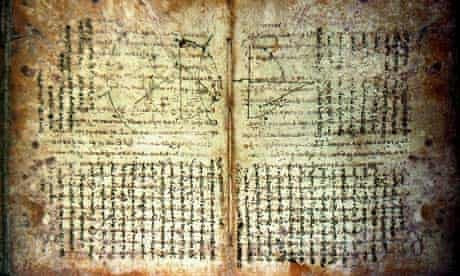 Pages from the Archimedes Palimpsest. Photograph: AP[20]
Pages from the Archimedes Palimpsest. Photograph: AP[20]ΣÎÎÎÎΩΣÎÎΣ[5]. Berggren 2008.[10]. Netz & Noel 2007, p. 291.[20]. <https://www.theguardian.com/books/201...
ÎÎÎÎÎÎÎΡÎΦÎÎReviel Netz and William Noel. 2007. Î ÎÏÎ´Î¹ÎºÎ±Ï ÏÎ¿Ï ÎÏÏιμήδη, Ïα Î¼Ï ÏÏικά ÏÎ¿Ï ÏÎ¹Ï ÏÏÎ¿Ï Î´Î±Î¯Î¿Ï ÏαλίμÏηÏÏÎ¿Ï ÏÏον κÏÏμο, ΠολιÏεία.
Reviel Netz and William Noel. 2007. The Archimedes Codex: How a Medieval Prayer Book is Revealing the True Genius of Antiquityâs Greatest Scientist, Da Capo Press.
https://www.ams.org/notices/200808/tx..., J. L. 2008. Rev. of Reviel Netz and William Noel, The Archimedes Codex: How a Medieval Prayer Book is Revealing the True Genius of Antiquityâs Greatest Scientist , in Notices of the AMS, pp. 943-947.
https://physicstoday.scitation.org/do...
Henry Mendell. 2008. Rev. of. Reviel Netz and William Noel, The Archimedes Codex: How a Medieval Prayer Book is Revealing the True Genius of Antiquityâs Greatest Scientist, in Physics Today 61 (5), pp. 55-56.
August 25, 2022
PHRYGIAN & GREEK LANGUAGE
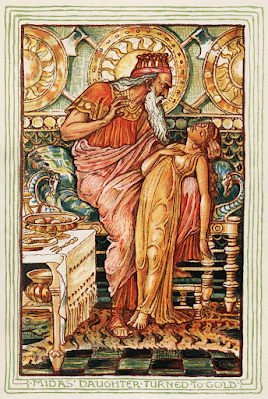 Î ÎÏÎ¸Î¿Ï ÏοÏ
Îίδα[1]ÎÎÎÎÎÎÎÏÏ ÏÏο γνÏÏίζοÏ
με ÏήμεÏα, η ΦÏÏ
γική ήÏαν ÏÏενά ÏÏ
νδεδεμÎνη με Ïην Îλληνική, ÏÏÏÏ Î¬Î»Î»ÏÏÏε καÏά Ïην ÏÏγÏÏονη εÏοÏή Ï
ÏοÏÏήÏιξε ο Î. ÎÏμÏÏοÏ
λοÏ.[2] ÎÏ
Ïή η εÏιβεβαίÏÏη είναι ÏÏ
νεÏÎ®Ï Î¼Îµ Ïην άÏοÏη ÏοÏ
ÎÏει διαÏÏ
ÏÏθεί αÏÏ ÏοÏ
Ï Neumann, Brixhe και Ligorio and Lubotsky και με ÏολλÎÏ ÏαÏαÏηÏήÏÎµÎ¹Ï ÏοÏ
δίνονÏαι αÏÏ Î±ÏÏαίοÏ
Ï ÏÏ
γγÏαÏείÏ.[3] Î ÏάγμαÏι ÏÏον ÎÏαÏÏλο ÏοÏ
ΠλάÏÏνοÏ, Plat. Crat. 410a, εÏιÏημαίνεÏαι:ΣÏκÏάÏηÏ: á½
Ïα ÏοίνÏ
ν καὶ ÏοῦÏο Ïὸ á½Î½Î¿Î¼Î± Ïὸ âÏῦÏâ μή Ïι βαÏβαÏικὸν á¾. ÏοῦÏο Î³á½°Ï Î¿á½Ïε ῥᾴδιον ÏÏοÏάÏαι á¼ÏÏὶν á¼Î»Î»Î·Î½Î¹Îºá¿ ÏÏνá¿, ÏανεÏοί Ïá¾½ εἰÏὶν οá½ÏÏÏ Î±á½Ïὸ καλοῦνÏÎµÏ Î¦ÏÏÎ³ÎµÏ ÏμικÏÏν Ïι ÏαÏακλίνονÏεÏ: καὶ ÏÏ Î³Îµ âá½Î´ÏÏâ καὶ Ïá½°Ï âκÏναÏâ καὶ á¼Î»Î»Î± Ïολλά. á¼ÏμογÎνηÏ:á¼ÏÏι ÏαῦÏα. ήÏοι [4] ΣÏκÏάÏηÏ: Î ÏÏÏεξε λοιÏÏν μήÏÏÏ ÎºÎ±Î¯ αÏ
ÏÏ ÏÏ Ïνομα ÏÎ°Ï 410a εÎναι εÏίÏÎ·Ï Î²Î±ÏβαÏÎ¹ÎºÎ®Ï ÎºÎ±ÏαγÏγήÏ. ÎιαÏί αÏ
ÏÏ Î´Îν είναι εÏκολο νά ÏÏ ÏÏεÏίÏη ÎºÎ±Î½ÎµÎ¯Ï Î¼Î Ïήν Îλληνική γλÏÏÏα, καί ακÏμη βλÎÏομε ÏÏι ÎÏÏι ÏÏ Î»Îνε οί ΦÏÏÎ³ÎµÏ Î¼Î Î¼Î¹ÎºÏή ÏÏοÏοÏοίηÏη. 'ÎÏίÏÎ·Ï ÎºÎ±Î¯ ÏÏ Î°Î´ÏÏ (νεÏÏ) καί ÏοÏ
Ï ÎºÏÎ½Î±Ï (ÏκÏλοÏ
Ï ) καί άλλα Ïολλά. á¼ÏμογÎνηÏ: Τά ÏαÏαδÎÏομαι.
Î ÎÏÎ¸Î¿Ï ÏοÏ
Îίδα[1]ÎÎÎÎÎÎÎÏÏ ÏÏο γνÏÏίζοÏ
με ÏήμεÏα, η ΦÏÏ
γική ήÏαν ÏÏενά ÏÏ
νδεδεμÎνη με Ïην Îλληνική, ÏÏÏÏ Î¬Î»Î»ÏÏÏε καÏά Ïην ÏÏγÏÏονη εÏοÏή Ï
ÏοÏÏήÏιξε ο Î. ÎÏμÏÏοÏ
λοÏ.[2] ÎÏ
Ïή η εÏιβεβαίÏÏη είναι ÏÏ
νεÏÎ®Ï Î¼Îµ Ïην άÏοÏη ÏοÏ
ÎÏει διαÏÏ
ÏÏθεί αÏÏ ÏοÏ
Ï Neumann, Brixhe και Ligorio and Lubotsky και με ÏολλÎÏ ÏαÏαÏηÏήÏÎµÎ¹Ï ÏοÏ
δίνονÏαι αÏÏ Î±ÏÏαίοÏ
Ï ÏÏ
γγÏαÏείÏ.[3] Î ÏάγμαÏι ÏÏον ÎÏαÏÏλο ÏοÏ
ΠλάÏÏνοÏ, Plat. Crat. 410a, εÏιÏημαίνεÏαι:ΣÏκÏάÏηÏ: á½
Ïα ÏοίνÏ
ν καὶ ÏοῦÏο Ïὸ á½Î½Î¿Î¼Î± Ïὸ âÏῦÏâ μή Ïι βαÏβαÏικὸν á¾. ÏοῦÏο Î³á½°Ï Î¿á½Ïε ῥᾴδιον ÏÏοÏάÏαι á¼ÏÏὶν á¼Î»Î»Î·Î½Î¹Îºá¿ ÏÏνá¿, ÏανεÏοί Ïá¾½ εἰÏὶν οá½ÏÏÏ Î±á½Ïὸ καλοῦνÏÎµÏ Î¦ÏÏÎ³ÎµÏ ÏμικÏÏν Ïι ÏαÏακλίνονÏεÏ: καὶ ÏÏ Î³Îµ âá½Î´ÏÏâ καὶ Ïá½°Ï âκÏναÏâ καὶ á¼Î»Î»Î± Ïολλά. á¼ÏμογÎνηÏ:á¼ÏÏι ÏαῦÏα. ήÏοι [4] ΣÏκÏάÏηÏ: Î ÏÏÏεξε λοιÏÏν μήÏÏÏ ÎºÎ±Î¯ αÏ
ÏÏ ÏÏ Ïνομα ÏÎ°Ï 410a εÎναι εÏίÏÎ·Ï Î²Î±ÏβαÏÎ¹ÎºÎ®Ï ÎºÎ±ÏαγÏγήÏ. ÎιαÏί αÏ
ÏÏ Î´Îν είναι εÏκολο νά ÏÏ ÏÏεÏίÏη ÎºÎ±Î½ÎµÎ¯Ï Î¼Î Ïήν Îλληνική γλÏÏÏα, καί ακÏμη βλÎÏομε ÏÏι ÎÏÏι ÏÏ Î»Îνε οί ΦÏÏÎ³ÎµÏ Î¼Î Î¼Î¹ÎºÏή ÏÏοÏοÏοίηÏη. 'ÎÏίÏÎ·Ï ÎºÎ±Î¯ ÏÏ Î°Î´ÏÏ (νεÏÏ) καί ÏοÏ
Ï ÎºÏÎ½Î±Ï (ÏκÏλοÏ
Ï ) καί άλλα Ïολλά. á¼ÏμογÎνηÏ: Τά ÏαÏαδÎÏομαι.ÎμεÏÎµÏ ÏηγÎÏ Î³Î¹Î± Ïην ΦÏÏ Î³Î¹ÎºÎ® αÏοÏελοÏν εÏιγÏαÏÎÏ ÏÎ¿Ï Î²ÏÎθηκαν ÏÏην κενÏÏική ÎναÏολία, Î±Ï ÏÎÏ Î´Îµ διακÏίνονÏαι Ïε δÏο κÏÏια ÏÏμαÏα: Î Ïαλαιά ΦÏÏ Î³Î¹ÎºÎ® (OPhr.) ή ΠαλαιοÏÏÏ Î³Î¹ÎºÎ® ÏεÏιλαμβάνει εÏιγÏαÏÎÏ ÏÎ·Ï ÏεÏιÏÎ´Î¿Ï 800 ÎÏÏ 330 Ï.Χ., οι οÏÎ¿Î¯ÎµÏ ÏÏηÏιμοÏοιοÏÏαν εÏιÏÏÏιο αλÏάβηÏο, βαÏιÏμÎνο ÏÏο ÎλληνικÏ.[5] Το ÏÏμα ÏÎ¿Ï Î±ÏαÏÏίζει Ïα ÏεκμήÏια ÏÎ·Ï ÎÎÎ±Ï Î¦ÏÏ Î³Î¹ÎºÎ®Ï ÏεÏιλαμβάνει 118 εÏιγÏαÏÎÏ ÏÏονολογοÏÎ¼ÎµÎ½ÎµÏ ÏÏην ÎÏ ÏοκÏαÏοÏική ΡÏμαÏκή ÏεÏίοδο, Î±Ï ÏÎÏ Î´Îµ είναι γÏαμμÎÎ½ÎµÏ ÏÏο ÎµÎ»Î»Î·Î½Î¹ÎºÏ Î±Î»ÏάβηÏο και ÏεÏιÎÏÎ¿Ï Î½ ÎºÏ ÏίÏÏ ÏÏÏÎ¿Ï Ï ÎºÎ±ÏάÏÎ±Ï ÎºÎ±Ïά ÏÏν βεβηλÏÏÏν. Îιά Ïην ÎÎα ΦÏÏ Î³Î¹ÎºÎ® ÏημειÏνεÏαι ÎµÎ´Ï Î· άÏοÏη ÏÎ¿Ï Î§Ï. ΤζιÏζιλή[6], ÏÏι ÏÏακÏικÏÏ ÏÏÏκειÏαι ÏÏι για γλÏÏÏα αλλά γιά μιά αÏÏαÏκή ÎÏαÏκή διάλεκÏο! Îξίζει να ÏÏοÏÏεθεί ÏÏεÏικÏÏ ÏÏι και ο Woudhuizen ÏίÏÏÎµÏ Îµ αÏÏικÏÏ ÏÏι η ÎÎα ΦÏÏ Î³Î¹ÎºÎ® είÏε εÏηÏÏεαÏÏεί αÏÏ Ïην Îλληνική, η οÏοία ÏÏην Î. ÎεÏÏγειο αÏεÏÎλη Ïην lingua franca αÏÏ Ïην ÎλληνιÏÏική εÏοÏή και μεÏά, ÎµÏ ÏίÏκεÏο δε εν μÎÏÏ Î´Î¹Î±Î´Î¹ÎºÎ±ÏÎ¯Î±Ï Î¼ÎµÏαÏÏοÏÎ®Ï ÏÎ·Ï Ïε ÏεÏιÏεÏειακή διάλεκÏο ÏÎ·Ï ÎλληνικήÏ, άÏοÏη ÏÎ¿Ï ÏμÏÏ Î±Î½Î±ÏκεÏαÏε εν ÏÏ Î½ÎµÏεία.[6a1] ÎÏÏ ÏÎ¿Ï Ï ÎλληνιÏÏικοÏÏ ÏÏÏÎ½Î¿Ï Ï Ï ÏάÏÏει μια ÏημανÏική εÏιγÏαÏή, η W-11 (εÏίÏÎ·Ï Î³ÏαμμÎνη ÏÏην ελληνική γÏαÏή), Ïην οÏοία οι μελεÏηÏÎÏ Î¸ÎµÏÏοÏν ÏÏ Ïνά ÏÏ Îνα ÏÏίÏο ÏÏάδιο ÏÎ·Ï Î³Î»ÏÏÏαÏ, ÏÎ¿Ï Î¿Î½Î¿Î¼Î¬Î¶ÎµÏαι ÎÎÏη ΦÏÏ Î³Î¹ÎºÎ® (MPhr.).
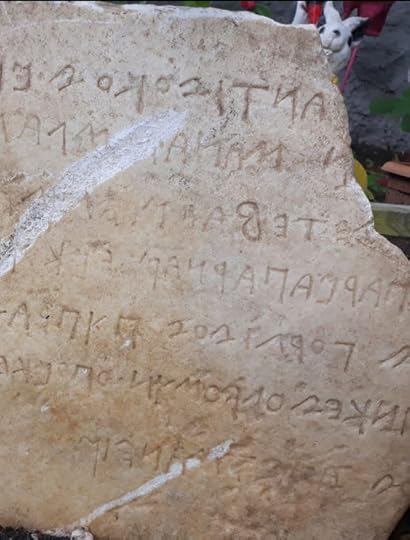 An inscription bearing the name of the ancient city was found at the excavation site in Gordion, the capital of the Phrygians[6a2]
An inscription bearing the name of the ancient city was found at the excavation site in Gordion, the capital of the Phrygians[6a2]Î ÎÏÏδοÏÎ¿Ï Î¼Î±Ï ÏληÏοÏοÏεί γιά Ïην μεÏανάÏÏÎµÏ Ïη ÏÏν ΦÏÏ Î³Ïν αÏÏ Ïην Îακεδονία ÏÏην ÎικÏά ÎÏία ÏÏοÏθÎÏονÏÎ±Ï ÏÏι, καÏά Ïην γνÏμη ÏÎ¿Ï , οι ÎÏμÎνιοι ήÏαν αναÏολικοί άÏοικοι ÏÏν ΦÏÏ Î³Ïν, Hdt. 7.73.1. ΠΣÏÏάβÏν, Strab. 7.3.2, ÏÏονολογεί Ïην μεÏανάÏÏÎµÏ Ïη 'λίγο μεÏά Ïα ΤÏÏικά', ÎµÎ½Ï Î· εμÏάνιÏη 'βαÏβαÏικήÏ' κεÏÎ±Î¼ÎµÎ¹ÎºÎ®Ï Î±ÏÏ Ïην ΧεÏÏÏνηÏη ÏÎ¿Ï ÎÎ¯Î¼Î¿Ï ÏαίνεÏαι να ÏιÏÏοÏοιείÏαι ÏÏην ΤÏÏάδα αÏÏ Ïον 11ο αιÏνα Ï.Χ.[7] Îι ÏληÏοÏοÏÎ¯ÎµÏ ÏÏν αÏÏαίÏν ÏÏ Î³Î³ÏαÏÎÏν ÏεÏί μεÏαναÏÏεÏÏεÏÏ ÏÏν ΦÏÏ Î³Ïν αÏÏ Ïην ΧεÏÏÏνηÏο ÏÎ¿Ï ÎÎ¯Î¼Î¿Ï ÏÏην ÎικÏά ÎÏία ÏαίνεÏαι να Ï ÏοÏÏηÏίζονÏαι αÏÏ ÏÎ¹Ï ÏÏγÏÏÎ¿Î½ÎµÏ Î³Î»ÏÏÏολογικÎÏ ÎÏÎµÏ Î½ÎµÏ. Î ÏάγμαÏι η Alonso θεÏÏεί ÏÏι η ΦÏÏ Î³Î¹ÎºÎ® ανήκει ÏÏον λεγÏμενο γλÏÏÏÎ¹ÎºÏ ÏÏÏο ÏÎ·Ï Î§ÎµÏÏονήÏÎ¿Ï ÏÎ¿Ï ÎÎ¯Î¼Î¿Ï , γεγονÏÏ Ïο οÏοίο εÏμηνεÏει Ïην βαθιά γενεÏική ÏÏÎÏη μεÏÎ±Î¾Ï ÏÎ·Ï ÎÎ»Î»Î·Î½Î¹ÎºÎ®Ï ÎºÎ±Î¹ ÏÎ·Ï Î¦ÏÏ Î³Î¹ÎºÎ®Ï.[8] Îι δÏο γλÏÏÏÎµÏ Î±Î½Î±ÏÏÏÏθηκαν λοιÏÏν ÏÏο ίδιο γλÏÏÏÎ¹ÎºÏ ÏεÏιβάλλον, αλλά η μεÏανάÏÏÎµÏ Ïη ÏÏν ΦÏÏ Î³Ïν ÏÏην ÎναÏολία ÏÏα ÏÎλη ÏÎ·Ï Î´ÎµÏÏεÏÎ·Ï ÏιλιεÏÎ¯Î±Ï Ï.Χ. διÎκοÏε Ïη γεÏγÏαÏική ÏÎ¿Ï Ï ÏÏ Î½Î¬Ïεια. ΠΦÏÏ Î³Î¹ÎºÎ®, ÏÎ¿Ï Î¼Î±ÏÏÏ ÏείÏαι αÏÏ Îναν μεγάλο αÏÎ¹Î¸Î¼Ï ÎµÏιγÏαÏÏν αÏÏ Ïον ÎναÏο αιÏνα Ï.Χ. ÎÏÏ Ïον ÏÏίÏο αιÏνα μ.Χ., αÏοδείÏθηκε - καÏά Ïην ίδια ÏÏοÏÎγγιÏη - ÏÏι ÏÏην ÎναÏολία αÏεÏÎλη μία Îαλκανική γλÏÏÏική νήÏο, ÏεÏιβαλλÏμενη αÏÏ ÏολλÎÏ Î±Ï ÏÏÏÎ¸Î¿Î½ÎµÏ Î³Î»ÏÏÏÎµÏ ÏÎ¿Ï Î±Î½Î®ÎºÎ¿Ï Î½ ÏÏην γλÏÏÏική ομάδα ÏÎ·Ï ÎικÏαÏίαÏ. Îι ΦÏÏÎ³ÎµÏ ÎµÎ½ÏάÏθηκαν Ïε εκείνο Ïο ÏεÏιβάλλον ÏÎ·Ï ÎναÏολίαÏ, ÏÏÏÏ Î¼ÏοÏοÏν εÏκολα να αÏÎ¿Î´ÎµÎ¯Î¾Î¿Ï Î½ ÏολλÎÏ ÏολιÏιÏÏικÎÏ ÎµÏιÏÏοÎÏ, αλλά και οÏιÏμÎνα γλÏÏÏικά ÏαÏακÏηÏιÏÏικά. ΩÏÏÏÏο, ο αÏÏικÏÏ Î´ÎµÏμÏÏ Î¼Îµ Ïην αδελÏή Îλληνική γλÏÏÏα ανθίÏÏαÏο, καÏÎÏÏη δε ακÏμη Ïιο ιÏÏÏ ÏÏÏ Î¼ÎµÏά Ïον ÏÏÎ±Î´Î¹Î±ÎºÏ ÎµÎ¾ÎµÎ»Î»Î·Î½Î¹ÏÎ¼Ï ÏÎ·Ï ÎναÏολίαÏ, ÎµÎ½Ï Î¿Î¹ εÏιγÏαÏÎÏ ÏαÏÎÏÎ¿Ï Î½ Ïα ÏÏοιÏεία για Ïη διεÏεÏνηÏη ÏÎ·Ï Î³ÎµÎ½ÎµÏÎ¹ÎºÎ®Ï ÏÎ¿Ï Ï ÏÏ Î³Î³ÎνειαÏ.ÎΦÎÎΡΩÎÎΤÎÎΠΦΡΥÎÎÎÎ ÎÎ ÎÎΡÎΦΠM-01a ΠΡÎΣ ΤÎÎÎΠΤÎÎ¥ ÎÎÎÎ (Midas Phrygian inscription M-01) [image error]
We have to note that this Phrygian alphabet, used in the above inscription of c 800 BC, is clearly of Greek association - origin.[9] Note the following excerpt from Young:[10]
If we put credence in the tales of Herodotos (I, 14) and of Pollux (IX, 83) that King Midas dedicated a throne at ÎÎÎΦÎÎ - Delphi, and that he married ÎÎÎÎÎÎÎÎ - Demodike the daughter of ÎÎÎÎÎÎÎΩΠ- Agamemnon King of Kyme, we have evidence for contact, casual or regular, between eighth-century Phrygia and the Greek settlements of the west coast.
A COMMENT FOR THE Phrygian Inscription M-01a word by word: (a) ÎΤÎΣ is the name of the dedicator, found in the LGPN database of Greek personal names, the companion and lover of the Great Goddess, Agdistis - á¼Î³Î´Î¹ÏÏÎ¹Ï or Kybele[11](b) ÎΡÎÎÎÎFÎÎΣ can be interpreted as a patronymic adjective built on the Greek personal name ÎÏκιαÏ, also found in LGPN, (b*) ÎÎÎÎÎÎÎÎÎFÎΣ: αÏÏ Ïον Woudhuizen εÏμηνεÏεÏαι ÏÏ Î¹ÎµÏÎÎ±Ï ÏÎ·Ï ÏελεÏÎ¿Ï ÏÎ³Î¹ÎºÎ®Ï ÏÏ ÏάÏ,[12] ÎµÎ½Ï ÎºÎ±Ïά Watkins η λÎξη ενδεÏομÎνÏÏ ÏÏ Î½Î´ÎεÏαι με Ïον ιεÏÎα κοίη ή κÏη ÏÏν Î¼Ï ÏÏηÏίÏν ÏÎ·Ï Î£Î±Î¼Î¿Î¸ÏάκηÏ.[14] (c) ÎÎÎÎÎ is the dative form referred to the receiver of the dedication, (d) ÎÎFÎÎΤÎÎÎ & (e) FANAKTEI (both in dative) are the Greek words λαÏαγÎÏÎ·Ï & άναξ mentioned in Linear B as ra-wa-ke-ta and wa-na-ka,[13](f) ÎÎÎÎΣ: 3rd. sing. preterite verb meaning "set (up)", "he has made", "has placed" he gave" or "he made" said to be a morphological isogloss shared between Armenian, Greek and Indo-Iranian. Note that δα is used for γᾶ, γῠsee f.e. "ÏάνÏÏν á¼Î´Î¿Ï á¼ÏÏαλÎÏ" (Hes. Th. 117). According to LSJ: á¼Î´Î¿Ï, εοÏ, ÏÏ, is the sitting-place, base. Îλ. εÏίÏÎ·Ï Paleolexicon, s.v. ÎÎÎÎΣ.CONCLUSION: IF THIS LANGUAGE IS NOT GREEK THEN WHAT KIND IS, GIVEN - ALSO - THAT IN THIS VERY FIRST ATTESTATION OF PHRYGIAN WE ALSO FIND ONE OF THE OLDEST ATTESTATIONS OF THE GREEK ALPHABET!? SOURCES USED: <http://www.palaeolexicon.com/Word/Sho..., LGPN name search, <http://mnamon.sns.it/index.php?page=E... LSJ lexicon
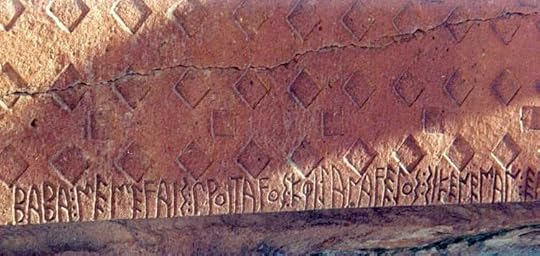 ΠεÏιγÏαÏή Î-01a ÏοÏ
Îίδα
ΠεÏιγÏαÏή Î-01a ÏοÏ
ÎίδαΣΥÎÎ ÎÎΡΩÎÎ ÎΠΠΤΠ'Î ÎÎÎΣÎÎÎÎ' ΤÎÎ¥ ÎΩÎÎÎ ÎÎ¥ÎÎÎ¥ 1993 [1912][20]
ÎΤÎΣ κÏÏιον Ïνομα, ÏÏβλ. ÎÏÏηÏ, ÎÏÏιÏ, ÎÏÏ Ï, Îλβαν. άÏε-α 'ÏαÏηÏ', ελλ. άÏÏαÎΡÎÎÎÎFÎÎΣ: ÎΡÎÎÎ ÏαÏÏÏÎ½Ï Î¼Î¹ÎºÏν (ÏÎ¿Ï ÎÏκία ή ÎÏÏÎ¯Î¿Ï ) ή αιÏ. Î¿Ï Ï. ÏÏ Ïο Îλβ. άÏκε-α, λαÏιν. arca 'κιβÏÏÎ¿Ï Î»Î¬Ïναξ' FÎÎΣ Ïήμα 'εÏοίηÏα, εÏοίηÏεν' λÎÎ¾Î¹Ï Î¸ÎµÏÏοÏμενη ανÏίÏÏοιÏÎ¿Ï ÏÎ¿Ï ÎÏ ÎºÎ¹ÎºÎ¿Ï ÎÎÎΣ, Îλβ. bai Ï, 'εÏÎ¿Î¯Î¿Ï Î½, εÏοίηÏα' Î ÎÏμÏÏÎ¿Ï Î»Î¿Ï ÏημειÏνει Ïο ÎλληνοκαÏÏαδοκικÏν Ïήμα Î´Î¬Î¶Ï Ïημαίνον 'ÏοιÏ, εÏγάζομαι', ÏÏβλ. δαιδάλλÏ, ÎαίδαλοÏ
ÎÎÎÎΣ θεÏÏείÏαι Ïήμα ÏÎ¿Ï Î±Ï ÏÎ¿Ï Î¸ÎμαÏÎ¿Ï ÏÏÎ¿Ï Ïο νεοÏÏÏ Î³Î¹ÎºÏν ÎÎÎÎΤ 'ÏοιήÏη', Ïημαίνον 'εÏοίηÏε'. Το αÏÏικÏν ε- ÏÏ Î½Î¹ÏÏά Ïην αÏξηÏιν ÏÎ¿Ï Î±Î¿ÏίÏÏοÏ
ÎÎÎÎÎÎÎÎÎFOS: ίÏÏÏ ÏÏνθεÏον αÏÏ Ïο ακενανÏ- (εκ ÏÎ¿Ï Î±ÎºÎµÏ, ακÎομαι βλ. LSJ ) & λαFoÏ = λαÏÏ Î±Î½ÏίÏÏοιÏον ÏÏ ÎµÎ»Î»Î·Î½. ÎκεÏίλαοÏ
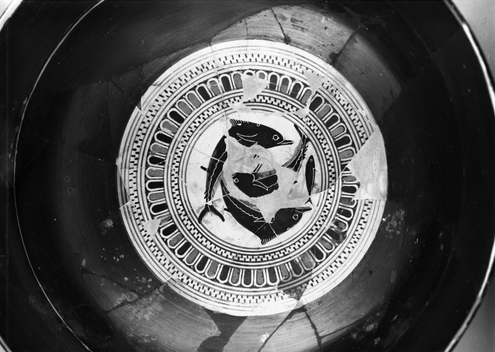 ÎÏÏική μελανÏμοÏÏη Ïιάλη με ÏείλοÏ, κεÏαμοÏÎ¿Î¹Î¿Ï ÎÏγοÏίμοÏ
& ζÏγÏάÏοÏ
ÎλειÏία, ÏÏÎ¼Î²Î¿Ï V ÎοÏδίοÏ
[100]
ÎÏÏική μελανÏμοÏÏη Ïιάλη με ÏείλοÏ, κεÏαμοÏÎ¿Î¹Î¿Ï ÎÏγοÏίμοÏ
& ζÏγÏάÏοÏ
ÎλειÏία, ÏÏÎ¼Î²Î¿Ï V ÎοÏδίοÏ
[100]ÎÎÎÎÎÎ-ΦΡΥÎÎÎÎ ÎÎ ÎÎΡÎΦΠΣΠÎΦÎÎΡΩÎÎΤÎÎΠΣΤÎÎÎ Vezirhan (B-05) ÎÎÎÎ¥ÎÎÎΣ
[image error]
Î ÏÏκειÏαι για εÏιγÏαÏή Ïε αÏβεÏÏολιθική ÏÏήλη ελληνοÏεÏÏÎ¹ÎºÎ¿Ï ÏÏ Î¸Î¼Î¿Ï ÏÎ¿Ï Î²ÏÎθηκε Ïε δÏο κομμάÏια ÏÏην κοιλάδα ÏÎ¿Ï Î£Î±Î³Î³Î±ÏÎ¯Î¿Ï ÎºÎ¿Î½Ïά ÏÏην ÏεÏιοÏή ÎεζιÏÏάν ÏÎ¿Ï ÎÏιλεÏζίκ. Î ÏÏήλη ÏÏÎ¿Ï Ï 1,5 μÎÏÏÎ¿Ï ÎÏει ÏÏία ξεÏÏÏιÏÏά Î±Î½Î¬Î³Î»Ï Ïα ÏÏο εÏÎ¬Î½Ï Î¼ÎÏοÏ. ΣÏην κοÏÏ Ïή διακÏίνεÏαι Ïο Î±Î½Î¬Î³Î»Ï Ïο Î³Ï Î½Î±Î¹ÎºÎµÎ¯Î±Ï ÏÏοÏÎ¿Î¼Î®Ï Î¼Îµ ανοιÏÏÎÏ Î±Î³ÎºÎ¬Î»ÎµÏ ÎºÎ±Î¹ ÏÏÎ¹Ï Î´Ïο ÏÎ»ÎµÏ ÏÎÏ. Î¥ÏάÏÏει Îνα ÏÏÎ·Î½Ï Ïε κάθε ÏÎÏι και ÎÎ½Î±Ï Î»ÎÏν κάÏÏ Î±ÏÏ ÎºÎ¬Î¸Îµ ÏÎÏι. ÎÏÎ³Ï Î±Ï ÏÏν ÏÏν ζÏÏν, ÏιÏÏεÏεÏαι ÏÏι Ïο Î±Î½Î¬Î³Î»Ï Ïο ανÏιÏÏοÏÏÏεÏει Ïη μηÏÎÏα θεά Matar. ÎάÏÏ Î±ÏÏ Î±Ï ÏÏ ÎµÏ ÏίÏκεÏαι Ïο Î±Î½Î¬Î³Î»Ï Ïο Î¼Î¹Î±Ï ÏÎºÎ·Î½Î®Ï ÏÏ Î¼ÏοÏÎ¯Î¿Ï ÏÎ¿Ï Î±Ïεικονίζει οÏθοÏÏ ÎºÎ±Î¹ ÎºÎ±Î¸Î®Î¼ÎµÎ½Î¿Ï Ï Î±Î½Î¸ÏÏÏÎ¿Ï Ï. Το ÏÏίÏο Î±Î½Î¬Î³Î»Ï Ïο δείÏνει Îναν ιÏÏÎα Ïε ÎºÏ Î½Î®Î³Î¹ κάÏÏÎ¿Ï . ÎάÏÏ Î±ÏÏ Ïα Î±Î½Î¬Î³Î»Ï Ïα Ï ÏάÏÏει μια ÏαλαιοÏÏÏ Î³Î¹ÎºÎ® εÏιγÏαÏή 13 γÏαμμÏν. Το κείμενο Î±Ï ÏÏ ÏεÏιβάλλεÏαι αÏÏ Î¼Î¹Î± Ïιο αÏÏÏÏεκÏα ÏαÏαγμÎνη ελληνική εÏιγÏαÏή 7 γÏαμμÏν, ÏÎ¿Ï ÏιÏÏεÏεÏαι ÏÏι ÏÏοÏÏÎθηκε εκ ÏÏν Ï ÏÏÎÏÏν. ÎÎ»ÎµÏ Î¿Î¹ γÏαμμÎÏ ÏÎ·Ï ÏαλαιοÏÏÏ Î³Î¹ÎºÎ®Ï ÎµÏιγÏαÏÎ®Ï ÎµÎ¯Î½Î±Î¹ γÏαμμÎÎ½ÎµÏ Î²Î¿Ï ÏÏÏοÏηδÏν, ÎµÎ½Ï Î· ελληνική εÏιγÏαÏή είναι δεξιÏÏÏÏοÏη. ΧÏονολογείÏαι ÏÏον 5ο αιÏνα Ï.Χ. Î ÏÏήλη ÎµÏ ÏίÏκεÏαι ÏÏο ÎÏÏÎ±Î¹Î¿Î»Î¿Î³Î¹ÎºÏ ÎÎ¿Ï Ïείο ÏÎ·Ï ÎÏνÏÏανÏινοÏÏοληÏ.[120]
Î Gorbachov 2008 ÏÏεÏικά με Ïην εÏιγÏαÏή αÏÏ Ïον Vezirhan (B-05) Ï ÏοÏÏηÏίζει ÏειÏÏικά ÏÏι, λÏÎ³Ï ÏÎ·Ï Î±Î½ÏιÏÏοιÏÎ¯Î±Ï ÏÏην ÏÏÏÏαÏη ÏÎ¿Ï ÏÏÏÎ¿Ï ÎºÎ±ÏάÏÎ±Ï Î±Ï ÏÎ¿Ï ÏÎ¿Ï Î´Î¯Î³Î»ÏÏÏÎ¿Ï ÎºÎµÎ¹Î¼ÎÎ½Î¿Ï Î¼ÎµÏÎ±Î¾Ï ÏÎ¿Ï Î¦ÏÏ Î³Î¹ÎºÎ¿Ï sin-t imenan kaka oskavos kakey kan dedapitiy tubeti και ÏÎ¿Ï ÎλληνικοÏá½ÏÏÎ¹Ï ÏεÏὶ Ïὸ ἱεÏὸν ÎºÎ±ÎºÎ¿Ï ÏãγãεÏήÏαι , á¼Ì δÏῦν á¼(κ)κÏÏαι, Î±Ï ÏÏ ÏÎ¿Ï ÏÏÎÏει να διαβαÏÏεί ÏÏα ΦÏÏ Î³Î¹ÎºÎ¬ ÏÏ sin timenan (γÏαμμÎÏ 1 και 8 ) ανÏιÏÏοιÏεί ÏÏο Ïὸ ἱεÏὸν ÏÏην Îλληνική εκδοÏή και ÏÏι αμÏÏÏεÏοι οι ÏÏοι αναÏÎÏονÏαι Ïε ιεÏÏ Î¬Î»ÏÎ¿Ï ÏÎ·Ï ÎÏÏÎÎ¼Î¹Î´Î¿Ï (γÏαμμή 3: ÎÏÏίμηÏοÏ· ÏημειÏÏÏε ÏÏι η κοÏÏ Ïή ÏÎ»ÎµÏ Ïά ÏÎ·Ï ÏÏÎ®Î»Î·Ï ÎµÎ¯Î½Î±Î¹ διακοÏμημÎνη με μια εικÏνα ÏÎ·Ï Î¸ÎµÎ¬Ï Î¼Îµ Ïην ιδιÏÏηÏά ÏÎ·Ï ÏÏ ÏÏÏÎ½Î¹Î±Ï Î¸Î·ÏÏν). Σε Î±Ï ÏÏ Ïο ÏλαίÏιο, η ÏαÏÏιÏη ÏÎ·Ï Î¦ÏÏ Î³Î¹ÎºÎ®Ï Î¼Î¿ÏÏÎ®Ï Î¼Îµ Ïο ÎÎ»Î»Î·Î½Î¹ÎºÏ ÏÎÎ¼ÎµÎ½Î¿Ï ÏÏοκÏÏÏει αβίαÏÏα και λαμβάνει ÏεÏαιÏÎÏÏ ÎµÏιβεβαίÏÏη αÏÏ Ïην γÏαÏική ÏαÏαλλαγή t1emeney (D sg.) ÏÏην αÏÏδοÏη ÏÎ¿Ï ÏÏÏÎ¿Ï ÎºÎ±ÏάÏÎ±Ï (γÏαμμή 13), ÏÎ¿Ï ÏαÏεμÏιÏÏÏνÏÏÏ ÎµÏιβεβαιÏνει Ïην οδονÏική αξία ÏÎ¿Ï ÏÏ Î¼Î²ÏÎ»Î¿Ï Ïε μοÏÏή βÎÎ»Î¿Ï Ï ÏÎ¿Ï Î±Î½ÏιÏÏοιÏεί ÏÏο ÎÏ ÏÏο-ÎινÏÎ¹ÎºÏ ÏÏμβολο ti-ÏÏÏÏ Î¿ Woudhuizen Ï ÏοÏÏηÏίζει αÏÏ Ïο 1982-3.[125]
ΣÏμÏÏνα με Ïην εÏιγÏαÏή: ο ÎÎ±Î»Î»Î¯Î±Ï [kaliyaâ¹sâº] ανήγειÏε - á¼Î½ÎθεÌκεν [⺠ti(:)tedat] ÏÎÎ¼ÎµÎ½Î¿Ï / ιεÏÏ [tâ imenan / timena-, t1emene-], ÏιθανÏÏ ÏÏÎ¿Ï Ïιμήν ÏÎ·Ï ÎÏÏÎÎ¼Î¹Î´Î¿Ï [artimitos] ÎÏÎ±Î½Î±Î¯Î±Ï Î® ÎÏÎ·Î½Î±Î¯Î±Ï Î® ÎÏÎ®Î½Î·Ï Î® ÏÏν Ï Î´Î¬ÏÏν [kraniyas'] η οÏοία άλλÏÏÏε ÏÏ Î ÏÏνια θηÏÏν εικονίζεÏαι ÏÏην Î±Î½Î¬Î³Î»Ï Ïη ÏÏήλη εν μÎÏÏ Î»ÎµÏνÏÏν & ÏÏηνÏν.[130] Îξίζει να ÏημειÏθεί ÎµÎ´Ï ÏÏι ο ΦÏÏÎ³Î·Ï ÏÏÏαÏιÏÏÎ·Ï ÏÏο ÎÏγο Î ÎÏÏÎµÏ ÏÎ¿Ï Î¤Î¹Î¼Î¿Î¸ÎÎ¿Ï ÏÎ·Ï ÎιλήÏÎ¿Ï Î±Ïοκαλεί ÏÏον ÏÏ. 160 Ïην θεά "á¼ÏÏιμιÏ" (ÏÏ. 160),[132] ÏαÏαÏλήÏια με Ïο ÎµÎ´Ï artimitos. ΣημειÏÏÏε ÏÏι ÏÏην εÏιγÏαÏή Î-01 ÏÎ¿Ï Îίδα η ΦÏÏ Î³Î¹ÎºÎ® ÎÎÎÎΣ ÎÏει ομοίÏÏ Ïο νÏημα ÏÎ¿Ï 'ανεγείÏÏ', ÏαÏάβαλε Ïο 'ÏάνÏÏν á¼Î´Î¿Ï á¼ÏÏαλÎÏ'! ÎÏοιοÏ, ÏÏ Î½ÎµÏÎ¯Î¶Î¿Ï Î¼Îµ Ïον ÏÏολιαÏÎ¼Ï ÏÎ·Ï ÎµÏιγÏαÏήÏ, ÏÏοÏÏÏήÏει Ïε κακÎÏ [kakos] ενÎÏÎ³ÎµÎ¹ÎµÏ / ÎºÎ±ÎºÎ¿Ï ÏγήÏει Ïε βάÏÎ¿Ï ÏÎ¿Ï Î¹ÎµÏÎ¿Ï Î® κÏÏει δÏÏν - ÏιθανÏÏ Î±ÏÏ ÏαÏακείμενο ιεÏÏ Î±Î»ÏÏλλιον - Î±Ï ÏÏÏ ÎºÎ±Î¹ οι εÏίγονοί ÏÎ¿Ï Î¸Î± Ï ÏοÏÏοÏν δεινά .. αναÏαÏάγονÏÎ±Ï ÏÏ ÏοÏοιημÎνη, ÏÏεÏεÏÏÏ Ïη ΦÏÏ Î³Î¹ÎºÎ® αλλά και Îλληνική ÏÏάÏη ÏεÏί ÏιμÏÏÎ¯Î±Ï Î±Ï ÏÏν ÏÎ¿Ï ÎµÎ½ÎµÏγοÏν ανÏÏÎ¹ÎµÏ ÏÏάξειÏ.[135] ÎÏιγÏαμμμαÏικά αναÏÎÏÎ¿Ï Î¼Îµ ÏÎ¹Ï ÏÏÏÏθεÏÎµÏ Î±Î½ÏιÏÏοιÏίεÏ: ÏÎκμÏÏ, ÏÎκμαÏ, Ïήμα, ÏÏιον [tekmor, tekmar], και [key] καθÏÏ ÎºÎ±Î¹ Ïην εÏλογη Ï ÏÏθεÏη ÏÏι Ïα ÏÏÏ Î³Î¹ÎºÎ¬ ÏαÏάγÏγα ÏÏν IE *nep(ÅÌ)t- και *neptih2- εÏιβεβαιÏνονÏαι Ïε Î±Ï ÏÏ Ïο κείμενο Ïε ÏολλÎÏ Î´Î¹Î±ÏοÏεÏικÎÏ ÏεÏιÏÏÏÏειÏ.[140]
ΦÏÏÎ³ÎµÏ & ÎÎ¿Ï ÏάÏÎ¹Î¿Ï ÏολιÏιÏμÏÏ
Î Hammond[150] λίγο ÏÎ¿Î»Ï Î³ÏάÏει ÏÏι η εξάÏλÏÏη ÏÏν ΦÏÏ Î³Ïν ÏÏην Îακεδονία ÏÎ±Ï ÏίζεÏαι με Ïην εξάÏλÏÏη ÏÏν ÏÏοιÏείÏν ÏÎ¿Ï ÏολιÏιÏÎ¼Î¿Ï ÏÎ·Ï ÎÎ¿Ï ÏαÏίαÏ/Lausitz. ÎÏ ÏÏ Î´ÎµÎ½ Ïημαίνει αναγκαÏÏικά ÏÏι οι ΦÏÏÎ³ÎµÏ ÎºÎ±ÏάγονÏαι αÏÏ Ïην ÎÎ¿Ï ÏαÏία, ÏμÏÏ ÎµÏ' Î±Ï ÏÎ¿Ï Ï ÏάÏÏει ÎλλειÏη ÏÏοιÏείÏν & αÏάÏεια. ÎÏλÏÏ, ÏÏο ζοÏÏαν ÏÏην ÏημεÏινή ÎÏÏειο Îακεδονία, δÎÏÏηκαν Ïην εÏίδÏαÏη ÏÎ¿Ï ÏολιÏιÏÎ¼Î¿Ï ÏÎ·Ï ÎÎ¿Ï ÏαÏίαÏ, Ï Î¹Î¿Î¸ÎÏηÏαν κάÏοια ÏÏοιÏεία ÏÎ¿Ï ÎºÎ±Î¹ καÏÏÏιν Ïα διÎδÏÏαν με Ïην εξάÏλÏÏή ÏÎ¿Ï Ï ÏÏην νοÏιÏÏεÏη Îακεδονία και Ïην νÏÏια ÎÎ»Î»Ï Ïίδα.[155]
Î Hammond ÏιÏÏεÏει ÏÏι ÏÏÏÏεÏÎ¿Ï Ïα ÏÏν ÎÏÏ Î³Ïν ÏÏη Îακεδονία ÏÏιν αÏÏ Ïον 8ο αιÏνα Ï.Χ. ήÏαν ÏιθανÏÏ Î· ÎδεÏÏα, ÏÏο βÏÏειο άκÏο ÏÎ¿Ï ÎεÏÎ¼Î¯Î¿Ï , αÏÏ Ïο οÏοίο ÏήÏε Ïο Ïνομά ÏÎ·Ï Î· ΦÏÏ Î³Î¹ÎºÎ® λÎξη για Ïο νεÏÏ ÎºÎ±Î¹ κονÏά ÏÏην οÏοία βÏίÏκονÏαν οι ÏεÏίÏημοι κήÏοι ÏÎ¿Ï Îίδα.[160]Τα Ï ÏÏλοιÏα ÏÎ¿Ï Î»Îει ÏμÏÏ Î³ÎµÎ½Î½Î¿Ïν κάÏοια ÏÏγÏÏ Ïη ÏÏον αÏοÏά ÏÏην ÎδεÏÏα, ÏÎ¹Ï ÎιγÎÏ ÎºÎ±Î¹ Ïην ÎεÏγίνα. Îια να ÏαÏÎ±Î¼ÎµÎ¯Î½Î¿Ï Î½ ιÏÏÏ Ïοί, Ï ÏοÏÏηÏίζει ο ίδιοÏ, οι ÎÏÏÎ³ÎµÏ ÎÏÏεÏε να ελÎγÏÎ¿Ï Î½ Ïην ÏεÏιοÏή ÏεÏί Ïην Ïεδιάδα ÏÎ¿Ï ÎξιοÏ. Îία αÏÏ ÏÎ¹Ï ÎµÏÎ¯Î¶Î·Î»ÎµÏ ÏÏÏÏ ÎλεγÏο θÎÏÎµÎ¹Ï Î®Ïαν Î±Ï Ïή ÏÎ¿Ï Î¦ÏÏ Î³Î¹ÎºÎ¿Ï Î¿Î¹ÎºÎ¹ÏÎ¼Î¿Ï ÏÎ·Ï ÎεÏγίναÏ, ÏÎ¿Ï Î¿Î½Î¿Î¼Î±Î¶ÏÏαν αÏÏικÏÏ ÎδεÏÏα και μεÏονομάÏÏηκε Ïε ÎιγÎÏ Î±ÏÏ ÏÎ¿Ï Ï ÎακεδÏÎ½ÎµÏ ÏÏαν Ïην καÏÎλαβαν. ÎÎÏÏι εκείνη Ïην εÏοÏή, ÏεÏίÏÎ¿Ï Î±ÏÏ Ïο 1140 ÎÏÏ ÏεÏίÏÎ¿Ï Ïο 800 Ï.Χ., η ÎεÏγίνα-ÎδεÏÏα ήÏαν - ÏÏμÏÏνα με Ïον Hammonds ÏάνÏα - Îνα αÏÏ Ïα μεγάλα κÎνÏÏα ÏÎ·Ï Î¦ÏÏ Î³Î¯Î±Ï. Τα λÏγια ÏÎ¿Ï Hammond Ï ÏοδηλÏÎ½Î¿Ï Î½ Ïην ÏÏαÏξη δÏο ÏÏλεÏν με Ïο Ïνομα ÎδεÏÏα, μία η ÏημεÏινή ÎδεÏÏα (βÏÏεια ÏÎ¿Ï ÎεÏÎ¼Î¯Î¿Ï ) και η άλλη ÏÏη ÎεÏγίνα (βÏÏεια ÏÎ·Ï Î Î¹ÎµÏίαÏ), μεÏÎÏειÏα ÎιγÎÏ.ÎαÏαληκÏικά ΣÏÏλια ΣÏμÏÏνα με ÏÏ Î³ÎºÏιÏική μελÎÏη ÏÎ¿Ï Obrador-Cursach βαÏιÏθείÏα Ïε Îνα ÏÏνολο ιÏογλÏÏÏÏν αμÏÏÏεÏÎµÏ Î· Îλληνική και η ΦÏÏ Î³Î¹ÎºÎ® μοιÏάζονÏαι 34 αÏÏ Ïα εξεÏαÏθÎνÏα ÏÏην μελÎÏη 36 ÏαÏακÏηÏιÏÏικά.[200] Τα ÏαÏακÏηÏιÏÏικά Î±Ï Ïά ήÏαν ÏÏνηÏικά, μοÏÏολογικά, λεξιλογικά,[205] και η εξÎÏαÏή ÏÎ¿Ï Ï ÎºÎ±ÏÎδειξε Ïην ÏÏ Î½Î¬Ïεια ΦÏÏ Î³Î¹ÎºÎ®Ï - ÎλληνικήÏ. ÎÏÏ Ïην ÏÎ»ÎµÏ Ïά ÏÎ¿Ï Î¿ Woudhuizen ÎÏει ομοίÏÏ ÎºÎ±ÏαÏÏίÏει καÏάλογο ανάλογÏν λÎξεÏν μεÏÎ±Î¾Ï ÏÏν δÏο γλÏÏÏÏν, εÏγαζÏÎ¼ÎµÎ½Î¿Ï Î¼Îµ βάÏη ÏÎ¹Ï Ï ÏάÏÏÎ¿Ï ÏÎµÏ ÎµÏιγÏαÏÎÏ, ο οÏÎ¿Î¯Î¿Ï ÏεÏιλαμβάνει 167 ÏαÏαÏλήÏÎ¹ÎµÏ Î»ÎξειÏ,[210] ÏÏÎ¹Ï Î¿ÏÎ¿Î¯ÎµÏ ÏμÏÏ Î¸Î± ÏÏÎÏει να ÏÏοÏÏεθοÏν και άλλεÏ![220]
ΣÎÎÎÎΩΣÎÎΣ[1]. ΣÏην Ï ÏÏ Ïον Nathaniel Hawthorne εκδοÏή ÏÎ¿Ï ÎÏÎ¸Î¿Ï ÏÎ¿Ï Îίδα, η κÏÏη ÏÎ¿Ï Î²Î±ÏιλÎα μεÏαÏÏÎÏεÏαι Ïε ÏÏÏ ÏÏ Î¬Î³Î±Î»Î¼Î± ÏÏαν Î±Ï ÏÏÏ Ïην Î±ÎºÎ¿Ï Î¼Ïά (εικÏνα Ï ÏÏ Walter Crane γιά Ïην ÎκδοÏη ÏÎ¿Ï 1893).[2]. ÎÏμÏÏÎ¿Ï Î»Î¿Ï, Î. 1993 [1912], Ïελ. 429-452.[3]. Obrador-Cursach. 2019, p. 238.[4]. μÏÏ. Îλία ÎÎ¬Î³Î¹Î¿Ï , Îθήνα (ÎαÏαÏÏÏÎ¿Ï Î»Î¿Ï).[5]. Obrador-Cursach. 2019, p. 233, nn. 2,3; Anfosso 2019, pp. 1-2.[6]. Anfosso 2019, p.; Tzitzilis 2013. Το αÏÏÏÏαÏμα αÏÏ Ïον ΤζιÏζιλή ÎÏει ÏÏ ÎµÎ¾Î®Ï: "the Neo-Phrygian inscriptions, found in several places of central Anatolia, are actually written in a Greek, and more specifically in an archaic Achaean dialect, with some phonetic peculiarities that should be attributed to Anatolian influence".[6a1]. Woudhuizen 2008-2009, p. 181: The exclusion of New Phrygian forms from the demonstration of the intimate relationship of Phrygian with Greek in the aforesaid work was intentional because I believed at that time that New Phrygian was influenced by the lingua franca in the east-Mediterranean region from the Hellenistic period onwards, i.c. Greek, to the extent that it actually was well on its way to become a provincial dialectal variant of Greek. I now hold this to be an error of judgment.. [6a2]. https://arkeonews.net/an-inscription-.... Îλ. <https://smerdaleos.wordpress.com/cate.... ÎÏίÏηÏ: ÎανÏÎ»ÎµÎ´Î¬ÎºÎ·Ï 2016, Ïελ. 55-56.[8]. Anfosso 2021. [9]. Young 1969, p. 253. ÎμÏÏ Î· ÏÏονική ÏÏοÏοÏεία ÏÎ¿Ï ÎÎ»Î»Î·Î½Î¹ÎºÎ¿Ï Î±Î»ÏαβήÏÎ¿Ï ÎνανÏι ÏÎ¿Ï Î¦ÏÏ Î³Î¹ÎºÎ¿Ï Î´ÎµÎ½ θεÏÏείÏαι δεδομÎνη![10]. Young 1969, p. 253.[11]. Young 1969, p. 262.[12]. Woudhuizen 2008-2009, pp. 194-195. [13]. Î Obrador-Cursach θεÏÏεί Ïο ÎÎFÎÎΤÎÎÎ ÏÏ Î¦ÏÏ Î³Î¹ÎºÏ Î´Î¬Î½ÎµÎ¹Î¿ αÏÏ Ïο ÎÏ ÎºÎ·Î½Î±ÏÎºÏ ra-wa-ke-ta (Obrador-Cursach 2019, p. 240). ΣÏην ίδια θÎÏη ÏÏολιάζεÏαι η λÎξη άναξ και Ïο ΦÏÏ Î³Î¹ÎºÏ Î±Î½ÏίÏÏοιÏο.[14]. LSJ, s.v. ÎÎ¿Î¯Î·Ï or ÎÏηÏ, Î¿Ï , á½, priest in the mysteries of Samothrace, Hsch., who also has κοιᾶÏαι· ἱεÏᾶÏαι, κοιÏÏαÏο· á¼ÏιεÏÏÏαÏο, καθιεÏÏÏαÏο.[20]. ÎÏμÏÏÎ¿Ï Î»Î¿Ï 1993 [1912], Ïελ. 441, 442 κ.ε.[100]. Young 1969, p. 295: The cup painted by the Attic craftsman Klitias ÎλειÏίαÏ, found by the Koertes in Tumulus V, bears the sign in EAPA4'%EN; it dates from about the same time as the Phrygian inscription, <https://smb.museum-digital.de/index.p.... https://www.phrygianmonuments.com/vez.... Woudhuizen 2008-2009, p. 190, n. 11.[130]. Î Obrador-Cursach (Obrador-Cursach 2018, p. 75) αναγιγνÏÏκει Ïο kraniyas ÏÏ ÎºÏηναία ή ÏÏν ÏηγÏν. ÎαÏ' άλλην εκδοÏή μÏοÏεί η λÎξη να αναγνÏÏθεί ÏÏ ÎÏαναία, ÏαÏαÏÎμÏονÏÎ±Ï ÏÏην ÎÏαναία Îθηνά! Î ÎÏαναία Îθηνά, Paus. 10.34.7 διÎθεÏε Î½Î±Ï ÏÏην ÎλάÏεια, ÏÏÎ¹Ï ÏλαγιÎÏ ÏÎ¿Ï Î²Î¿Ï Î½Î¿Ï ÎαλιδÏÏÎ¼Î¿Ï Î¦Î¸Î¹ÏÏιδοÏ. ΣÏην αÏÏαία εÏοÏή ήÏαν μÎÏÎ¿Ï Î»Î±ÏÏÎµÎ¯Î±Ï ÏÏν ÎοκÏÏν, ÏÏÎ¿Ï Ïιμή ÏÎ·Ï Î¸ÎµÎ¬Ï ÎθηνάÏ, κÏÏÎ·Ï ÏÎ¿Ï ÎιÏÏ. ÎÏείÏια ÏÏζονÏαι μÎÏÏι ÏήμεÏα. ÎναÏÎÏει ο αÏÏÎ±Î¯Î¿Ï ÏεÏιηγηÏÎ®Ï Î Î±Ï ÏÎ±Î½Î¯Î±Ï ÏÏα ΦÏκικά, ÏÏÏ ÏÏο Î½Î±Ï Ï ÏηÏεÏοÏÏαν μÏνο νεαÏά αγÏÏια μÎÏÏι Ïην εÏηβεία ÏÎ¿Ï Ï. Î ÏÎ¿Ï Ïιμήν ÏÎ·Ï ÎÏÎ±Î½Î±Î¯Î±Ï ÎÎ¸Î·Î½Î¬Ï Î¿Î¹ αÏÏαίοι κάÏοικοι είÏαν κÏÏει και νÏμιÏμα ÏÎ·Ï ÏÏλεÏÏ, με ÏαÏάÏÏαÏη ÏÎ·Ï ÎÎ¸Î·Î½Î¬Ï Î¼Îµ κÏÎ¬Î½Î¿Ï (ÎομιÏμαÏÎ¹ÎºÏ ÎÎ¿Ï Ïείο ÎθηνÏν). Îιά Ïην ÏÏοκαÏάληÏη ÏÎ¿Ï Hammond βλ. Î ÎÏÏα (Î ÎÏÏÎ±Ï 1973).[132]. Anfosso 2021.[135]. Obrador-Cursach 2019, pp. 108-109. Πκοινή μοÏÏή ÏÎ·Ï ÎºÎ±ÏάÏÎ±Ï ÏÏην Îλληνική & ΦÏÏ Î³Î¹ÎºÎ® εκÏιμάÏαι ÏÏ Î¬Î»Î»Î¿ Îνα ÏεκμήÏιο ÏÏν εÏαÏÏν.[140]. Hämmig 2013.[150]. Hammond 1962, pp. 707=710.[155]. <https://smerdaleos.wordpress.com/2014.... ÎανÏÎ»ÎµÎ´Î¬ÎºÎ·Ï 2016, Ïελ. 50-51, Ïημ. 9; Hammond 1972, pp. 410-411. ÎαÏά Ïον Hammond oί ÎÏÏγοι είναι «the Lausitz invaders»(Ïελ. 305 κ.Î.), ÏÎ¿Ï ÎξελληνίÏθηκαν (Ïελ. 72), άÏÎ¿Ï Â«they were defeated by Odysseus inThesprotia» (Ïελ. 381)! [200]. Obrador-Cursach 2019, p. 238.[205]. Obrador-Cursach 2019, p. 239, table 1.[210]. Woudhuizen 2008-2009, pp. 183-191.[220]. Hämmig 2013. Îλ. και ÏαÏαÏάνÏ.
ÎÎÎÎÎÎÎΡÎΦÎÎ
https://smerdaleos.wordpress.com/2014...
smerdaleos, s.v. ΠΦÏÏ Î³Î¹ÎºÎ® γλÏÏÏα #1: Î ÏολεγÏμενα
Hammond, N. G. L. 1962. "The end of Mycenaean civilization and the Dark Age. The literary tradition," in Cambridge ancient history. Rev. ed ; v. 2, chap. 36.
<http://www.palaeolexicon.com/Word/Sho..., LGPN name search, <http://mnamon.sns.it/index.php?page=E... LSJ lexicon
https://www.researchgate.net/publicat..., P. 2017. "The Cretan Script Family Includes the Carian Alphabet," MATEC Web of Conferences 125(3), pp. 1-4.
https://www.researchgate.net/publicat..., P. Z. 2016. "Bioinformatics Evolutionary Tree Algorithms Reveal the History of the Cretan Script Family," International Journal of Applied Mathematics and Informatics 10, pp. 67-76.
https://www.jstor.org/stable/147421
Young, R. S. 1969. "Old Phrygian Inscriptions from Gordion: Toward a History of the Phrygian Alphabet," Hesperia 38 (2), pp. 252-296.
ÎÏμÏÏÎ¿Ï Î»Î¿Ï, Î. 1993 [1912]. ΠελαÏγικά, Îθήναι.https://talanta.nl/wp-content/uploads...
Woudhuizen, F. C. 2008-2009. "Phrygian & Greek," Talanta XL/XLI : Proceedings of the Dutch Archaeological and Historical Society, pp. 181-217.
http://www.palaeolexicon.com/Word/Sho...
Paleolexicon, s.v. ÎÎÎÎΣ.
https://mnamon.sns.it/index.php?page=...
ÎÎÎÎÎÎ. Phrygian - 8th cent. B.C. - 3rd cent. A. D., Examples of writing. M-01a Façade of the "Tomb of Midas"
https://www.cairn-int.info/article-E_...
Anfosso, M. 2021. "Phrygian: a Balkan Language Lost in Anatolia," in Dialogues dâhistoire ancienne 22 (22), pp. 37-66.
http://www.milenanfosso.com/wp-conten..., M. 2019. "Greek and Phrygian Interactions in the Neo-Phrygian Inscriptions: A Pragmatic and Sociolinguistic Analysis," in Proceedings of the 30th Annual UCLA Indo-European Conference, ed. D. M. Goldstein, S. W. Jamison, and B. Vine, Bremen, pp. 1â17.
https://referenceworks.brillonline.co..., C. 2013-2014. âGreek and Phrygianâ, in Encyclopedia of Ancient Greek Language and Linguistics, ed. G. K. Giannakis, p. 72-77. Consulted online on 21 August 2022 <http://dx.doi.org/10.1163/2214-448X_e...
https://smerdaleos.wordpress.com/cate...
https://brill.com/view/book/edcoll/97...
Brouwer, H. H. J. 1978. "The Great Mother and the Good Goddess: The History of an Identification," in Hommages à Maarten J. Vermaseren, Volume 1, pp. 142â159.
https://www.tesisenred.net/bitstream/..., B. 2018. "Lexicon of the Phrygian Inscriptions" (diss. Univ. of Barcelona).
https://www.degruyter.com/document/do..., B. 2019. "On the place of Phrygian among the Indo-European languages," Journal of Language Relationship 17 (3-4), pp. 233-245. https://doi.org/10.31826/jlr-2019-173...
http://repository.edulll.gr/edulll/re...ΠλάÏÏÎ½Î¿Ï ÎÏαÏÏλοÏ, ÎεÏάÏÏαÏη - ΣÏÏλια - ÎιÏαγÏγή: ÎÎ»Î¯Î±Ï ÎάγιοÏ, εκδ. ÎÎ±Î¯Î´Î±Î»Î¿Ï - Î. ÎαÏαÏÏÏÎ¿Ï Î»Î¿Ï.
https://books.google.gr/books?id=TUki... Rose, C., ed. 2012. The Archaeology of Phrygian Gordion, Royal City of Midas: Gordion Special (Gordion Special Studies VII), Philadelpheia.
Enter a Phrygian (Euripides Orestes 1369)n Aristophanes' Ploutos
https://research-bulletin.chs.harvard..., M. 2021. "Entwining Greek with Asian Speechâ: Studies on Timotheus of MiletusâThe Persians'," CHS Research Bulletin 9 (2021).
https://scanr.enseignementsup-recherc..., M. 2019. "Problèmes linguistiques du rapport entre Grec(s) et Phrygien(s)" (diss. Sorbonne Univ).
https://core.ac.uk/download/pdf/85220..., E. 2013. "Nevotan niptiyan, Die Fluchformel der Stele von Vezirhan," Indogermanische Forschungen 118, pp 126-154.
https://www.academia.edu/5751501/Nine..., Y. 2008. "Nine Observations on the Old Phrygian Inscription from Vezirhan," Kadmos 47, pp. 91-108.
https://core.ac.uk/download/pdf/85220..., A. E. 2013. "Nevotan niptiyan, Die Fluchformel der Stele von Vezirhan," Indogermanische Forschungen 118, pp. 125-154.
https://www.academia.edu/31095956/Fro..., Î. 2016. "ÎÏo Ïη Îακεδονία ÏÏην ÎναÏολία. ΠαÏαÏηÏήÏÎµÎ¹Ï ÏÏεÏικά με ÏÎ¿Ï Ï Î¦ÏÏÎ³ÎµÏ ÎºÎ±Î¹ Ïη ÎεÏανάÏÏÎµÏ Ïή ÏÎ¿Ï Ï," ηÏάδιν ÎÎ, ΤιμηÏικÏÏ ÏÏÎ¼Î¿Ï Î³Î¹Î± Ïη ΣÏÎλλα ÎÏοÏÎ³Î¿Ï (Volume in Honour of Stella Drougou), ed. M. Giannopoulou & Chr. Kallini, Athens, pp. 48-72.
https://www.academia.edu/31095956/Fro..., N. G. L. 1972. A History of Macedonia 1, Oxford.
LSJ, s.v. Î³Î¬Î½Î¿Ï (B): ÏαÏάδειÏÎ¿Ï (Cypr.), EM223.48, cf. γάνεα; dub. in Ber. Sächs.Gesellsch.1908.5 (Cypr.), IG12(2).58.17 (Mytilene). (Hebr. gan 'garden'.)
https://www.he.duth.gr/erg_laog/arxei...£ (ή). â ÎÏÏαιοÏάÏη οÏÏ Ïά ÏÏÎ»Î¹Ï ÎºÎ±Î¯ ÏÏοÏÏιον âÏÎ®Ï Îν. ÎÏÎ¬ÎºÎ·Ï ÎÏί ÏÎ®Ï Î ÏοÏονÏίδοÏ, άναÏεÏομÎνη ÏÏÏ ÏÎ¿Ï ÎενοÏÏνÏÎ¿Ï (ÎÏÏÎ¿Ï Îνάβ. VII, 5, 8), καί διαÏηÏήÏαÏα άÏÏ Ïοΰ Î â Ï.Χ. αιÏÎ½Î¿Ï ÏÏ Î¬ÏÏαίον Î±Ï ÏÎ®Ï Ïνομα. ΦÎÏεÏαι δΠοΰδεÏÎÏÎ¹Î¿Ï : ÏÏ ÎÎ¬Î½Î¿Ï ÎºÎ±Î¯ Î¸Î·Î»Ï ÎºÏÏ: ή ÎάνοÏ, ÏÏ Î±Î½Î±ÏÎÏει ο ÎÏÏοκÏαÏίÏν. âÎÏÏ ÏÎ¿Ï ÎµÎ½Î¬ÏÎ¿Ï Î±Î¹ÏÎ½Î¿Ï ÏÏÏ ÏÏν ÎÏ Î¶Î±Î½ÏινÏν ÏÏ Î³Î³ÏαÏÎÏν ÏÎÏεÏαι Ï ÎάνοÏ.
http://www.palaeolexicon.com/Word/Sho...
LSJ, s.v. Î³Î»Î¬Î½Î¿Ï (γαννοÏ), á½, hyena, Arist.HA594a31.
https://www.researchgate.net/publicat... ÎÏÏαÏ, Φ. 1973. Rev. of N. G. L. Hammond, A history of Macedonia I, in Îακεδονικά 13, pp. 481-490.
https://www.zora.uzh.ch/id/eprint/218..., M. 2022. âUn soldat phrygien qui parle grec dans lâarmée perse: Timothée de Milet, Perses, v. 140-161,â in Beyond All Boundaries: Anatolia in the 1st Millennium B.C. (Orbis Biblicus et Orientalis Series), ed. A. Payne, J. Wintjes, Göttingen, pp. 45â71.
https://eprints.nbu.bg/id/eprint/3910..., M. 2016."âRoyalâ Tombs in Balkan-Anatolian Context. Representations of Status in Phrygian Tumuli," in Tumulus as Sema. Space, Politics, Culture and Religion in the First Millennium BC, ed. O. Henry & Ute Kelp, Berlin / Boston, pp. 637-648.
https://www.degruyter.com/document/do..., R. 2020. "The onager kings of Anatolia: Hartapus, Gordis, MuÅ¡ka and the steppe strand in early Phrygian culture," Kadmos 59 (1/2), pp. 77â128.
Î ÎÎÎΠΠΡÎΣΦÎΤΠÎÎ ÎÎÎÎÎÎÎ - ÎÎÎ ÎÎΥΤÎΣÎÎΣ: 250822
August 15, 2022
BOTTICELLI AND GREATER GREECE
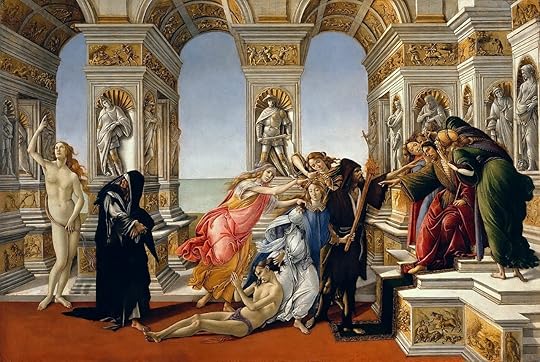 Î ÏÏ
κοÏανÏία ÏοÏ
ÎÏελλή (Botticelli, De calumnia, 1494-1495, ΦλÏÏενÏία, ÎÏ
ÏίÏÏι)
Î ÏÏ
κοÏανÏία ÏοÏ
ÎÏελλή (Botticelli, De calumnia, 1494-1495, ΦλÏÏενÏία, ÎÏ
ÏίÏÏι)Î Îιαβολή (ή ÏÏ ÎºÎ¿ÏανÏία) ÏÎ¿Ï ÎÏελλή (ÎÏαλικά: La Calunnia di Apelle, είναι ÏÎ¯Î½Î±ÎºÎ±Ï Î¶ÏγÏαÏÎ¹ÎºÎ®Ï Î±ÏÏ Ïον ÎÏÎ±Î»Ï ÎºÎ±Î»Î»Î¹ÏÎÏνη ÏÎ·Ï ÎναγÎννηÏÎ·Ï Î£Î¬Î½ÏÏο ÎÏοÏιÏÏÎλι. ΦιλοÏεÏνήθηκε ÏεÏίÏÎ¿Ï Ïο 1494 â 1495. ΣήμεÏα βÏίÏκεÏαι ÏÏη ÏÏ Î»Î»Î¿Î³Î® ÏÎ¿Ï Î¼Î¿Ï ÏÎµÎ¯Î¿Ï ÎÏ ÏίÏÏι ÏÏη ΦλÏÏενÏία, ÏÏην Î±Î¯Î¸Î¿Ï Ïα ÏÎ¿Ï ÎµÎ¯Î½Î±Î¹ αÏιεÏÏμÎνη ÏÏο μεγάλο Î´Î·Î¼Î¹Î¿Ï ÏγÏ. ΠΣάνÏÏο ÎÏοÏιÏÏÎλι άνÏληÏε Ïο θÎμα ÏÎ¿Ï Î±ÏÏ Îνα διάÏημο Ïίνακα ÏÎ¿Ï Îλληνα καλλιÏÎÏνη ÏÎ·Ï ÎµÎ»Î»Î·Î½Î¹ÏÏÎ¹ÎºÎ®Ï ÏεÏιÏÎ´Î¿Ï ÎÏελλή, ÏÏÏÏ Î±Ï ÏÏÏ ÏεÏιγÏάÏηκε αÏÏ Ïο ÎÎ¿Ï ÎºÎ¹Î±Î½Ï ÏÏον ÏÎÏαÏÏο ÏÏμο αÏÏ Ïα ογδÏνÏα ÏÏζÏμενα ÎÏγα ÏÎ¿Ï , ÏÏην ÏÏαγμαÏεία ÏÎ¿Ï Î ÎµÏὶ Ïοῦ μὴ ῥᾳδίÏÏ ÏιÏÏεÏειν διαβολá¿.ΠλÏÎ³Î¿Ï ÏÎ¿Ï Î¿ ÎÏÎµÎ»Î»Î®Ï ÏιλοÏÎÏνηÏε Ïον Ïίνακα Î±Ï ÏÏ Î®Ïαν ÎÎ½Î±Ï ÏÏÏÏÎ¿Ï Î½Î± ÏεÏιγÏάÏει Ïα ÏÏ Î½Î±Î¹ÏθήμαÏα θλίÏÎ·Ï ÎºÎ±Î¹ οÏÎ³Î®Ï ÏÎ¿Ï Î¿ Î¯Î´Î¹Î¿Ï ÎνιÏÏε ÏÏαν καÏηγοÏήθηκε άδικα, αÏÏ Îναν ανÏαγÏνιÏÏή ÏÎ¿Ï , Ïον ÎνÏίÏιλο, για Ïη δήθεν ÏÏ Î¼Î¼ÎµÏοÏή ÏÎ¿Ï ÏÏο Îγκλημα ÏÎ·Ï ÏÏ Î½ÏμοÏÎ¯Î±Ï ÎºÎ±Ïά ÏÎ¿Ï Î¦Î±ÏÎ±Ï ÏÎ·Ï ÎλληνιÏÏÎ¹ÎºÎ®Ï ÎιγÏÏÏÎ¿Ï , Î ÏÎ¿Î»ÎµÎ¼Î±Î¯Î¿Ï Îâ ÏÎ¿Ï Î£ÏÏήÏα. ÎÏαν αÏοδείÏÏηκε η αθÏÏÏηÏά ÏÎ¿Ï , αÏοÏάÏιÏε να μεÏαÏÎÏει Ïο ÏÏοÏÏÏÎ¹ÎºÏ ÏÎ¿Ï Î²Î¯Ïμα ÏÏον Ïίνακα Î±Ï ÏÏ. Το ÎÏγο δεν ÏÏζÏÏαν ÏÏÎ¹Ï Î¼ÎÏÎµÏ ÏÎ¿Ï ÎÏοÏιÏÏÎλι. ΩÏÏÏÏο η ÏεÏιγÏαÏή ÏÎ¿Ï ÎÎ¿Ï ÎºÎ¹Î±Î½Î¿Ï ÎµÎ¯Ïε μεÏαÏÏαÏÏεί ÎµÏ ÏÎÏÏ. ΣÏον Î´Î¹ÎºÏ ÏÎ¿Ï Ïίνακα, ο αναγεννηÏιακÏÏ Î¶ÏγÏάÏÎ¿Ï Î´Î¹Î±ÏήÏηÏε Ïο ÏÎºÎ·Î½Î¹ÎºÏ ÏÏήÏιμο ÏÏν μοÏÏÏν αÏÏ Ïην ÏεÏιγÏαÏή ÏÎ¿Ï ÎÎ¿Ï ÎºÎ¹Î±Î½Î¿Ï ÎºÎ±Î¹ δημιοÏÏγηÏε Îνα ÏεÏίÏεÏνα ÏÏολιÏμÎνο αÏÏιÏεκÏÎ¿Î½Î¹ÎºÏ ÏÏνÏο για εκείνεÏ.
ÎÎ Î ÎÎΣΩ ÎÎÎÎÎÎÎΡÎ[10]: ÎÏμα ÏÏ ÎºÎ¿ÏανÏÎ¯Î±Ï Ï ÏήÏξε κάÏοÏε και ο ÏεÏίÏÎ·Î¼Î¿Ï Î¶ÏγÏάÏÎ¿Ï ÏÎ·Ï ÎλληνιÏÏÎ¹ÎºÎ®Ï ÏεÏιÏÎ´Î¿Ï ÎÏελλήÏ, ο οÏÎ¿Î¯Î¿Ï ÎºÎ±ÏηγοÏήθηκε αÏÏ ÎºÎ¬Ïοιον ομÏÏεÏÎ½Ï ÏÎ¿Ï , Ïον ÎνÏίÏιλο, ÏÏÏ ÏÏ Î½ÏμÏÏηÏε ÏÏο ÏÎ»ÎµÏ ÏÏ ÏÎ¿Ï Î¥ÏάÏÏÎ¿Ï ÏÎ·Ï Î¤ÏÏÎ¿Ï ÎεοδÏÏα ενανÏίον ÏÎ¿Ï Î²Î±Ïιλιά ÏÎ·Ï ÎιγÏÏÏÎ¿Ï ÎºÎ±Î¹ ÎµÏ ÎµÏγÎÏη ÏÎ¿Ï , Î ÏÎ¿Î»ÎµÎ¼Î±Î¯Î¿Ï ÏÎ¿Ï ÎÎ. Î ÏεÏιÏÎÏεια ÏÎ¿Ï ÎÏελλή Îληξε γÏήγοÏα καθÏÏ Î±ÏοδείÏθηκε ÏÏÏ Î´ÎµÎ½ είÏε εÏιÏκεÏÏεί ÏοÏÎ ÏÎ¿Ï Ïην ΤÏÏο. ÎÏÎ ÏÏι ÏαίνεÏαι ÏμÏÏ Ïον ÏÏιγμάÏιÏε ÏÏÏο ÏÎ¿Ï Î¸ÎληÏε να αÏοÏÏ ÏÏÏει Ïην οδÏνη ÏÎ¿Ï Î¶ÏγÏαÏίζονÏÎ±Ï Îνα ÏÎ¿Î»Ï ÏÏνθεÏο ÎÏγο με ÏίÏλο «Îιαβολή». Î ÏÎ¯Î½Î±ÎºÎ±Ï Î´Ï ÏÏÏ ÏÏÏ Î´Îµ διαÏÏθηκε. ÎιÏÎ½ÎµÏ Î±ÏγÏÏεÏα ÏμÏÏ Î¿ ΣάνÏÏο ÎÏοÏιÏÏÎλλι εμÏÎ½ÎµÏ ÏμÎÎ½Î¿Ï Î±ÏÏ ÏÎ¹Ï Î»ÎµÏÏομεÏÎµÎ¯Ï ÏεÏιγÏαÏÎÏ ÏÎ¿Ï ÎÏÎ³Î¿Ï ÏÎ¿Ï ÎÏελλή ÏÎ¿Ï Î¿ ÎÎ¿Ï ÎºÎ¹Î±Î½ÏÏ Î±Î½ÎÏεÏε ÏÏην ÏÏαγμαÏεία ÏÎ¿Ï , «ΠεÏὶ Ïοῦ μὴ ῥᾳδίÏÏ ÏιÏÏεÏειν διαβολá¿Â», καÏάÏεÏε να Ïον αναÏαÏαγάγει και να αÏοδÏÏει με μεγάλη ÏαÏαÏÏαÏικÏÏηÏα Ïο δÏάμα ÏÎ¿Ï Î±ÏÏÎ±Î¯Î¿Ï Î¶ÏγÏάÏÎ¿Ï Î¼ÎµÏαÏÎÏονÏÎ¬Ï Ïο ÏÏην εÏοÏή ÏÎ¿Ï .
O ÎÎΣΣÎÎÎÎÎÎÎΥΣ ÎÎÎÎ. ÎÎÎÎΣ ΣΤÎÎ 'ÎÎΤΡÎÎΠΤΩΠÎÎÎΩÎ' ΤÎÎ¥ ÎÎ ÎΤÎΤΣÎÎÎÎ (Sandro Botticelli, âAdoration of the Magiâ, 1475-1476. Uffizi, Italy)
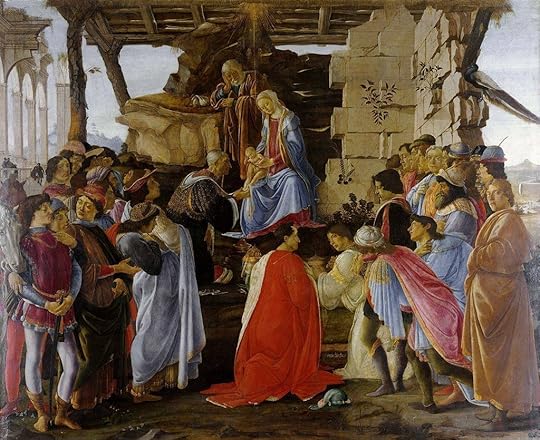
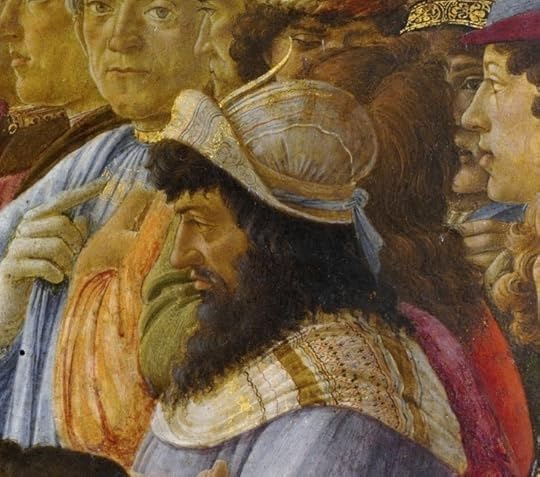
ÎκÏιβÏÏ Î±ÏιÏÏεÏά ÏÎ¿Ï ÎεοδÏÏÎ¿Ï Îαζή [Î Î. ÎαζήÏ, ο εÏονομαζÏÎ¼ÎµÎ½Î¿Ï ÎεÏÏαλονικεÏÏ Î® Thessalonicensis ÏÏα λαÏινικά, ήÏαν ÎÎ»Î»Î·Î½Î±Ï Î¿Ï Î¼Î±Î½Î¹ÏÏήÏ, μεÏαÏÏαÏÏÎ®Ï ÏÎ¿Ï ÎÏιÏÏοÏÎÎ»Î¿Ï Ï, εÏιÏÏÎ®Î¼Î¿Î½Î±Ï ÎºÎ±Î¹ λÏÎ³Î¹Î¿Ï ÏÎ¿Ï 15Î¿Ï Î±Î¹ÏνοÏ, διακÏίθηκε ÏÏην λεγομÎνη Î ÎÎÎÎÎÎÎÎÎÎÎ ÎÎÎÎÎÎÎÎΣÎ!] ÏÏÎκεÏαι ο ÏοÏηγÏÏ ÏÎ¿Ï Ïίνακα, Lorenzo Medici, ÏÏα μαÏÏα και δεξιά ο Î¯Î´Î¹Î¿Ï Î¿ ζÏγÏάÏÎ¿Ï Sandro Botticelli με ÏοÏÏοκαλί μανδÏα. ÎÎ½Ï Î¿ Î³Î¹Î¿Ï ÏÎ¿Ï Î Î¹ÎÏÏο ÏÏ Î´ÎµÏÏεÏÎ¿Ï ÎÎ¬Î³Î¿Ï Î³Î¿Î½Î±Ïίζει ÏÏο κÎνÏÏο ÏÎ·Ï ÎµÎ¹ÎºÏÎ½Î±Ï Î¼Îµ κÏκκινο μανδÏα, δίÏλα ÏÎ¿Ï ÎµÎ¯Î½Î±Î¹ ο αδεÏÏÏÏ ÏÎ¿Ï Î¤Î¶Î¹Î¿Î²Î¬Î½Î¹ ÏÏ ÏÏίÏÎ¿Ï ÎÎ¬Î³Î¿Ï ÎµÎ½Ï Î±ÏεικονίζονÏαι και Ïα εγγÏνια ÏÎ¿Ï ÎÏζιμο, Î¤Î¶Î¿Ï Î»Î¹Î¬Î½Î¿ και ÎοÏÎνÏζο. Îι ÏÏÎµÎ¹Ï ÎÎδικοι ÏÎ¿Ï ÏαÏÎ¿Ï Ïίαζαν ÏÎ¿Ï Ï ÏÏÎµÎ¹Ï ÎÎ¬Î³Î¿Ï Ï ÎµÎ¯Ïαν ήδη Ïεθάνει Ïην ÏÏιγμή ÏÎ·Ï Î´Î·Î¼Î¹Î¿Ï ÏÎ³Î¯Î±Ï Î±Ï ÏÎ¿Ï ÏÎ¿Ï Ïίνακα και η ΦλÏÏενÏία ÎµÎºÏ Î²ÎµÏνάÏο αÏÏ Ïον ÎοÏÎνÏζο, ÏÏοÏανÏÏ Î¼ÎµÎ³Î¬Î»Î¿ Î¸Î±Ï Î¼Î±ÏÏή ÏÎ¿Ï Îαζή, ÏÎ¿Ï Î²ÏιÏκÏÏαν ακÏιβÏÏ ÏίÏÏ Î±ÏÏ Ïην ÏλάÏη ÏÎ¿Ï .-------------------------------------------------------------------Immediately to the left of Theodor Gaza stands the client of the painting, Lorenzo Medici, in black, and to the right is the painter Sandro Botticelli himself, in an orange cloak. While his son Piettro as the second Magi kneels in the center of the picture in a red cloak, next to him are his brother Giovanni as the third Magi and Cosimo's grandchildren Giuliano and Lorenzo pictured. Three Mediciâs presenting three Magiâs had already died at the time of creation of this painting, and Florence was ruled by Lorenzo, obviously very fond of Gaza, located just behind his back.
.. From 1440 to 1449, as the successor of the Byzantine Nicholas Secundinus, Gaza taught Greek while studying at Ferrara. His service in that city was the first sign of the dispersal of Greek learning in the European West, as it took place only a few decades after Chrysoloras' first systematic lectures on the Greek language in the Renaissance at a Florentine Studium. Gaza's lectures were so successful that in1449 he was appointed the first rector of the University of Ferrara after its renewal by Duke Lionello d'Este.Gaza's surviving inaugural speech, âOn Greek Writersâ (âDe litteris graecisâ), is probably the earliest surviving inaugural presentation on the importance of Greek studies held in Italy by an emigrant Byzantine scholar. Manuel Chrysoloras' earlier presentation in Florence has not been preserved. In hispresentation, Gaza emphasized that the ancient Romans also had extensive knowledge of Greek literature and its invaluable value for active participation in political life. According to Gaza, leading Roman political figures sent their sons to study in Greece. SOURCE: The Byzantine Renaissance as the predominant source and impetus for the Italian Renaissance - Theodore Gaza in Mantua, Ferrara, Rome and Naples and Nicolaos Leonicos Tomeos in Venice, Florence and Padua - <https://www.researchgate.net/.../3516... ΠΣΧÎÎΠΤΩΠÎÎÎÎΩΠ- ΡÎΦÎÎÎ -->
Î ÎÏ Î¶Î±Î½Ïινή [ΠαλαιολÏγεια] ÎναγÎννηÏη ÏÏ Î· ÎºÏ ÏίαÏÏη Ïηγή και ÏθηÏη για Ïην ÎÏαλική ÎναγÎννηÏη[20]
«ΠÎÏ Î¶Î±Î½Ïινή ÎναγÎννηÏη ÏÏ Ïο κοÏÏ Ïαίο θεμÎλιο ÏÎ·Ï ÎÏÎ±Î»Î¹ÎºÎ®Ï ÎναγÎννηÏηÏ: ÎεÏδÏÏÎ¿Ï ÎÎ±Î¶Î®Ï ÏÏην ÎάνÏοβα, ΦεÏάÏα, ΡÏμη και ÎάÏολη και ÎικÏÎ»Î±Î¿Ï ÎεÏÎ½Î¹ÎºÎ¿Ï ÎÏμεÏÏ ÏÏην ÎενεÏία, ΦλÏÏενÏία και ΠάνÏοβα" ÎÏο ακÏμη άÏομα ÏÏν οÏοίÏν η άÏιξη ÏÏην ÎÏαλία βοήθηÏε ÏάÏα ÏÎ¿Î»Ï Î½Î± καÏÎµÏ Î¸Ïνει Ïον Ï ÏάÏÏονÏα ÎνθÏÏÏιÏÎ¼Ï Î±ÏÏ Î±Ï Ïήν Ïην αÏÏική ÎμÏαÏη ÏÎ¿Ï ÏηÏοÏÎ¹ÎºÎ¿Ï Ï ÏήÏξαν οι Î²Ï Î¶Î±Î½Ïινοί καθηγηÏÎÏ ÎεÏδÏÏÎ¿Ï ÎÎ±Î¶Î®Ï ÎºÎ±Î¹ ÎικÏÎ»Î±Î¿Ï ÎεÏÎ½Î¹ÎºÎ¿Ï ÎÏμεÏÏ, ÏÎ¿Ï ÎºÎ±Î¹ οι δÏο ÏÏοήδÏÎµÏ Ïαν εδÏÏν αÏιεÏÏμÎνÏν ÏÏην ελληνική ÏιλοÏοÏία Ïε ÏανεÏιÏÏήμια ÏÎ·Ï ÎÏÎ±Î»Î¹ÎºÎ®Ï Î§ÎµÏÏονήÏÎ¿Ï . ΠκαÏιÎÏα ÏÎ¿Ï Ï Î¼ÏοÏεί να είναι διÏαÏμÎνη Ïε διαÏοÏεÏικÎÏ Î¼ÎµÎ³Î¬Î»ÎµÏ ÏάÏειÏ. ÎÏιÏμÎνα ÏÏάδια είναι ανεÏαÏκÏÏ Î³Î½ÏÏÏά λÏÎ³Ï ÎµÎ»Î»ÎµÎ¯ÏεÏÏ ÏÏÏÏν ÏÏιν αÏÏ Ïην ÏÏÏÏη ÏÎ·Ï ÎÏνÏÏανÏÎ¹Î½Î¿Ï ÏÏλεÏÏ ÏÏα ÏÎ¿Ï Ïκικά ÏÎÏια Ïο 1453. Îλλα, αÏκεÏά μεγαλÏÏεÏÎ·Ï Î´Î¹Î¬ÏÎºÎµÎ¹Î±Ï ÎºÎ±Î¹ Ïιο ÏημανÏικά για Ïην ιÏαλική ÎναγÎννηÏη, ÏαÏÎ¿Ï ÏÎ¹Î¬Î¶Î¿Ï Î½ ÏÎ¿Ï Ï Î²Ï Î¶Î±Î½ÏινοÏÏ Î»ÏÎ³Î¹Î¿Ï Ï ÏÏ Î»ÎκÏοÏÎµÏ ÏÎ¿Ï Î±ÏαÏÏολοÏνÏαι Ïε Ïλην Ïην ÎÏαλία, Ïην εÏοÏή ÏÎ¿Ï Î±Ï Ïή η ÏÏÏα Îμελλε να ÏÏάÏει ÏÏο αÏÏγειο ÏÎ·Ï ÏÎ®Î¼Î·Ï ÏÎ·Ï ÏÏ Ïο κÎνÏÏο ÏÎ¿Ï ÎνθÏÏÏιÏμοÏ.Π«ÎνθÏÏÏÎ¿Ï ÏÎ·Ï ÎναγεννήÏεÏÏ», ÎÎ½Î±Ï Î¬Î½Î¸ÏÏÏÎ¿Ï Î¼Îµ ÎµÏ ÏÏ Ïεδίο ÏκÎÏεÏν και ÏÏάξεÏν, ÎÎ½Î±Ï ÏαγκοÏÎ¼Î¯Î¿Ï ÏÎ®Î¼Î·Ï ÏÏÎ¿Ï ÏÎ¿Ï ÏÏ Î½Î®Î¸ÏÏ ÎµÏαÏμÏζεÏαι ÏÏον ιÏÎ±Î»Î¹ÎºÏ Î¿Ï Î¼Î±Î½Î¹ÏÎ¼Ï ÎºÎ±Î¹ Ïην αναγÎννηÏη, ÏÏοÏανÏÏ Î±Î½Î®ÎºÎµÎ¹ ÏÏÏÏα και κÏÏια ÏÏÎ¿Ï Ï Î²Ï Î¶Î±Î½ÏινοÏÏ Î¼ÎµÎ»ÎµÏηÏÎÏ.ÎÏÏÏ ÏαίνεÏαι ξεκάθαÏα εδÏ, η Ïίζα ÏÎ¿Ï ÏÏÎ¿Ï ÎºÎ±Î¹ ÏÎ·Ï Î¿Ï ÏÎ¯Î±Ï ÏÎ¿Ï Â«ÎνθÏÏÏÎ¿Ï ÏÎ·Ï ÎναγεννήÏεÏÏ» ÎγκειÏαι ÏÏην ÏÏαγμαÏικÏÏηÏα ÏÏην Îλληνική και ÎÏ Î¶Î±Î½Ïινή «εγκÏκλειο Ïαιδεία», ÏÏÏÏ ÎºÎ±Î¹ Ïην «ÏÎ¿Î»Ï Î¸ÎµÎ¼Î±Ïική θεÏÏηÏη», κÏÏια ÏαÏακÏηÏιÏÏικά ενÏÏ ÎµÎºÏÎ±Î¹Î´ÎµÏ ÏÎ¹ÎºÎ¿Ï ÏÏ ÏÏήμαÏÎ¿Ï ÏÎ·Ï Î±Ï ÏοκÏαÏοÏÎ¯Î±Ï ÏÎ¿Ï ÏÏÏÏοÏοÏοÏÏε Ïε ÏÎ»Î¿Ï Ï ÏÎ¿Ï Ï ÎºÎ»Î¬Î´Î¿Ï Ï ÏÏην ανεÏÏÏ Î³Î¼Îνη ÎÏ ÏÏÏη και Ïην ÎεÏÏγειο για ÏεÏιÏÏÏÏεÏÎ¿Ï Ï Î±ÏÏ Îνδεκα αιÏνεÏ, καÏά Ïον ίδιο ÏÏÏÏο ÏÎ¿Ï Ïο ΠανεÏιÏÏήμιο ÏÎ·Ï ÎαγναÏÏÎ±Ï Î® ΠανδιδακÏήÏιο ή ÎÎ±Î¸Î¿Î»Î¹ÎºÏ Î Î±Î½/μιο ÏÎ·Ï ÎÏνÏÏανÏÎ¹Î½Î¿Ï ÏÏλεÏÏ, η ÎδÏα ÏÎ·Ï Î¿ÏÎ¿Î¯Î±Ï ÎµÏÏημαÏοδοÏείÏο αÏÏ Ïον ΣÎÏβο ΤÏάÏο ÎÏÏÎ¿Ï Ïον ÎδÏναμο (!?)[ΠΣÏÎÏÎ±Î½Î¿Ï ÎÏÏÎ¿Ï ÎÎ ÎÏοÏÏαν, γνÏÏÏÏÏ ÏÏ ÎÏοÏÏαν ο ÎÏÏÏ ÏÏÏ ÎºÎ±Î¹ ÏÏα ελληνικά ÏÏ Î£ÏÎÏÎ±Î½Î¿Ï ÎÎ¿Ï Ïάν, ήÏαν βαÏÎ¹Î»Î¹Î¬Ï ÏÎ·Ï Î£ÎµÏÎ²Î¯Î±Ï Î±ÏÏ ÏÎ¹Ï 8 ΣεÏÏεμβÏÎ¯Î¿Ï 1331 και ÎÏ ÏοκÏάÏοÏÎ±Ï Î£ÎÏβÏν, ÎλλήνÏν, ÎÎ¿Ï Î»Î³Î¬ÏÏν, ÎλάÏÏν και ÎλβανÏν αÏÏ ÏÎ¹Ï 16 ÎÏÏÎ¹Î»Î¯Î¿Ï 1346 μÎÏÏι Ïον θάναÏÏ ÏÎ¿Ï ], ήÏαν Ïο κοÏÏ Ïαίο ίδÏÏ Î¼Î± για ÏÏεδÏν μια ÏιλιεÏία ÏÏιν αÏÏ Ïην ίδÏÏ Ïη ÏÏν ÏανεÏιÏÏημίÏν ÏÎ·Ï ÎÏολÏνια, ÏÎ·Ï Î Î¬Î½ÏοβαÏ, ÏÎ·Ï Î£Î¿ÏβÏÎ½Î½Î·Ï ÎºÎ±Î¹ ÏÎ·Ï ÎξÏÏÏδηÏ.ÎÏÏ ÎµÎºÎµÎ¯ ακÏιβÏÏ ÏÏοÎÏÏεÏαι η ιÏαλική ÎναγÎννηÏη. ------------------------------------------------------------------- The Byzantine Renaissance as the predominant source and impetus for the Italian Renaissance âThe Byzantine Renaissance as the premier foundation of the Italian Renaissance: Theodore Gaza in Mantova, Ferrara, Rome and Naples and Nikolaos Leonikostomeos in Venice, Florence and Paduaâ Two more persons whose arrival in Italy helped immensely to direct the existing Humanism from its original rhetorician emphasis were Byzantine professors Theodoros Gaza and Niccolo Leonico Tomeo, who both chaired a Greek philosophy at universities around the peninsula. Their careers may be divided into different large phases. Certain stages are insufficiently known due to a lack of resources before thefall of the Byzantine capital Constantinople into Turkish hands in 1453. Other, considerably longer and more important for the Italian Renaissance, represents Byzantine scholars as lecturers employed throughout Italy, at the time when this country was about to reach the height of its fame as a Humanism center.The âRenaissance Manâ, a man with broad scopes of thoughts and deeds, a world-renowned term usually applied to Italian Humanism and Renaissance, obviously belongs first and foremost to Byzantine scholars.As clearly visible here, the root of the term and essence of a âRenaissance Manâ actually is in Greek and Byzantine âenkyklios paideiaâ, as âall embracing thoughtfulnessâ, main characteristics of an educational system of the empire that was leading in all terms and most developed in Europe and the Mediterranean for more than eleven centuries, in as much as Constantinopleâs Catholicon University, the headquarters of which were financed by Serbian Tsar UroÅ¡ the Weak (!?), was the leading one for nearly a millennium before Bologna, Padua, Sorbonne and Oxford universities were established.That is exactly where an Italian Renaissance is coming from. Predrag MiloÅ¡eviÄ -->
ΠΠΡΩΤÎÎÎÎÎΣ ÎΩÎΡÎΦÎÎΩΠΤÎÎ ÎÎÎΥΣΠ(ÎΡÎΠΤÎÎ¥ Giorgio Vasari, 1540s. Vasari's House, Arezzo)[1000]
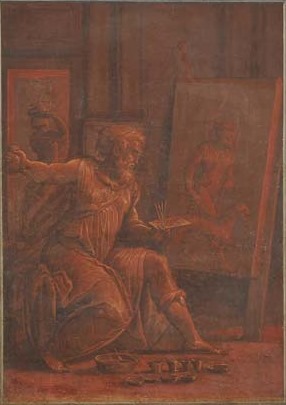
ΠζÏγÏάÏÎ¿Ï Î ÏÏÏογÎÎ½Î·Ï Î®Ïαν διάÏÎ·Î¼Î¿Ï Î³Î¹Î± Îναν Ïίνακα ÏÎ¿Ï Î±ÏεικÏνιζε Ïον ήÏÏα ÎÎ¬Î»Ï Ïο ÏÏην ΡÏδο, για Ïην ολοκλήÏÏÏη ÏÎ¿Ï Î¿ÏÎ¿Î¯Î¿Ï ÎµÏγάÏÏηκε εÏÏά ÏÏÏνια. ÎÏαν μάλιÏÏα ο ÏÎ¯Î½Î±ÎºÎ±Ï Î²ÏιÏκÏÏαν ÏÏο ÏÎµÎ»Î¹ÎºÏ ÏÏάδιο, Ïο 305-304 Ï.Χ., ο ÎημήÏÏÎ¹Î¿Ï Î Î¿Î»Î¹Î¿ÏκηÏÎ®Ï ÎµÎ¾ÎµÏÏÏάÏÎµÏ Ïε ενανÏίον ÏÎ·Ï Î¡ÏÎ´Î¿Ï ÎºÎ±Î¹, αÏÏ ÏεβαÏÎ¼Ï ÏÏÎ¿Ï Îνα ÏÏÏο εξαιÏεÏÎ¹ÎºÏ ÎÏγο ÏÎÏνηÏ, διÎÏαξε Ïα ÏÏÏαÏεÏμαÏά ÏÎ¿Ï Î½Î± μην ÏÏ ÏÏολήÏÎ¿Ï Î½ Ïην ÏÏλη. ÎαÏά Ïη διάÏκεια ÏÎ·Ï ÏολιοÏκίαÏ, ο καλλιÏÎÏÎ½Î·Ï ÏÏ Î½ÎÏιÏε να εÏγάζεÏαι αμÎÏιμνοÏ, λÎγονÏÎ±Ï ÏαÏακÏηÏιÏÏικά ÏÏι ο βαÏÎ¹Î»Î¹Î¬Ï Îκανε ÏÏλεμο ενανÏίον ÏÎ·Ï Î¡ÏÎ´Î¿Ï ÎºÎ±Î¹ ÏÏι ενανÏίον ÏÏν ÏεÏνÏν. Î ÎημήÏÏÎ¹Î¿Ï ÎθεÏε Ï ÏÏ ÏÏοÏÏηÏη Ïον Î ÏÏÏογÎνη, για να διαÏÏαλίÏει Ïη ÏÏμαÏική ÏÎ¿Ï Î±ÎºÎµÏαιÏÏηÏα. Î¥ÏÏ Î±Ï ÏÎÏ ÏÎ¹Ï ÏÏ Î½Î¸Î®ÎºÎµÏ Î¿ καλλιÏÎÏÎ½Î·Ï Î¶ÏγÏάÏιÏε Ïον ÏεÏίÏημο ÎναÏÎ±Ï Ïμενο ΣάÏÏ ÏÏ ÏÎ¿Ï . ................. ..................................................................................................... ΣÏο ÎÏγο Î¦Ï Ïική ÎÏÏοÏία (Naturalis Historia) ÏÎ¿Ï Î Î»Î¹Î½Î¯Î¿Ï , ο Î ÏÏÏογÎÎ½Î·Ï Î±Î½Î±ÏÎÏεÏαι ÏÏ Î¿ Ïιο διάÏÎ·Î¼Î¿Ï Î¶ÏγÏάÏÎ¿Ï ÏÎ¿Ï ÏεÏάÏÏÎ¿Ï Î±Î¹Ïνα Ï.Χ. μαζί με Ïον ÎÏελλή, ÏεÏιγÏάÏεÏαι δε ÏÏ ÎºÎ±Î»Î»Î¹ÏÎÏÎ½Î·Ï ÏÎ¿Ï Î´Î¯Î½ÎµÎ¹ ιδιαίÏεÏη ÏÏοÏοÏή ÏÏην λεÏÏομÎÏεια. ΣÏμÏÏνα με Ïον Πλίνιο, ÏÏαν ο Î ÏÏÏογÎÎ½Î·Ï Î¶ÏγÏάÏιζε Ïο Ïιο διάÏημο ÎÏγο ÏÎ¿Ï - ο ÎºÏ Î½Î·Î³ÏÏ ÎÎ±Î»Ï ÏÏÏ ÏÏ Î½Î¿Î´ÎµÏ ÏÎ¼ÎµÎ½Î¿Ï Î±ÏÏ Ïον ÏκÏλο ÏÎ¿Ï - δοÏλεÏε αÏÏαμάÏηÏα Ïε μία λεÏÏομÎÏεια, ÏάÏνονÏÎ±Ï Îναν ÏÏÏÏο αÏεικονίÏεÏÏ ÏÎ¿Ï Î±ÏÏÎ¿Ï Î³ÏÏÏ Î±ÏÏ Ïο ÏÏÏμα ÏÎ¿Ï ÏκÏÎ»Î¿Ï , ÎÏÏ ÏÏÎ¿Ï ÎµÎ¾Î¿ÏγίÏÏηκε και ÎÏιξε Îνα ÏÏÎ¿Ï Î³Î³Î¬Ïι ÏÏην εικÏνα. ÎÏ ÏÏ Î¬ÏηÏε ÏÏι ο Botticelli ίÏÏÏ Î¸Î± είÏε οÏίÏει ÏÏ 'Îνα ίÏνοÏ', ÏÏο οÏοίο ο Î ÏÏÏογÎÎ½Î·Ï Î±Î½Î±Î³Î½ÏÏιÏε ÏÏι εÏιÏÏ Î³ÏάνεÏο ÏÏ Ïαία Ïο αÏοÏÎλεÏμα για Ïο οÏοίο είÏε ÏÏοÏÏαθήÏει ÏÏÏο κοÏιαÏÏικά. ÎÏ ÏÏ Ïο εÏειÏÏδιο, μαζί με άλλα ανÎκδοÏα ÏÎ¿Ï Î Î»Î¹Î½Î¯Î¿Ï Î³Î¹Î± ÏÎ¿Ï Ï Î¼ÎµÎ³Î¬Î»Î¿Ï Ï Î¶ÏγÏάÏÎ¿Ï Ï ÏÎ·Ï Î±ÏÏαιÏÏηÏαÏ, αÏεικονίζεÏαι Ïε μια ÏοιÏογÏαÏία ζÏγÏαÏιÏμÎνη αÏÏ Ïον Vasari ÏÏην οικία ÏÎ¿Ï ÏÏο ÎÏÎÏÏο. ........ "ÎιαÏί αÏλÏÏ ÏίÏνονÏÎ±Ï Îνα ÏÏÎ¿Ï Î³Î³Î¬Ïι γεμάÏο με διαÏοÏεÏικά ÏÏÏμαÏα ÏÏον ÏοίÏο, Î´Î·Î¼Î¹Î¿Ï ÏγείÏε ÎνανλεκÎ, ÏÏον οÏοίο μÏοÏείÏε να δείÏε μια ÏμοÏÏη αÏεικÏνιÏη ÏοÏÎ¯Î¿Ï .' ΦαίνεÏαι ÏÏι με Î±Ï ÏÎÏ ÏÎ¹Ï Î»ÎξειÏ, ÏÎ¹Ï Î¿ÏÎ¿Î¯ÎµÏ ÏαÏαθÎÏει με εÏιμÎλεια ο ÎεονάÏνÏο ÏÏο Libro di Pittura, ο Botticelli δικαιολογεί Ïην αδιαÏοÏία ÏÎ¿Ï Î³Î¹Î± Ïην ζÏγÏαÏική ÏοÏÎ¯Î¿Ï . Το ÏÏÏÏÏÏÏ Ïο κείμενο ÏÎ¿Ï da Vinci ÎÏει ÎÏει Ïαθεί, αλλά ο κÏÎ´Î¹ÎºÎ±Ï ÏÏην ÎÏοÏÏολική Îιβλιοθήκη ÏÎ¿Ï ÎαÏÎ¹ÎºÎ±Î½Î¿Ï ÏÏην οÏοία Ïο αÏÏÏÏαÏμα ÎÏει αναÏαÏαÏθεί θεÏÏείÏαι ÏÎ¿Î»Ï Î±Î¾Î¹ÏÏιÏÏη. Î Î±Ï 'Ïλα Î±Ï Ïά, ο Horne εξÎÏÏαÏε αμÏιβολία ÏÏ ÏÏÎ¿Ï Ïην ειλικÏίνεια ÏÎ·Ï Î´Î·Î»ÏÏεÏÏ ÏÎ¿Ï ÎÏοÏιÏÏÎλι, ÏÎ¿Ï , καÏά Ïη γνÏμη ÏÎ¿Ï , δεν μÏοÏοÏÏε να διαβαÏÏεί με οÏοιονδήÏοÏε άλλο ÏÏÏÏο εκÏÏÏ Î±ÏÏ "ÏαÏάδοξο ÏÏÏ Î»" ÏαÏακÏηÏιÏÏÎ¹ÎºÏ ÏÎ¿Ï ÎºÎ±Î»Î»Î¹ÏÎÏνη ÏÎ·Ï Î¦Î»ÏÏενÏίαÏ. ΣÏην ÏÏαγμαÏικÏÏηÏα, είναι αÏίθανο ÏÏι ο ÎÏοÏιÏÏÎλι θα μÏοÏοÏÏε ÏοβαÏά να ÏÏολιάÏει Ïην ζÏγÏαÏική ÏοÏÎ¯Î¿Ï Î¼Îµ Î±Ï ÏοÏÏ ÏÎ¿Ï Ï ÏÏÎ¿Ï Ï ÎºÎ±Î¹ αν ÏÏηÏιμοÏοιοÏÏε Ïην ακÏαία εικÏνα ÏÎ¿Ï Î»ÎµÎºÎ ÏÏον ÏοίÏο ÏÏ Ï ÏοκαÏάÏÏαÏο ÏÎ¿Ï 'ÏμοÏÏÎ¿Ï ÏοÏÎ¯Î¿Ï ' θα ήÏαν μÏνο Ïε ÏÏÎÏη με Ïο ανÎκδοÏο ÏÎ¿Ï Î Î»Î¹Î½Î¯Î¿Ï Î³Î¹Î± Îναν αÏÏ ÏÎ¿Ï Ï Ïιο διάÏÎ·Î¼Î¿Ï Ï Î¶ÏγÏάÏÎ¿Ï Ï ÏÎ·Ï Î±ÏÏαιÏÏηÏαÏ, Ïον Î ÏÏÏογÎνη ...
ÎÎ½Î±Î´Ï Î¿Î¼Îνη ÎÏÏοδίÏη & Botticelli[1100]
 MFA AC. NR. 1982.286, ÏÏ
ÏÏεÏιÏθείÏα με Ïην ÎλεοÏάÏÏα η οÏοία αναδÏ
ομÎνη ÏÏ
νανÏά Ïον ÎνÏÏνιο, Ïην ÎÏία Πελαγία - ÎαÏγαÏίÏα ÎºÎ»Ï (γενειοÏÏÏο ή μή)
MFA AC. NR. 1982.286, ÏÏ
ÏÏεÏιÏθείÏα με Ïην ÎλεοÏάÏÏα η οÏοία αναδÏ
ομÎνη ÏÏ
νανÏά Ïον ÎνÏÏνιο, Ïην ÎÏία Πελαγία - ÎαÏγαÏίÏα ÎºÎ»Ï (γενειοÏÏÏο ή μή)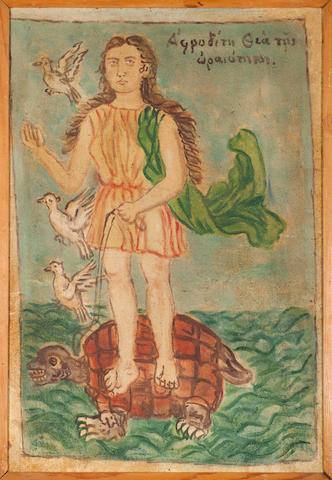 ÎναδÏ
ομÎνη ÏοÏ
ÎεοÏίλοÏ
ÎναδÏ
ομÎνη ÏοÏ
ÎεοÏίλοÏ
Î ÏοÏÏÏογÏαÏία νεÏÎ±Ï Î³Ï Î½Î±Î¯ÎºÎ±Ï[1200]Portrait of a Young Woman is a painting which is commonly believed to be by the Italian Renaissance painter Sandro Botticelli, executed between 1480 and 1485. The woman is shown in profile but with her bust reveal a cameo medallion she is wearing around her neck. The medallion is a copy in reverse of "Nero's Seal" (**), a famous antique carnelian representing Apollo and Marsyas, which belonged to Lorenzo de' Medici . The art historian Aby Warburg first suggested the painting was an idealised portrait of Simonetta Vespucci. This challenged a previous interpretation, put forward by German scholars, according to which the painting describes an ideally beautiful young woman mythologised as a nymph or goddess, a view reflected in the title given it by the Städel. It belongs to a group of such paintings by Botticelli or his workshop. Art historian Emanuele Lugli has suggested that the three "tassels" of hair at the center of the painting represents downward flames, symbolising the love that onlookers ought to experience when looking at the portrait since, in the Renaissance it was thought that "hair inflames desire.
(**)In the story about Apollo and Marsyas, a Phrygian mortal named Marsyas, who may have been a satyr, ( satyrs are one of a class of lustful, drunken woodland gods. In Greek art they were represented as a man with a horse's ears and tail, but in Roman representations as a man with a goat's ears, tail, legs, and horns.) who boasted about his musical skill on the aulos. The aulos was a double-reed flute. The instrument has multiple origin stories. In one, Marsyas found the instrument after Athena had abandoned it. In another origin story, Marsyas invented the aulos. Cleopatra's father evidently also played this instrument, since he was known as Ptolemy Auletes. Marsyas claimed he could produce music on his pipes far superior to that of the cithara-plucking Apollo. Some versions of this myth say it was Athena who punished Marsyas for daring to pick up the instrument she had discarded (because it had disfigured her face when she puffed out her cheeks to blow). In response to the mortal braggadocio, different versions hold that either the god challenged Marsyas to a contest or Marsyas challenged the god. The loser would have to pay a gruesome price. In their music contest, Apollo and Marsyas took turns on their instruments: Apollo on his stringed cithara and Marsyas on his double-pipe aulos. Although Apollo is the god of music, he faced a worthy opponent: musically speaking, that is. Were Marsyas truly an opponent worthy of a god, there would be little more to be said. The deciding judges are also different in different versions of the story. One holds that the Muses judged the wind vs. string contest and another version says it was Midas, king of Phrygia. Marsyas and Apollo were almost equal for the first round, and so the Muses judged Marsyas the victor, but Apollo had not yet given up. Depending on the variation you are reading, either Apollo turned his instrument upside down to play the same tune, or he sang to the accompaniment of his lyre. Since Marsyas could neither blow into the wrong and widely separate ends of his aulos, nor singâeven assuming his voice could have been a match for that of the god of musicâwhile blowing into his pipes, he did not stand a chance in either version. Apollo won and claimed the prize of the victor that they had agreed upon before beginning the contest. Apollo could do whatever he wished to Marsyas. So Marsyas paid for his hubris by being pinned to a tree and flayed alive by Apollo.The short story is ; `Nero`s seal` was a hidden message given by Botticelli ; `do not challenge god` Sandro Botticelli was fundamentalist religious man of early Renausans .
'ÎÎ¥ÎÎÎÎÎΣ ΣΤΠΠÎΡÎÎΥΡÎ': ÎΠΠΤÎÎ ÎÎÎΩÎΤΠ& ÎÎ¥ÎÎÎÎÎΠΤÎÎΧÎÎΡÎΦΠΣΤÎÎ ÎÎ ÎÎÎÎÎÎÎÎΥΨΠΤÎΣ ÎÎÎÎÎΤÎÎÎÎΣ ÎΠΠΤÎÎ BOTICELLI .. ÎΤÎÎ Î ÎÎ¥ÎÎÎÎÎ Î ÎΡÎÎÎÎ ÎÎ ÎÎΡΡÎΣ ΤΠ'ÎΡÎÎ'![1300]
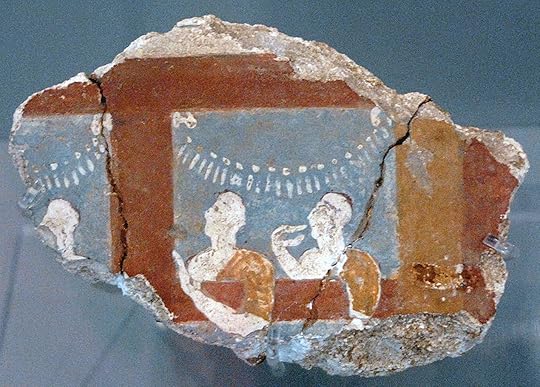 âWomen in a loggiaâ from ramp house deposit, Mycenae 'ÎÏ
Î½Î±Î¯ÎºÎµÏ ÏÏο θεÏÏείο' ÎÏ
κήναι
âWomen in a loggiaâ from ramp house deposit, Mycenae 'ÎÏ
Î½Î±Î¯ÎºÎµÏ ÏÏο θεÏÏείο' ÎÏ
κήναι Botticelliâs Portrait of Smeralda Bandinelli, c147l, âbreaking the frameâ.
Botticelliâs Portrait of Smeralda Bandinelli, c147l, âbreaking the frameâ.
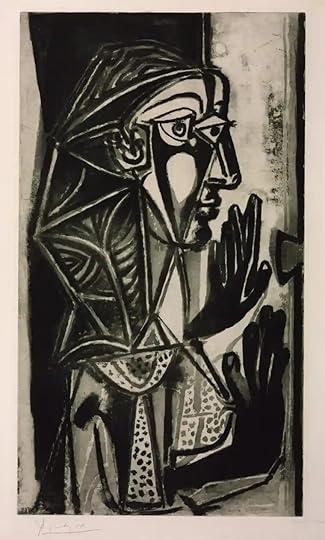 Pablo Picasso, âLa femme à la fenêtreâ (1952) © Succession Picasso/DACS, London 2021. Photo: Tate
Pablo Picasso, âLa femme à la fenêtreâ (1952) © Succession Picasso/DACS, London 2021. Photo: Tate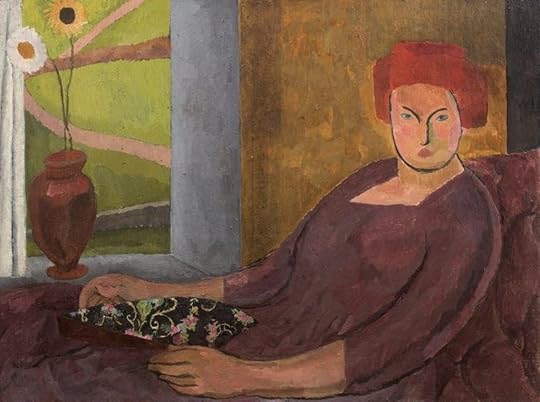 Woman in a Red Hat (c. 1915) : Vanessa Bell
Woman in a Red Hat (c. 1915) : Vanessa BellΧÏονολογοÏμενη ÏεÏίÏÎ¿Ï Î±ÏÏ Ïο 1475, Î±Ï Ïή η ÏÏοÏÏÏογÏαÏία ÏÏιÏν ÏεÏάÏÏÏν ÏÎÏει μια Ïαλαιά εÏιγÏαÏή ÏÏο ÏεÏβάζι ÏÎ¿Ï Î±ÏεικονίζεÏαι ÏÏο κάÏÏ Î¼ÎÏÎ¿Ï ÏÎ·Ï ÎµÎ¹ÎºÏναÏ, ÏÎ¿Ï Î¿Î´Î®Î³Î·Ïε ÏÎ¿Ï Ï Î¹ÏÏοÏικοÏÏ ÏÏο ÏαÏελθÏν να ÏÎ±Ï ÏοÏοιήÏÎ¿Ï Î½ Ïην καθήμενη ÏÏ Smeralda di M. Bandinelli Moglie di VI, ÏÎ¿Ï ÏιÏÏεÏεÏαι ÏÏι είναι η γιαγιά ÏÎ¿Ï Î³Î»ÏÏÏη Baccio Bandinelli. ΩÏÏÏÏο, είναι ÏÎ¹Î¸Î±Î½Ï ÏÏι η εÏιγÏαÏή να ÏÏοÏÏÎθηκε αÏγÏÏεÏα, καθÏÏ Î¿ γλÏÏÏÎ·Ï ÏήÏε Î±Ï ÏÏ Ïο εÏÏÎ½Ï Î¼Î¿ μÏνο Ïο 1530. ÎÏÏ Ïα αÏÏειακά ÏεκμήÏια είναι γνÏÏÏÏ ÏÏι Ïο 1469 η Smeralda ήÏαν ÏÏιάνÏα εÏÏν. ÎÏει ÏÏοÏαθεί ÏÏι η ÏÏοÏÏÏογÏαÏία ζÏγÏαÏίÏÏηκε αÏÏ Îναν αÏÏ ÏÎ¿Ï Ï Î²Î¿Î·Î¸Î¿ÏÏ ÏÎ¿Ï Botticelli καÏά Ïη διάÏκεια ÏÎ·Ï Î´ÎµÎºÎ±ÎµÏÎ¯Î±Ï ÏÎ¿Ï 1470, ÎµÎ½Ï Î¬Î»Î»Î¿Î¹ ÎµÎ¾Î±ÎºÎ¿Î»Î¿Ï Î¸Î¿Ïν να ÏιÏÏεÏÎ¿Ï Î½ ÏÏι αÏοÏελεί γνήÏιο ÎÏγο ÏÎÏÎ½Î·Ï ÏÎ¿Ï Botticelli. Î ÏÎ¯Î½Î±ÎºÎ±Ï ÎºÎ±ÏαδεικνÏει Ïην μεγάλη ÏÏ Î¼Î²Î¿Î»Î® ÏÎ¿Ï ÎºÎ±Î»Î»Î¹ÏÎÏνη ÏÏην ιÏÏοÏία ÏÎ·Ï ÏÏοÏÏÏογÏαÏίαÏ, αÏομακÏÏνονÏÎ±Ï Ïο ενδιαÏÎÏον αÏÏ Ïα ÏÏαÏικά ÎÏγα εμÏÏοÏÎ¸Î¯Î±Ï ÏÏεÏÏ (ÏÏοÏίλ) και ειÏάγονÏÎ±Ï Ïην ÎµÎ»ÎºÏ ÏÏική ÏÏάÏη ÏÏν ÏÏιÏν ÏεÏάÏÏÏν, εÏιÏÏÎÏονÏÎ±Ï ÎÏÏι ÏÏÎ¿Ï Ï Î¸ÎµÎ±ÏÎÏ Î½Î± αλληλεÏιδÏάÏÎ¿Ï Î½ άμεÏα με Ïα θÎμαÏα ÏÏν ÏινάκÏν. Î Smeralda εμÏανίζεÏαι με Ïο ÏÎÏι ÏÎ·Ï ÏÏο ÏλαίÏιο ÏÎ¿Ï ÏαÏαθÏÏÎ¿Ï , μια άλλη εÏεÏÏεÏη ÏÎ¿Ï Botticelli, αμÏιÏβηÏÏνÏÎ±Ï Î³Î¹Î± άλλη μια ÏοÏά Ïην Îννοια ÏÎ·Ï ÏÏαγμαÏικÏÏηÏÎ±Ï ÎºÎ±Î¹ καÏαÏÏίÏÏονÏÎ±Ï Ïο εÏίÏεδο ÏÎ·Ï ÎµÎ¹ÎºÏÎ½Î±Ï ÎºÎ±Î¹ Ïον ÏÏÏο μεÏÎ±Î¾Ï Î¸ÎμαÏÎ¿Ï ÎºÎ±Î¹ θεαÏή. ΥιοθεÏÏνÏÎ±Ï Î±Ï ÏÏ Ïο νÎο ÏÏÎ¿Ï ÏÏοÏÏÏογÏαÏίαÏ, ο Botticelli Îδινε μια αίÏθηÏη κίνηÏÎ·Ï ÏÏÎ¹Ï ÏÏοÏÏÏογÏαÏÎ¯ÎµÏ ÏÎ¿Ï , αÏοδίνονÏÎ±Ï ÏÏοκληÏικά ζÏή ÏÏÎ¿Ï Ï ÏίνακÎÏ ÏÎ¿Ï . Îι καινοÏÎ¿Î¼Î¯ÎµÏ ÏÎ¿Ï ÎºÎ±Î»Î»Î¹ÏÎÏνη εÏαναλήÏθηκαν γÏήγοÏα αÏÏ ÏÎ¿Ï Ï ÏÏ Î³ÏÏÏÎ½Î¿Ï Ï ÏÎ¿Ï . ..
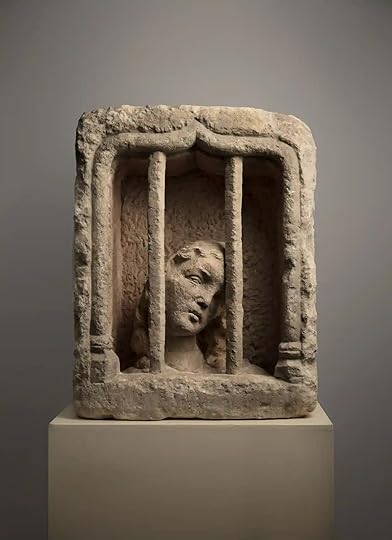 SAINT AVIA (THE JAILED WOMAN)c. 1500 France[1400]
SAINT AVIA (THE JAILED WOMAN)c. 1500 France[1400]ΣÎÎÎÎΩΣÎÎΣ[10]. https://www.facebook.com/TheMythologi.... MiloÅ¡eviÄ 2021.[1000]. Pierguidi 2002.[1100]. Heckscherthe 1956.[1200]. https://www.facebook.com/permalink.ph.... https://www.samfogg.com/exhibitions/2...
ÎÎÎÎÎÎÎΡÎΦÎÎ
https://www.researchgate.net/publicat..., P. 2021. "The Byzantine Renaissance as the predominant source and impetus for the Italian Renaissance - Theodore Gaza in Mantua, Ferrara, Rome and Naples and Nicolaos Leonicos Tomeos in Venice, Florence and Padua," in Conference: The Byzantine Renaissance as the predominant source and impetus for the Italian Renaissance - Theodore Gaza in Mantua, Ferrara, Rome and Naples and Nicolaos Leonicos Tomeos in Venice, Florence and Padua -At: Laboratório de Estudos Medievais (LEME/UNIFESP) and by the Laboratório de Estudos Mediterrânicos e Bizantinos (LÃMEB), based at the Federal University of São Paulo (UNIFESP), Brazil.
https://ia801200.us.archive.org/1/ite... J. H. Jenkins. 1963. "The Hellenistic Origins of Byzantine Literature," Dumbarton Oaks Papers 17, pp. 37+39-52.
https://www.jstor.org/stable/23206766
Pierguidi, S. 2002. "Botticelli and Protogenes: An anecdote from Pliny's Naturalis Historia," Notes in the History of Art 21 (3), pp. 15-18.
https://www.jstor.org/stable/43872969..., W. S. 1956. "'Anadyomene' in the medieval tradition: (Pelagia - Cleopatra - Aphrodite). A prelude to Botticelli's 'Birth of Venus'," Nederlands Kunsthistorisch Jaarboek (NKJ) / Netherlands Yearbook for History of Art 7, pp. 1-38.
https://www.ft.com/content/026a19fc-f..., T. 2022. "Why âwoman in the windowâ is such an enduring theme in art," FT Magazine - Visual Arts, <https://www.ft.com/content/026a19fc-f... (14 August 2022).
ÎονιδάÏÎ·Ï Î. 2022. "WOMAN AT THE WINDOW. ÎÎ¥ÎÎÎÎÎ ÎÎΤÎΠΤÎÎ¥ÎΥΣΠÎΠΠΤΠÎÎΩΡÎÎÎ (καÏαÏκοÏία - ÏαÏακÏÏÏÎ¿Ï Ïα)," ÎÎÎÎÎΤÎΣÎ, <https://dnkonidaris.blogspot.com/2022... (14 August 2022).
https://www.academia.edu/48069027/Bot..., A. and C. Elam, eds. 2019. Botticelli Past and Present, UCL Press.
August 8, 2022
BACCHAE - EURIPIDES
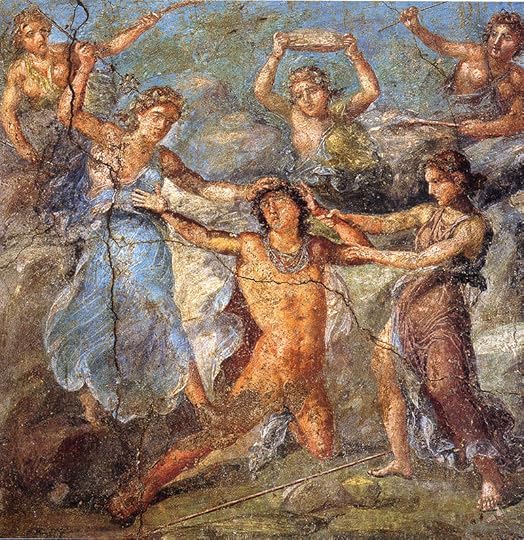 Roman fresco from Pompeii depicting Pentheus being torn by maenads
Roman fresco from Pompeii depicting Pentheus being torn by maenads
ÎÎΣ ÎÎÎÎΥΣÎΣ: THE TRAGIC PARADOX OF THE BACCHAE
INTRODUCTION [1][HEIS DIONYSOS 96]
Dionysos est double: terrible a !'extreme, infiniment doux. J.-P. Vernant
Î ÎιÏνÏ
ÏÎ¿Ï ÎµÎ¯Î½Î±Î¹ διÏÏÏÏ: ακÏαία ÏÏομεÏÏÏ, αÏείÏÏÏ Î®ÏÎ¹Î¿Ï (J.-P. Vernant)
Circa 1850, the earliest interpretation that deserves the predicate 'scholarly' pictured the Bacchae as Euripides' palinodia, a confession of his 'deathbed conversion', which made the grey poet return from the false track of sophistic agnosticism to the re-acceptance of pious religiosity and the service of the gods[2]. In the next generation it was argued that the Euripides of the Bacchae was not essentially different from the author of the
[HEIS DIONYSOS 97]
earlier work: if, indeed, the tragedy displays sentiments of authentic piety, this was not novel at all, and it went hand in hand with the criticism of myth so typical of Euripides' later plays[3]. Next appears a romantic Euripides, deeply influenced by the new ambience of primitive and ecstatic Macedonia, which led him to the discovery of the demonic and mystic aspects of religion[4]. This Euripides was in turn succeeded by the rationalist, who unremittingly denounced the excesses, delusions and cruelty of religion: tanta religio potuit .... [5]. In more recent times, we have become acquainted with Euripides as a (Freudian) psychologist, the discoverer of the tension between two contradictory aspects of a single religious phenomenon-blessed ecstasy side by side with bestial cruelty in Dionysiac religiosity - or in a single person-Pentheus' 'schizophrenia' apparent in the conflict between his stubborn defence of law and order and the 'repressed libido' manifest, for instance, in his voyeurism[6]. Though the latter approach still carries much weight in the discussion, in recent interpretations, following modish literary theories, the author more and more abandons the field to the work of art: recent structuralist and semiotic approaches offer a wealth of subtle analyses of contrast and unity in especially Dionysiac religion with its paradoxical coexistence of the codified standards of civic/cultural life and the chaotic/'natural' licence of maenadic ecstasy[7]. But it seems that structure has ousted both the author and his historical settings.A different Bacchae not only yields a different author, but also different protagonists. "Pentheus .... is left harsh and unpleasant, and very close
[HEIS DIONYSOS 99]
"Did Euripides approve or disapprove of Dionysos? The question is silly" said the sensible Kitto[13], and the nearer we approach contemporary research the more he seems to be put in the right. For even for one who is not prepared to follow frenis remissis the protagonists of structural or semiotic theory, it will be difficult to deny that such recent interpretations as those by Vernant, Detienne and Segal have opened new perspectives on the essentially tragic nature of this tragedy[14]. More cogently than Dodds' psychological intuitions, the best products of recent research have at least taught us to appreciate the intrinsic ambiguities of Dionysiac religion as the potentially explosive incentives to a tragic paradox. When the firstâsubstantially differentâversion of the present chapter appeared as an article in the Dutch journal Lampas in 1976, none of these structuralist interpretations had seen the light. Now that I have read (and benefitted from) them, I find that I have two reasons for satisfaction. The first is the remarkable correspondence between my own ideas and some of the major themes of these subsequent publications, especially the common emphasis on the intrinsic ambiguity of Dionysiac religion. The second is the equally remarkable difference in approach. Though I unconditionally adhere to the idea that the contradictions within Dionysiac ideology by their very nature may give rise to tragic clashes, my own point is an essentially different one.
I shall argue that Euripides was fully alive to the timeless ambiguity of Dionysiac religion, but that he exploited it for his own specific purpose, which aimed at converting the eternal Dionysiac ambiguity into a conflict manifest in the actual reality of his own time. In other words, I shall try to fill the gap which the structuralists have left by remaining too much "al di qua della âstoriaââ[15]. I shall argue that the poet deliberately presented Dionysiac religion as one of the new 'sects' that invaded Greece and especially Athens in his time. His chief purpose was not to evoke the innate paradoxes of Dionysiac religion, though they surely served him as a handle, but rather to question the nature of religious convictions in general, both the established and novel ones, by sowing doubt about their status and mutual relationship. For this reason he manipulated the para-
[HEIS DIONYSOS 100]
doxical aspects of Dionysiac religion by applying a stark historical distortion and cunningly mixing up the mythic past and tile historical present. Contemporary authorities, backed by popular opinion, condemned thy new zealots. In doing so they had the law on their side and so, from this angle, had Pentheus. However, the public knew that Dionysos was not a new god, but an ancient, accepted, civic deity. Seen in this light Pentheus was not right. I hope to show that the Bacchae is the tragedy of two conflicting positions which, though both right in principle, make theimselves both guilty of asebeia. And this is a truly tragic paradox. Furthermore, I shall argue that in the context of this tragic objective, Euripides was the first Greek author to recognize and design the image of a revolutionary new type of god and the concomitant religious mentality, an image which, though no doubt tolerated by the unique nature of classical Dionysos, must have been particularly fostered by the presumptions of the new 'sects'. Deities of this nature only came to prosper in the Hellenistic and Roman period, where they became âroutinizedâ just as Dionysos had been long before.
In developing my ideas I start from the following assumptions, which it will for reasons of space be impossible to argue in any detail here:
1) A new interpretation of the Bacchae can do without a detailed survey of the literary history of the play. No new theory, however, can boast independence from previous research. The reader will soon discover my indebtedness to, for instance, Winnington-Ingram and especially Dodds, not to mention more recent authors. He will also find that my interpretation, though excluding some, certainly does not dismiss all previous views of the tragic clash between god and king.
2) As I said in the introduction to this book, there is in my view one indisputable precondition to embarking on an (historical) interpretation of a work of art: the conviction that the ancient audience and the modern reader share the basic human qualities necessary to provide an at least provisional platform for understanding the meaning of the work, as it was intended by the author (which does not exclude the existence of other meanings). After characterizing Euripides as "the man of hard analytic vision who sees the here and now truly and exactly for what it is, B. Knox 16 continues: "he must have intended (my italics H.S.V.) to produce this unsettling effect, which disturbed his contemporaries as it disturbs us: to leave us with a sense of uncertaintyâ. Though fully aware of its blasphemous infringement upon structuralist,
[HEIS DIONYSOS 101]
post-modernist or post-post-modernist confessions I endorse this point of view. No literary theory will ever be able to discard the significance of the public's reactions to especially Euripidean drama. When in Aristoph. Thesmoph. 450-1, a seller of wreaths for statues of the gods claims that Euripides has spoiled her livelyhood because "by working in tragedies he has persuaded men that gods do not exist", this speaks volumes on the immediacy of the audience's involvement. And this leads us to my third point. 3) The quest for the meaning of a text is hopeless without a certain knowledge of the expectations one may presuppose in the audience. This involves the task of investigating as far as possible the social and mental experience of the Athenians of the late fifth century. For my subject this will require, first, an analysis of the new cults and the reactions they provoked in Athens, and, second, an assessment of the position of the orgiastic and maenadic aspects of Dionysiac religion in Greece. In confessing my belief in a historical approach to the work of art, I feel buttressed by the remarkable recent reappraisal of the historical Sitz im Leben for the understanding of Greek tragedy[17], which had somewhat faded into the background, no doubt under the influence of the combined forces of psychological and structuralist approaches. However, not a little alarmed by such over-enthusiastic historicists who, for instance, manage to stage Dionysos as the mythical double of Alcibiades[18], I wish to concentrate on general tendencies as traits d'union between the fiction of tragedy and the historical reality of its social setting. Whenever I do believe that close reflections of specific details can be detected, I hope they are more convincing than the identification just mentioned. Thus I hope implicitly to demonstrate the truth in the words of a great philologist: âthe works we have got: Euripidesâthat is: these eighteen plays. In them indeed is all the history of his time; but not in the form of a running commentary on[HEIS DIONYSOS 102]
the issues of the day. Every experience and every idea that stirred his age, every hope that winged, every despair that bent it: they have all been absorbed, by a genius of unlimited perception and penetration, into objective world of art"[19].
1. HAILING NEW GODS IN ATHENS
1. New gods and their reception
The Olympian family of the archaic and early classical period strikes us as an established and fairly static society. Foreign gods could be admitted, it is true, but admission to official cult was only granted on condition that the new god submitted to the local nomoi of the polis. In view of the tolerant[21] and inclusive nature of polytheism, we should be less surprised by the fact that foreign gods did find their way into the Greek pantheon than by the fact that so few availed themselves of the opportunity. Strabo, in a famous passage (10, 3, 18), praises Athenian hospitality, including tolerance towards foreign gods: "for they welcomed so many of the foreign rites that they were ridiculed by comic writers", but he menions only the Thracian Bendideia [Îενδίδεια] and the Phrygian rites of Sabazios. Granting that there must have been more foreignersâalbeit hardly in the official circuitâthan are documented in our sources, and ignoring the ones that are of no particular interest to our purposeâsuch as Hecate, Ammon, and Greek migrants like Pan or Asclepius[22] â with half a dozen
[HEIS DIONYSOS 102]
-----------------------------------------------------------------------
ΣÎÎÎÎΩΣÎÎΣ
1 B. Knox, Word and Action. Essays on the Ancient Theater (Baltimore-London 1979) 330.
2 This interpretation has been defended by, among others, Tyrwhitt, Lobeck, K. 0. Muller, Nagelsbach, also followed by Rohde and the young Wilamowitz. The idea has not died out yet: in the introduction to his Bude edition of the Bacchae (Paris 1961) 236 f., H. Gregoire still adheres to it, and it is not completely absent from]. Roux's commen-tary either. See on the 'palinode' theory in general and the contribution by Nietzsche in particular: A. Henrichs, The Last of the Detractors: Friedrich Nietzsche's Condemnation of Euripides, GRBS 27 (1986) 369-97, esp. 391 ff. For this rapid history of Euripidean scholarship I am specially indebted to the surveys by H. Merklin, Colt und Mensch im 'Hip-polytos' und den 'Bakchen' des Euripides (Diss. Freiburg im Breisgau 1964) 30-9; J. M. Bremer, De interpretatie van Euripides' Bacchen, Lampas 9 (1976) 2-7; Oranje 1984, 7-19.
3 Thus by and large: Hartung, Tyrrell, Sandys, Kraus, Wecklein.4 Dieterich, Schmid, in a way also Wilamowitz: Traces in Roux.
5 The extremes in the notorious theories of G. Norwood, The Riddle of the Bacchae (Manchester 1908), who, however, recanted his earlier views in Essays on Euripidean Drama (London 1954) 52-73, and A. W. Verrall, The Bacchants of Euripides and Other Essays (Cam-bridge 1910) 1-163. Recently, Lefkowitz 1989, argued that, though the picture of impiety derives from Euripides' own dramas, any character in Euripides who expresses 'phi-losophical' notions about the gods does so out of desperation. Ultimately the gods will prove-not always to the character's satisfaction-that they retain their traditional power.
6 Fundamentally in Dodds 1960, already foreshadowed in his: Euripides the Irration-alist, CR 43 (1929) 97-104, and Winnington-lngram 1948. Cf. also G. M.A. Grube, Di-onysos in the Bacchae, TAPhA 66 (1935) 37-54. Apart from their contributions to our in-sight into the psychology of Pentheus, their influence has been particularly fertile in the exploration of the typically ambiguous nature of Dionysiac piety, as it is for instance ex-plored in Musurillo 1966, Cook 1971, and recent structuralist works.
7 Segal1982; 1986, with serious attention for psychoanalysis. See esp. 'Pentheus and Hippolytus on the Couch and on the Grid: Psychoanalytic and Structuralist Readings of Greek Tragedy', ibid. 268-93; Vernant 1986a and 1986b. 8 The problems connected with the pursuit of the author's intention had long been recognized: "Hinter dieser frommen, allzu fromm dramatisierten Legende ( .... ) ist der Dichter abgetreten. Man riit bis heute daran herum" (K. Reinhardt, Die Sinneskrise bei Euripides, in: E. R. Schwinge [ed.), Euripides [Darmstadt 1968] 506).
ÎÎÎÎÎÎÎΡÎΦÎÎ
https://brill.com/view/book/978900429...
Versnel, H. 1998. "ÎÎΣ ÎÎÎÎΥΣÎΣ: THE TRAGIC PARADOX OF THE BACCHAE," in Inconsistencies in Greek and Roman Religion 1: Ter Unus. Isis, Dionysos, Hermes. Three Studies in Henotheism (Series: Studies in Greek and Roman Religion, Volume: 6/1), pp. 96-205.
https://www.greek-language.gr/digital... ÎνημοÏÏνη. ΨηÏιακή Îιβλιοθήκη ÏÎ·Ï ÎÏÏÎ±Î¯Î±Ï ÎÎ»Î»Î·Î½Î¹ÎºÎ®Ï ÎÏαμμαÏείαÏ, s.v. ÎάκÏεÏ
---------------------------------------------------------------------------------------------------------------------------- https://www.academia.edu/50771831/Dio..., R. 2021. "The politics of Euripidesâ Bacchae and the preconception of irresolvable contradiction," in Dionysus and Politics. Constructing Authority in the Graeco-Roman World, ed. F. , Doroszewski and D. KarÅowicz, London / New York, pp. 18-31.
I will maintain that, contrary to a widespread view of Bacchae, (§1) Pentheus does not embody the values of the polis: quite the reverse; (§2) there is no contradiction between Dionysos and the polis: quite the reverse; (§3) there are reasons why the punishment inflicted by Dionysos would have seemed to the Athenian audience justified, especially given (§4) the very dangerous political circumstances in which the play was written, which have been ignored by its interpreters; (§5) there is no unresolved or irresolvable contradiction, whether within the Dionysiac or between the Dionysiac and Pentheus; (§6) liberating ourselves from the PIC can be advanced by understanding its historical origin. ----------------------------------------------------------------------------------------------------------------------------https://journals.calstate.edu/jet/art..., R. J. 2018. "Comparison as poetry: Reading Euripidesâ Bacchae and the Zhuangzi," Journal of East-West Thought 8 (3), pp. 31-58.CHINA ..Abstract: This essay has two major parts. First, a comparison between poetry and comparative work itself. Second, a comparison of the Zhuangzi and Euripidesâ Bacchae. Comparison is like a poem in that both are imaginative constructions that rely on the creativity of the comparatist or poet. Comparisonand poetry take features of the world and alter them in such a way as to suggest an alternative. The Zhuangzi and the Bacchae, via the theme of forgetting, do the same thingâunsettle our fixed suppositions or knowledge. The argument that a comparative work is like a poem thus relies on the comparison of Zhuangzi and Euripides as an illustration. Both the Zhuangzi and the Bacchae invite a relinquishing of fixed knowledge, and depict a human nature that is tenuous and given to change. This article suggests that a similar experience characterizes the practice of comparison, and that such an experience is something we often see in poetry.
ΣÎÎÎÎΩΣÎÎΣ
[1]. Versnel 1998, p. 96 fe.
August 5, 2022
ANDRIAN VILLA
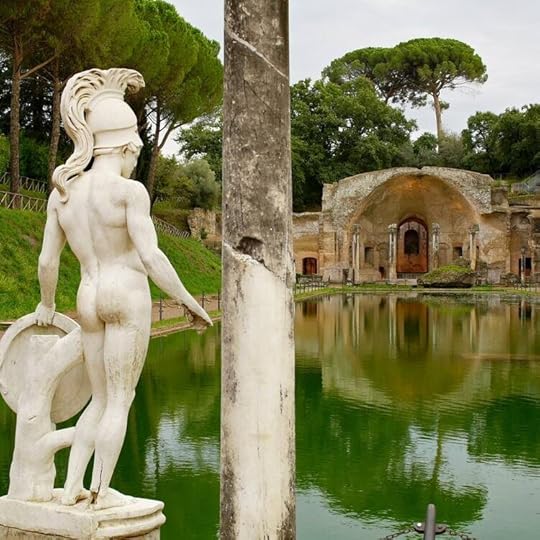 ÎÏοÏη ÏÎ·Ï ÎÏαÏλεÏÏ
ÎÏοÏη ÏÎ·Ï ÎÏαÏλεÏÏÎ ÎδÏιανÏÏ Ï ÏήÏξε ÎνθεÏÎ¼Î¿Ï Î¸Î±Ï Î¼Î±ÏÏÎ®Ï ÏÎ·Ï ÎÎ»Î»Î¬Î´Î±Ï ÎºÎ±Î¹ ÏÏοÏÏάθηÏε να κάνει Ïην Îθήνα ÏολιÏιÏÏική ÏÏÏÏεÏÎ¿Ï Ïα ÏÎ·Ï ÎÏ ÏοκÏαÏοÏίαÏ, γι' Î±Ï ÏÏ Î´Î¹ÎÏαξε Ïην ανÎγεÏÏη ÏολλÏν ÏÎ¿Î»Ï ÏελÏν ναÏν εκεί. Î ÎνÏονη ÏÏÎÏη ÏÎ¿Ï Î¼Îµ Ïον Îλληνα νεαÏÏ ÎνÏίνοο και ο ÏÏÏÏÏÎ¿Ï Î¸Î¬Î½Î±ÏÎ¿Ï ÏÎ¿Ï ÏÎµÎ»ÎµÏ ÏÎ±Î¯Î¿Ï Î¿Î´Î®Î³Î·Ïαν Ïον ÎδÏÎ¹Î±Î½Ï Î½Î± ιδÏÏÏει μια ÎµÏ ÏÎÏÏ Î´Î¹Î±Î´ÎµÎ´Î¿Î¼Îνη λαÏÏεία ÏÏα ÏÎλη ÏÎ·Ï Î²Î±ÏÎ¹Î»ÎµÎ¯Î±Ï ÏÎ¿Ï . Î ÎµÎ½Î¸Î¿Ï ÏιαÏμÏÏ ÏÎ¿Ï ÎδÏÎ¹Î±Î½Î¿Ï Î³Î¹Î± Ïην ελληνική λογοÏεÏνία και Ïον ÏολιÏιÏÎ¼Ï ÏÎ¿Ï ÏάÏιÏε Ïο ÏαÏαÏÏοÏκλι Graeculus ("μικÏÏÏ ÎÎ»Î»Î·Î½Î±Ï - ÎÏαικÏλοÏ"), ÏÎ¿Ï ÏÏοοÏιζÏÏαν ÏÏ Î¼Î¹Î± μοÏÏή "ήÏÎ¹Î¿Ï Î±ÏÏεÏÏμοÏ". ..... ΣÏήν ÎÏÎ±Ï Î»Î¹Î½ αναÏαÏήÏθηÏαν εικÏÎ½ÎµÏ Î±ÏÏ Ïο ÎÏκειον, Î ÏÏ Ïανείον, Ποικίλη ΣÏοά, Îκαδημία (ή μικÏÏ Î±Î½Î¬ÎºÏοÏο) κ.ά. ÏÏν αÏÏαίÏν ÎθηνÏν, ο Î´Î¯Î±Ï Î»Î¿Ï ÎάνÏÏοÏ, αÏÏÎ±Î¯Î¿Ï Î»Î¹Î¼Î®Î½ ÏÎ¿Ï ÎÎλÏα ÏÎ¿Ï ÎÎµÎ¯Î»Î¿Ï , η κοιλάδα ÏÏν ΤεμÏÏν ÏÏην ÎεÏÏαλία κ.ά.[0]ΣÏμÏÏνα με Ïην ÎÏ Î³Î¿Ï ÏÏιανή ÎÏÏοÏία, SHA Hadr. 26.5, Ïα ονÏμαÏα διάÏοÏÏν ÏεÏίÏημÏν οικοδομημάÏÏν εÏαÏάÏθηκαν ÏÏην ÎÏÎ±Ï Î»Î¹Î½, ÏαÏαÏÎμÏονÏÎ±Ï Ïε ανάλογη ÎλληνιÏÏική ÏÏ Î½Î®Î¸ÎµÎ¹Î±![0a]
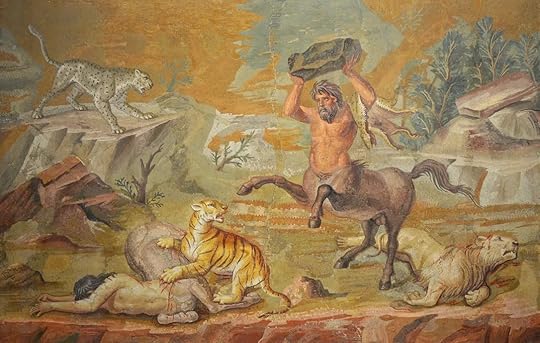 ÎεÏÎ³Î¿Ï ÎºÎµÎ½ÏαÏÏÏν ανÏιÏαλεÏοÏ
ν άγÏια θηλαÏÏικά[0aa]
ÎεÏÎ³Î¿Ï ÎºÎµÎ½ÏαÏÏÏν ανÏιÏαλεÏοÏ
ν άγÏια θηλαÏÏικά[0aa]ÎÎ½Ï Î¿Î¹ αÏεικονίÏÎµÎ¹Ï ÏÏην ÏαλαιÏÏεÏη ελληνική ÏÎÏνη ÎÏειναν να ÏÎ¿Î½Î¯Î¶Î¿Ï Î½ Ïην κÏηνÏδη ÏÎ»ÎµÏ Ïά ÏÏν κενÏαÏÏÏν, οι μεÏαγενÎÏÏεÏÎµÏ ÎµÏικενÏÏÏνονÏαν Ïλο και ÏεÏιÏÏÏÏεÏο ÏÏÎ¹Ï Î±Î½Î¸ÏÏÏÎ¹Î½ÎµÏ Î¹Î´Î¹ÏÏηÏÎÏ ÏÎ¿Ï Ï. Î ÎÎ¿Ï ÎºÎ¹Î±Î½ÏÏ, ÏÏ Î³Î³ÏαÏÎÎ±Ï ÏÎ¿Ï 2Î¿Ï Î±Î¹., καÏαγÏάÏει ÏÏι ο Îλλην ζÏγÏάÏÎ¿Ï ÎεÏÎ¾Î¹Ï (ενεÏγÏÏ Î³ÏÏÏ ÏÏο 400 Ï.Χ.) Îγινε διάÏÎ·Î¼Î¿Ï Î³Î¹Î± Ïη ζÏγÏαÏική ÏÎ¿Ï Î¼Î¹Î±Ï Î¿Î¹ÎºÎ¿Î³ÎÎ½ÎµÎ¹Î±Ï ÎºÎµÎ½ÏαÏÏÏν, ÏÏ Î¼ÏεÏιλαμβανομÎÎ½Î¿Ï ÏÎ¿Ï Î½ÎµÎ±ÏοÏ, ÏÎ¿Ï Î´Î¹Î±Î´ÏαμαÏίζεÏαι Ïε Îνα αγÏοÏÎ¹ÎºÏ ÎµÎ¯Î´Ïλλιο. ÎμοίÏÏ, ο ÎβίδιοÏ, ÏÎ¿Ï ÎζηÏε ÏεÏί Ïην αλλαγή ÏÎ·Ï ÏιλιεÏίαÏ, ÎγÏαÏε Ïε ÏÏ Î³ÎºÎ¹Î½Î·ÏÎ¹ÎºÏ ÏÏίÏο για Ïον θάναÏο ενÏÏ Î¶ÎµÏ Î³Î±ÏÎ¹Î¿Ï ÎºÎµÎ½ÏαÏÏÏν. Îι εκÏεÏαμÎÎ½ÎµÏ ÎµÏγαÏÎ¯ÎµÏ Î±ÏοκαÏαÏÏάÏεÏÏ ÏÎ¿Ï ÏÏαγμαÏοÏοιήθηκαν Ïον 18ο και 19ο αι. καθιÏÏοÏν δÏÏκολη Ïη ÏÏονολÏγηÏη ÏÎ¿Ï ÏηÏιδÏÏÎ¿Ï Î¼Îµ βεβαιÏÏηÏα. Î©Ï Î±ÏοÏÎλεÏμα, η ÏÏονολÏγηÏή ÏÎ¿Ï ÎºÏ Î¼Î±Î¯Î½ÎµÏαι αÏÏ Ïην ÎÎÎÎÎÎΣΤÎÎÎ ÎÏÏ Ïην ÎδÏιανεια ÏεÏίοδο. Î¥ÏάÏÏει ÎµÏ Ïεία ÏÏ Î¼ÏÏνία μεÏÎ±Î¾Ï ÏÏν μελεÏηÏÏν ÏÏι Ïο ÏηÏιδÏÏÏ Î±Î½ÏιÏÏοιÏεί Ïε Îνα αÏÏ Ïα Ïιο βιÏÏÎ¿Ï Ïζα ÎÏγα ÏÎ·Ï ÏÏμαÏÎºÎ®Ï ÏηÏιδÏÏÎ®Ï ÏÎÏνηÏ, Ïο οÏοίο Î±Ï Ïή ενεÏνεÏÏθη αÏÏ Îνα ÎµÎ»Î»Î·Î½Î¹ÎºÏ ÎÏγο ÏÎÏÎ½Î·Ï (Ïίνακα ή ÏηÏιδÏÏÏ) αÏÏ Ïην ελληνιÏÏική ÏεÏίοδο..[0aaa]
ÎÏÏαÏκά ÏÏηÏιμοÏοιήθηκαν Ïε Ïλο Ïο ÏÏ Î³ÎºÏÏÏημα, ÎºÏ ÏίÏÏ Ïε λιγÏÏεÏο αÏιÏÏοκÏαÏικοÏÏ ÏÏÏÎ¿Ï Ï, ÏÏÏÏ Î¿Î¹ κοιÏÏÎ½ÎµÏ Î³Î¹Î± ÏÎ¿Ï Ï ÎºÎ±ÏÏÏεÏÎ¿Ï Ï ÎµÏιÏκÎÏÏÎµÏ ÏÎ·Ï Î²Î¯Î»Î±Ï, αλλά οÏιÏμÎνα ÏημανÏικά δÏμάÏια ήÏαν εÏίÏÎ·Ï Î´Î¹Î±ÎºÎ¿ÏμημÎνα με ειδικά ÏηÏιδÏÏά. Τα Ïιο διάÏημα ÏηÏιδÏÏά αÏÏ Ïη ÎÏÎ±Ï Î»Î¹Î½ ÏÎ¿Ï ÎδÏÎ¹Î±Î½Î¿Ï ÎµÎ¯Î½Î±Î¹ δÏο εμβλήμαÏα ελληνιÏÏÎ¹ÎºÎ¿Ï ÏÏÎ¿Ï Ï, Ïο «ÎÏÏαÏÎºÏ Î¼Îµ Ïα ÏεÏιÏÏÎÏια ÏÎ¿Ï ÏÎ¯Î½Î¿Ï Î½Â» και Ïο «ΨηÏιδÏÏÏ Î¼Îµ ÏÎ¹Ï Î¸ÎµÎ±ÏÏικÎÏ Î¼Î¬ÏκεÏ», και Ïα δÏο ÏÏÏα ÏÏα ÎÎ¿Ï Ïεία ÎαÏιÏÏÎ»Î¯Î¿Ï . Îαι Ïα δÏο εμβλήμαÏα καÏαÏÎºÎµÏ Î¬Î¶Î¿Î½Ïαι με μια ÏεÏνική γνÏÏÏή ÏÏ opus vermiculatum, με Ïην ÏÏήÏη λεÏÏÏν ÏηÏίδÏν. Î Î Î»Î¯Î½Î¹Î¿Ï Î¿ ÎεÏÏεÏÎ¿Ï ÎγÏαÏε για Îνα διάÏημο ÎµÎ»Î»Î·Î½Î¹ÎºÏ Î¼ÏÏαÏÎºÏ Î´Î±ÏÎÎ´Î¿Ï Î¼Îµ Îμβλημα με ÏεÏιÏÏÎÏια ÏÎ¿Ï ÏÎ¯Î½Î¿Ï Î½ ÏÏη μÎÏη ενÏÏ Î»ÎµÎ³ÏÎ¼ÎµÎ½Î¿Ï Â«Î¬ÏάÏÏÏÎ¿Ï Î´Î±ÏÎÎ´Î¿Ï Â». Το μÏÏαÏÎºÏ Î±ÏÏ Ïη ÎÏÎ±Ï Î»Î¹Î½ ÏÎ¿Ï ÎδÏÎ¹Î±Î½Î¿Ï Î¸Î± μÏοÏοÏÏε να είναι Ïο ÏÏÏÏÏÏÏ Ïο ÎµÎ»Î»Î·Î½Î¹ÎºÏ ÎÏγο ή θα μÏοÏοÏÏε να είναι ανÏίγÏαÏο. Τα εμβλήμαÏα αÏαιÏοÏνÏαι εÏκολα λÏÎ³Ï ÏÎ¿Ï Î¼ÎµÎ³ÎÎ¸Î¿Ï Ï ÏÎ¿Ï Ï.[0aaaa]
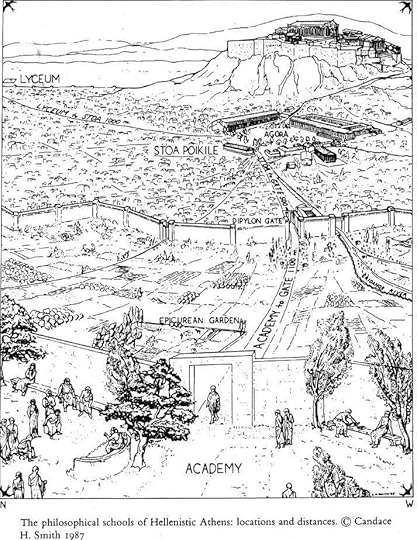 Îι ÏιλοÏοÏικÎÏ ÏÏολÎÏ ÏÏν ÎθηνÏν
Îι ÏιλοÏοÏικÎÏ ÏÏολÎÏ ÏÏν ÎθηνÏνVilla Adriana (Tivoli), UNESCO[1]Î ÎÏÎ±Ï Î»Î¹Ï ÎµÎ¯Î½Î±Î¹ μια εξαιÏεÏική αÏÏιÏεκÏονική κληÏονομιά ÏÎ¿Ï Î¼ÎµÎ³Î¬Î»Î¿Ï Î¡ÏÎ¼Î±Î¯Î¿Ï Î±Ï ÏοκÏάÏοÏα ÎδÏιανοÏ. ΧÏιÏμÎνη ÏÏ ÎºÎ±ÏαÏÏγιο αÏÏ Ïη ΡÏμη μεÏÎ±Î¾Ï 117 και 138 μ.Χ., η ÎÏÎ±Ï Î»Î¹Ï ÏÏεδιάÏÏηκε ÏÏ Î¹Î´Î±Î½Î¹ÎºÎ® ÏÏλη και ενÏÏμαÏÏνει ÏÎ¹Ï Î±ÏÏιÏεκÏονικÎÏ ÏαÏαδÏÏÎµÎ¹Ï ÏÎ·Ï ÎÏÏÎ±Î¯Î±Ï ÎλλάδαÏ, ÏÎ·Ï Î¡ÏÎ¼Î·Ï ÎºÎ±Î¹ ÏÎ·Ï ÎιγÏÏÏÎ¿Ï . Τα εÏείÏια ÏεÏίÏÎ¿Ï 30 κÏιÏίÏν εκÏείνονÏαι Ïε 120 εκÏάÏια ÏÏν λÏÏÏν Tiburtine (Tivoli, Lazio).ÎÎ½Ï Î¿Î¹ καÏαÏÎºÎµÏ ÎÏ ÏαίνεÏαι να είναι διαÏεÏαγμÎÎ½ÎµÏ ÏÏÏÎ¯Ï Î¹Î´Î¹Î±Î¯ÏεÏο ÏÏÎδιο, η ÏοÏοθεÏία ÏεÏιλαμβάνει μια ÏÏνθεÏη και καλά ÏÏεδιαÏμÎνη διάÏαξη μαζί με μεγάλο αÏÎ¹Î¸Î¼Ï ÎºÏιÏίÏν καÏοικιÏν και αναÏÏ ÏήÏ, εκÏεÏαμÎÎ½Î¿Ï Ï ÎºÎ®ÏÎ¿Ï Ï ÎºÎ±Î¹ ανÏανακλαÏÏικÎÏ Ï Î´Î¬ÏÎ¹Î½ÎµÏ ÎµÏιÏÎ¬Î½ÎµÎ¹ÎµÏ Î±Î½Î¿Î¹ÎºÏÏν Ï Î´Î±ÏοδεξαμενÏν, η ÏοÏοθεÏία Î´Î·Î¼Î¹Î¿Ï Ïγεί μια γαλήνια και ÏÏοÏαÏÏική ÏαÏη.Î¥ÏάÏÏÎ¿Ï Î½ ÏεÏίÏÎ¿Ï ÏÏιάνÏα ÏÏζÏμενα κÏίÏια ενÏÏÏ ÏÎ·Ï ÏοÏοθεÏÎ¯Î±Ï ÏÎ¿Ï Î¼ÏοÏοÏν να ÏÏÏιÏÏοÏν γενικά Ïε ÏÎÏÏεÏÎ¹Ï Î¿Î¼Î¬Î´ÎµÏ.Îια ÏÏÏÏη ομάδα κÏιÏίÏν ÏÏην ÏοÏοθεÏία ÏεÏιλαμβάνει Ïο λεγÏμενο «ÎÎ»Î»Î·Î½Î¹ÎºÏ ÎÎαÏÏο» και Ïον «ÎÎ±Ï ÏÎ·Ï ÎÎ½Î¹Î´Î¯Î±Ï ÎÏÏοδίÏηÏ».ΣÏον ÏÏ Ïήνα ÏÎ·Ï ÎµÏαÏλεÏÏ, ÎµÏ ÏίÏκεÏαι μια δεÏÏεÏη ομάδα καÏαÏÎºÎµÏ Ïν ÏÎ¿Ï ÏεÏιλαμβάνει κÏίÏια ειδικά για Ïον Î±Ï ÏοκÏάÏοÏα και Ïην Î±Ï Î»Î® ÏÎ¿Ï ÎºÎ±Î¹ ÏεÏιλαμβάνει Ïο λεγÏμενο «ÎÎ±Ï ÏÎ¹ÎºÏ ÎÎαÏÏο», Ïο «ÎÏ ÏοκÏαÏοÏÎ¹ÎºÏ ÎνάκÏοÏο», «ΧειμεÏÎ¹Î½Ï ÎνάκÏοÏο», ÎαÏινικÎÏ ÎºÎ±Î¹ ÎλληνικÎÏ Â«ÎιβλιοθήκεÏ». και Ïην «ΧÏÏ Ïή ΠλαÏεία». ÎÏ Ïή η ομάδα καÏαÏÎºÎµÏ Ïν οÏγανÏνεÏαι γÏÏÏ Î±ÏÏ ÏÎÏÏεÏα ξεÏÏÏιÏÏά ÏεÏιÏÏÏλια. Π«ΧÏÏ Ïή ΠλαÏεία» είναι Îνα αÏÏ Ïα Ïιο ενÏÏ ÏÏÏιακά κÏίÏια ÏÎ¿Ï ÏÏ Î³ÎºÏοÏήμαÏοÏ, ÏÎ¿Ï Î±ÏοÏελείÏαι αÏÏ Îνα ÏεÏάÏÏιο ÏεÏίÏÏÏ Î»Î¿ ÏÎ¿Ï ÏεÏιβάλλεÏαι αÏÏ Î¼Î¹Î± δίκλιÏη ÏÏοά με εναλλαÏÏÏÎ¼ÎµÎ½ÎµÏ ÎºÎ¿Î»ÏÎ½ÎµÏ Î±ÏÏ Î¼Î¬ÏμαÏο cipollino και Î±Î¹Î³Ï ÏÏÎ¹Î±ÎºÏ Î³ÏανίÏη. Το «ανάκÏοÏο» αÏοÏελείÏαι αÏÏ Îνα ÏÏ Î³ÎºÏÏÏημα δÏμαÏίÏν γÏÏÏ Î±ÏÏ Î¼Î¹Î± Î±Ï Î»Î®. Î ÎºÏ ÎºÎ»Î¹ÎºÎ® δομή ÏÎ¿Ï Â«ÎÎ±Ï ÏÎ¹ÎºÎ¿Ï ÎεάÏÏÎ¿Ï Â» αÏοÏελείÏαι αÏÏ Îνα ÎÏÎ½Î¹ÎºÏ Î¼Î±ÏμάÏινο ÏεÏιÏÏÏλιο ÏÎ¿Ï ÏεÏιβάλλει Îνα ÏεÏνηÏÏ ÎºÏ ÎºÎ»Î¹ÎºÏ Î½Î·Ïί με μια μικÏοÏκοÏική ÎÏÎ±Ï Î»Î¹Î½. Îι «ÎιβλιοθήκεÏ» ÏÏÎ¬Î½Î¿Ï Î½ αÏÏ ÎµÎºÎµÎ¯ με δÏο ÏεÏάÏμαÏα, και Îνα Î½Ï Î¼Ïαίο βÏίÏκεÏαι ÏÏην βÏÏεια ÏÎ»ÎµÏ Ïά.Îια ÏÏίÏη ομάδα κÏιÏίÏν ÏεÏιλαμβάνει Ïα Î»Î¿Ï ÏÏά, ÏÏ Î¼ÏεÏιλαμβανομÎνÏν ÏÏν ÎικÏÏν ÎεÏμÏν, ÏÏν ÎεγάλÏν ÎεÏμÏν και ÏÏν ÎεÏμÏν με Îλιοκάμινο.Î ÏÎµÎ»ÎµÏ Ïαία ομάδα καÏαÏÎºÎµÏ Ïν ÏεÏιλαμβάνει Ïη «Îίμνη ÏÎ¿Ï ÎºÏÎ¯Î½Î¿Ï Â», Ïον «ΠÏÏγο ΡοκαμÏÏοÏνα» και Ïην «Îκαδημία». ÎκÏÏÏ Î±ÏÏ Î±Ï ÏÎÏ ÏÎ¹Ï Î´Î¿Î¼ÎÏ, Ï ÏάÏÏει Îνα ÏÏμÏλεγμα Ï ÏÏγειÏν ÏÏοιÏείÏν, ÏÏ Î¼ÏεÏιλαμβανομÎ-νÏν κÏÏ ÏÏÎ¿Î¸Ï ÏÏν και Ï ÏÏγειÏν ÏÏοÏν, ÏÎ¿Ï ÏÏηÏιμοÏοιοÏνÏαι για εÏÏÏεÏικÎÏ ÎµÏικοινÏÎ½Î¯ÎµÏ ÎºÎ±Î¹ αÏÎ¿Î¸Î®ÎºÎµÏ Ïη. Î¥ÏάÏÏÎ¿Ï Î½ εÏίÏÎ·Ï Î±ÏκεÏοί μεγάλοι κήÏοι, ÏÏ Î¼ÏεÏιλαμβανομÎÎ½Î¿Ï ÏÎ¿Ï Â«Î Î¿Î¹ÎºÎ¯Î»Î·Ï Î£ÏοάÏ», και μνημειÏÎ´Î¿Ï Ï Î½Ï Î¼ÏÎ±Î¯Î¿Ï , ÏÏÏÏ Î±Ï ÏÎ¿Ï Î¼Îµ Ïον «ÎÎ±Ï ÏÎ·Ï ÎÎ½Î¹Î´Î¯Î±Ï ÎÏÏοδίÏηÏ» ή Î±Ï ÏÏÏ ÏÏην «ÎÏ Î»Î® ÏÏν ÎιβλιοθηκÏν» και, ÏÏ Ïικά, καÏÎ¿Î¹ÎºÎ¯ÎµÏ Î³Î¹Î± Ï ÏηÏÎÏεÏ.ÎÏ ÏÏ Ïο εξαιÏεÏÎ¹ÎºÏ ÏÏ Î³ÎºÏÏÏημα κÏιÏίÏν και καÏαÏÎºÎµÏ Ïν ÏÏ Î¼Î²Î¿Î»Î¯Î¶ÎµÎ¹ μια δÏναμη ÏÎ¿Ï ÏÏαδιακά γινÏÏαν αÏÏÎ»Ï Ïη. Î ÎÏÎ±Ï Î»Î¹Ï ÎδÏÎ¹Î±Î½Î¿Ï - Villa Adriana, ÏÎ¿Ï Î¸Ï Î¼Î¯Î¶ÎµÎ¹ διάÏημα μÎÏη και κÏίÏια Ïε Ïλη Ïην Î±Ï ÏοκÏαÏοÏία, αναÏαÏήγαγε ÏÏοιÏεία ÏÏν Ï Î»Î¹ÎºÏν ÏολιÏιÏμÏν ÏÎ·Ï ÎιγÏÏÏÎ¿Ï , ÏÎ·Ï ÎÎ»Î»Î¬Î´Î±Ï ÎºÎ±Î¹ ÏÎ·Ï Î¡ÏÎ¼Î·Ï Î¼Îµ Ïη μοÏÏή Î¼Î¹Î±Ï Â«Î¹Î´Î±Î½Î¹ÎºÎ®Ï ÏÏλεÏÏ».ÎÏÎ¿Ï Ï ÏÎÏÏη ζημιά και ÏαÏαμÎληÏη για ÏολλοÏÏ Î±Î¹ÏÎ½ÎµÏ Î¼ÎµÏά Ïο θάναÏο ÏÎ¿Ï ÎδÏÎ¹Î±Î½Î¿Ï Ïο 138 μ.Χ., η θÎÏη ανακαλÏÏθηκε Ïελικά ξανά Ïο 1461. Πγαλήνη ÏÎ·Ï ÏοÏοθεÏÎ¯Î±Ï ÎµÎ½ÎÏÎ½ÎµÏ Ïε Îνα ανανεÏμÎνο ενδιαÏÎÏον για Ïην κλαÏική αÏÏιÏεκÏονική. Îι μελÎÏÎµÏ Î³Î¹Î± Ïην Villa Adriana εÏηÏÎαÏαν αÏÏιÏÎκÏÎ¿Î½ÎµÏ ÏÏν μεÏαγενÎÏÏεÏÏν αιÏνÏν, ÎºÏ ÏίÏÏ ÏÎ·Ï Î±Î½Î±Î³ÎµÎ½Î½Î·ÏÎ¹Î±ÎºÎ®Ï Î±Î»Î»Î¬ ιδιαίÏεÏα ÏÎ·Ï Î¼ÏαÏÏκ αÏÏιÏεκÏονικήÏ. Το αξιοÏημείÏÏο εÏίÏÎµÏ Î³Î¼Î¬ ÏÎ·Ï ÏÏον ÏÏεδιαÏÎ¼Ï ÏÏ Î½ÎÏιÏε να αÏκεί ÏημανÏική εÏιÏÏοή Ïε αξιÏÎ»Î¿Î³Î¿Ï Ï Î±ÏÏιÏÎκÏÎ¿Î½ÎµÏ ÎºÎ±Î¹ ÏÏεδιαÏÏÎÏ ÏÎ·Ï ÏÏγÏÏÎ¿Î½Î·Ï ÎµÏοÏήÏ.κÏιÏήÏιο (i): Î ÎÏÎ±Ï Î»Î¹Ï ÎµÎ¯Î½Î±Î¹ Îνα αÏιÏÏοÏÏγημα ÏÎ¿Ï ÏÏ Î³ÎºÎµÎ½ÏÏÏνει μοναδικά ÏÎ¹Ï Ï ÏηλÏÏεÏÎµÏ ÎµÎºÏÏάÏÎµÎ¹Ï ÏÏν Ï Î»Î¹ÎºÏν ÏολιÏιÏμÏν ÏÎ¿Ï Î±ÏÏÎ±Î¯Î¿Ï Î¼ÎµÏÎ¿Î³ÎµÎ¹Î±ÎºÎ¿Ï ÎºÏÏÎ¼Î¿Ï .κÏιÏήÏιο (ii): ΠμελÎÏη ÏÏν μνημείÏν ÏÎ¿Ï Î±ÏαÏÏÎ¯Î¶Î¿Ï Î½ Ïην ÎÏÎ±Ï Î»Î¹Î½ ÎÏαιξε καθοÏιÏÏÎ¹ÎºÏ ÏÏλο ÏÏην εκ νÎÎ¿Ï Î±Î½Î±ÎºÎ¬Î»Ï Ïη ÏÏν ÏÏοιÏείÏν ÏÎ·Ï ÎºÎ»Î±ÏÎ¹ÎºÎ®Ï Î±ÏÏιÏεκÏÎ¿Î½Î¹ÎºÎ®Ï Î±ÏÏ ÏÎ¿Ï Ï Î±ÏÏιÏÎκÏÎ¿Î½ÎµÏ ÏÎ·Ï ÎναγÎννηÏÎ·Ï ÎºÎ±Î¹ ÏÎ·Ï ÏεÏιÏÎ´Î¿Ï ÏÎ¿Ï Î¼ÏαÏÏκ. ÎÏηÏÎαÏε εÏίÏÎ·Ï Î²Î±Î¸Î¹Î¬ ÏολλοÏÏ Î±ÏÏιÏÎκÏÎ¿Î½ÎµÏ ÎºÎ±Î¹ ÏÏεδιαÏÏÎÏ ÏÎ¿Ï 19Î¿Ï ÎºÎ±Î¹ ÏÎ¿Ï 20Î¿Ï Î±Î¹Ïνα.κÏιÏήÏιο (iii): Î ÎÏÎ±Ï Î»Î¹Ï ÎµÎ¯Î½Î±Î¹ μια εξαιÏεÏική εÏιβίÏÏη ÏÎ·Ï Î ÏÏÎ¹Î¼Î·Ï Î¡ÏμαÏÎºÎ®Ï ÎÏ ÏοκÏαÏοÏίαÏ. Î Î¼ÎµÎ³Î¬Î»Î¿Ï Î±ÏιθμÏÏ ÎºÏιÏίÏν και άλλÏν καÏαÏÎºÎµÏ Ïν μÎÏα Ïε Î±Ï ÏÏ, και η ÏÏ Î»Î»Î¿Î³Î® αγαλμάÏÏν και Î³Î»Ï ÏÏÏν ÏÎ¿Ï Î´Î¹Î±ÎºÎ¿ÏμοÏν Ïα εÏÏÏεÏικά και εξÏÏεÏικά δÏμάÏια, αÏÎµÎ¹ÎºÎ¿Î½Î¯Î¶Î¿Ï Î½ Ïο γοÏÏÏο και Ïη ÏÎ¿Î»Ï Î¼Î¬Î¸ÎµÎ¹Î± ενÏÏ Î±ÏÏ ÏÎ¿Ï Ï Î¼ÎµÎ³Î±Î»ÏÏεÏÎ¿Ï Ï ÎÏ ÏοκÏάÏοÏεÏ. Î ÎδÏιανÏÏ Î®Ïαν ÎÎ½Î±Ï Î¬Î½Î¸ÏÏÏÎ¿Ï Î¼Îµ ÏεÏάÏÏια ÎºÎ¿Ï Î»ÏοÏÏα, ÏÎ¿Ï ÎµÏÎβλεÏε ÏÏοÏÏÏικά Ïην καÏαÏÎºÎµÏ Î®, εμÏÎ½ÎµÏ ÏμÎÎ½Î¿Ï Î±ÏÏ Ïα Ïαξίδια ÏÎ¿Ï ÏÏην εκÏεÏαμÎνη ÎÏ ÏοκÏαÏοÏία ÏÎ¿Ï , ÎÏεÏε ÏÎ¿Ï Ï ÎºÎ±Î»ÏÏεÏÎ¿Ï Ï Î±ÏÏ ÏÎ¿Ï Ï ÏÎ¿Î¹ÎºÎ¯Î»Î¿Ï Ï ÏολιÏιÏμοÏÏ ÏίÏÏ Ïε Î±Ï ÏÏ Ïο ανακÏοÏÎ¹ÎºÏ ÏÏ Î³ÎºÏÏÏημα.
Το Ï Î´Î¬Ïινο ÏÏοιÏείο ÏÎ·Ï ÎµÏαÏλεÏÏ[2]ΣÏο θÎμα ÏÎ·Ï Ï Î¹Î¿Î¸ÎµÏήÏεÏÏ ÏÎ¿Ï Ï Î´Î¬ÏÎ¹Î½Î¿Ï ÏÏοιÏÎµÎ¯Î¿Ï ÏÏο διακοÏμηÏÎ¹ÎºÏ ÏÏÏγÏαμμα ÏÎ·Ï ÎÏαÏλεÏÏ ÎÏει αναÏεÏθεί η McFarlane.
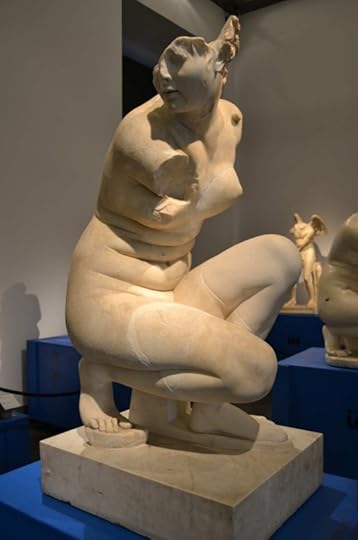 ÎÏαÏ
Î»Î¹Ï ÎδÏιανοÏ: ÎÏÏοδίÏη ÏοÏ
ÎιθÏ
νίοÏ
ÎοÏλδάÏα[4]
ÎÏαÏ
Î»Î¹Ï ÎδÏιανοÏ: ÎÏÏοδίÏη ÏοÏ
ÎιθÏ
νίοÏ
ÎοÏλδάÏα[4]Î ÎÎ¹Î³Ï ÏÏιακή ÏÏ ÏÏÎÏιÏη (και) με Ïην ÎλληνιÏÏική ÎλεξάνδÏεια!Î ÎάνÏÏÎ¿Ï - Canopus,[5] αÏοκληθείÏα γÎÏÏ Ïα μεÏÎ±Î¾Ï ÎιγÏÏÏÎ¿Ï ÎºÎ±Î¹ ΡÏμηÏ, αναÏÎÏεÏαι Ïε Îναν ÏεÏνηÏÏ Î´Î¯Î±Ï Î»Î¿ ÏÎ¿Ï ÏÏ Î½Îδεε Ïην ομÏÎ½Ï Î¼Î· ÎÎ¹Î³Ï ÏÏιακή ÏÏλη ÏÏο δÎλÏα ÏÎ¿Ï ÎÎµÎ¯Î»Î¿Ï Î¼Îµ Ïην ÎλεξάνδÏεια. Î ÏÏλη ήÏαν διάÏημη για Ïον Î½Î±Ï ÏÎ¿Ï Î£ÎµÏάÏιοÏ, ÏÎ¿Ï ÏÏην ÎÏÎ±Ï Î»Î¹Î½ ÏÎ¿Ï ÎδÏÎ¹Î±Î½Î¿Ï ÏÎ±Ï ÏίζεÏαι με Ïην δομή ÏÏο ÏÎÎ»Î¿Ï ÏÎ·Ï Î»Î¯Î¼Î½Î·Ï. Î ÎάνÏÏÎ¿Ï ÏÏίÏÏηκε ÏÏιν αÏÏ Ïο ÏÏÏÏο Ïαξίδι ÏÎ¿Ï ÎδÏÎ¹Î±Î½Î¿Ï ÏÏην ÎÎ¯Î³Ï ÏÏο, εÏομÎνÏÏ Î´ÎµÎ½ μÏοÏοÏμε να ÏοÏμε ÏÏι είναι μια ανακαÏαÏÎºÎµÏ Î® κάÏι ÏÎ¿Ï ÎµÎ¯Ïε δει Ïε Î±Ï ÏÏ Ïο Ïαξίδι.[6]
ΣÏο αÏÏγειο ÏÎ·Ï Î¡ÏμαÏÎºÎ®Ï ÎÏ ÏοκÏαÏοÏίαÏ, Ïα 'ÎÎ¹Î³Ï ÏÏιανίζονÏα' αÏÏιÏεκÏονικά ÏÏοιÏεία Îγιναν ÏÎ¿Î»Ï Î´Î·Î¼Î¿Ïιλή. ΤοÏοθεÏÎ¯ÎµÏ ÏÏÏÏ Î· ÎÏÎ±Ï Î»Î¹Ï ÏÎ¿Ï ÎδÏÎ¹Î±Î½Î¿Ï ÏÏο Tivoli, ÏÎ¿Ï ÏÏίÏÏηκε Ïον β' αιÏνα μ.Χ. ÏÏ ÎºÎ±ÏαÏÏγιο για Ïον Î±Ï ÏοκÏάÏοÏα ÎδÏιανÏ, ÏεÏÎ¹Î»Î±Î¼Î²Î¬Î½Î¿Ï Î½ Ïολλά Î±Î¹Î³Ï ÏÏιακά αγάλμαÏα και αÏÏιÏεκÏονικά ÏÏοιÏεία - ÏÏ Î¼ÏεÏιλαμβανομÎÎ½Î¿Ï tÏÎ¿Ï ÎνÏÎ¹Î½Î¿ÎµÎ¯Î¿Ï , ενÏÏ ÎÎ¹Î³Ï ÏÏÎ¹Î±ÎºÎ¿Ï ÏÏÎ¿Ï Ï Î¹ÎµÏÎ¿Ï Î±ÏιεÏÏμÎÎ½Î¿Ï ÏÏον εÏαÏÏή ÏÎ¿Ï Î±Ï ÏοκÏάÏοÏα, ÎνÏίνοο.[8]
Îι Mari και Sgalambro ÏημειÏÎ½Î¿Ï Î½ για Ïα Î ÏολεμαÏκά ÏÏοιÏεία και Ïην ανάμειξη Îλληνο - ÎλεξανδÏινÏν & κλαÏικÏν ÏÏοιÏείÏν ÎºÏ ÏίÏÏ ÏÏο εÏÏÏεÏÎ¹ÎºÏ ÏÎ¿Ï ÎνÏÎ½Î¿ÎµÎ¯Î¿Ï :[10] ΠγνÏÏη ÏÎ·Ï ÎδÏÎ¹Î¬Î½ÎµÎ¹Î±Ï Î±ÏÏιÏεκÏÎ¿Î½Î¹ÎºÎ®Ï ÎµÎ¯Î½Î±Î¹ ακÏιβÏÏ Î±ÏÏ Î±Ï Ïή Ïην άÏοÏη ÏÎ¿Ï ÏκοÏεÏÎ¿Ï Î¼Îµ να Ï ÏογÏαμμίÏÎ¿Ï Î¼Îµ Ïην ÏÏÏÏοÏÏ Ïία ÏÎ¿Ï ÏÏÎµÎ´Î¯Î¿Ï ÏÎ¿Ï ÎνÏÎ¹Î½Î¿ÎµÎ¯Î¿Ï , η οÏοία εξηγείÏαι αÏÏ Ïην ιδιαίÏεÏη ÏÏÏη Î±Ï ÏÎ¿Ï ÏÎ¿Ï ÏÏ Î³ÎºÏοÏήμαÏοÏ. Îι ομοιÏÏηÏÎµÏ Î¼Îµ Ïα ιεÏά ÏÎ·Ï Î ÏολεμαÏÎºÎ®Ï ÎºÎ±Î¹ ÏÎ·Ï Î¡ÏμαÏÎºÎ®Ï ÎιγÏÏÏÎ¿Ï ÎºÎ±Î¹ με Ïα ιεÏά ÏÎ·Ï ÎÏÎ¹Î´Î¿Ï Ïα διάÏÏαÏÏα Ïε Ïλην Ïην Î±Ï ÏοκÏαÏοÏία [37] είναι, ÏÏην ÏÏαγμαÏικÏÏηÏα, μάλλον γενικÎÏ ÎºÎ±Î¹ αÏοÏοÏν μÏνο μεμονÏμÎνα ÏÏοιÏεία ÏÎ¿Ï ÏÏÎµÎ´Î¯Î¿Ï , ÏÏÏÏ Ïο ÏÎÎ¼ÎµÎ½Î¿Ï Î® η εξÎδÏα. ÎλλείÏει ακÏιβÏν ÏληÏοÏοÏιÏν για Ïην αÏÏιÏεκÏονική ÏÏν δÏο ναÏν και άλλÏν ÏÏοιÏείÏν ÏÎ¿Ï Î®Ïαν εξ ολοκλήÏÎ¿Ï Î±ÏÏ Î¼Î¬ÏμαÏο (ÏÏÏÏ Î· εξÎδÏα - βεÏάνÏα ÏÎ¿Ï Ï ÏοÏÏηÏίζεÏαι αÏÏ ÏÎ¿Ï Ï ÏελαμÏÎ½ÎµÏ Î® η κÏÏια είÏÎ¿Î´Î¿Ï Î¼ÏÏοÏÏά αÏÏ Ïον δÏÏμο), δεν είμαÏÏε Ïε θÎÏη να καθοÏίÏÎ¿Ï Î¼Îµ Ïο Î²Î±Î¸Î¼Ï Î±Î½Î±Î¼ÎµÎ¯Î¾ÎµÏÏ Î¼ÎµÏÎ±Î¾Ï ÏÎ·Ï ÎºÎ»Î±ÏÎ¹ÎºÎ®Ï ÎºÎ±Î¹ ÏÎ·Ï ÎµÎ»Î»Î·Î½Î¿Î±Î»ÎµÎ¾Î±Î½Î´ÏÎ¹Î½Î®Ï ÏαÏαδÏÏεÏÏ ÏÏο ÎνÏινÏειο. ÎÏ ÏÏ Ïο μείγμα ήÏαν ÏÎ¯Î³Î¿Ï Ïα Ïιο εμÏανÎÏ ÏÏην διακÏÏμηÏη ÏÎ¿Ï ÎµÏÏÏεÏÎ¹ÎºÎ¿Ï ÏÏν ναÏν, αλλά εξÏÏεÏικά, Ï ÏήÏÏε ÏαÏÎ®Ï Î±Î½Î±ÏοÏά ÏÏην ÎÎ¯Î³Ï ÏÏο â ÏÏον οβελίÏκο, ÏÏα Î³Î»Ï ÏÏά διακοÏμηÏικά ÏÏοιÏεία και ÏÏο ÏÏÎδιο. ΤÎλοÏ, ÏÏ Î³ÎºÏίνονÏÎ±Ï Ïο ÏÏ Î³ÎºÏÏÏημα με ÏÏοηγοÏÎ¼ÎµÎ½ÎµÏ Î±ÏÏιÏεκÏονικÎÏ Î¼Î¿ÏÏÎÏ ÏÎ¿Ï ÏÏ Î½Î´ÎονÏαι με Ïη λαÏÏεία ÏÎ·Ï ÎÏιδοÏ, θα ÏÏÎÏει να Î»Î¬Î²Î¿Ï Î¼Îµ Ï ÏÏÏη Ïη θÎÏη ÏÎ¿Ï ÎµÏιλÎÏθηκε για Ïο ÎνÏινÏειον. Îεν θα μÏοÏοÏÏε να είÏε ÏÏοÏδιοÏιÏÏεί μÏνο αÏÏ Ïην ÏαÏÎ¿Ï Ïία ÏÎ¿Ï Î´ÏÏÎ¼Î¿Ï ÎºÎ±Ïά Î¼Î®ÎºÎ¿Ï ÏÎ¿Ï Î¿ÏÎ¿Î¯Î¿Ï ÏÏ Ïαίνει να βÏίÏκεÏαι ο ÏάÏοÏ. Σε Î±Ï ÏÏ Ïο Ïμήμα, μάλιÏÏα, ο δÏÏÎ¼Î¿Ï ÏÎ¿Ï Î¿Î´Î·Î³Î¿ÏÏε ÏÏον Îεγάλο Î Ïοθάλαμο ÏÏÏιζÏÏαν Ïε δÏο ÎºÎ»Î¬Î´Î¿Ï Ï (βλ. εικ. 2, 4). â¦.Ïα ÏοÏβλα ÏÎ¿Ï ÏÏηÏιμοÏοιήθηκαν ÏÏον ÏοίÏο Ï ÏοÏÏηÏÎ¯Î¶Î¿Ï Î½ μια ημεÏομηνία καÏά Ïο 128 μ.Χ. [38] Îίγα ÏÏÏνια αÏγÏÏεÏα ιδÏÏθηκε Ïο ÎνÏινÏειον ÏÏην κοÏÏ Ïή ή Ïε Î±Ï ÏÏν Ïον ÏεÏιÏεÏÎµÎ¹Î±ÎºÏ Î´ÏÏμο. Σε εκείνο Ïο Ïημείο, Î±Ï ÏÏ ÏÎ¿Ï Î®Ïαν μια αÏλή διαδÏομή ÏÏοÏβάÏεÏÏ ÏÏην ÎÏÎ±Ï Î»Î¹Î½, ακÏμη και αν ήÏαν μνημειακή, θα είÏε μεÏαÏÏαÏεί Ïε Îνα ÎµÎ¯Î´Î¿Ï Î´ÏÏÎ¼Î¿Ï , ή ÏελεÏÎ¿Ï ÏÎ³Î¹ÎºÎ¿Ï Î´ÏÏÎ¼Î¿Ï (ÏαÏÏμοια με ÏαÏαδείγμαÏα γνÏÏÏά Ïε Î¬Î»Î»ÎµÏ ÎµÎ»Î»Î·Î½Î¿ÏÏμαÏκÎÏ ÎÏαίεÏ), ÏÎ¿Ï ÏÏεÏίζονÏαι με Ïην ÏαÏική και θεία λαÏÏεία ÏÎ¿Ï ÏÏοÎÎºÏ Ïε Ïε εκείνο Ïο Ïημείο...
ΠΡÏμαÏκή ÏÏ ÏÏÎÏιÏη
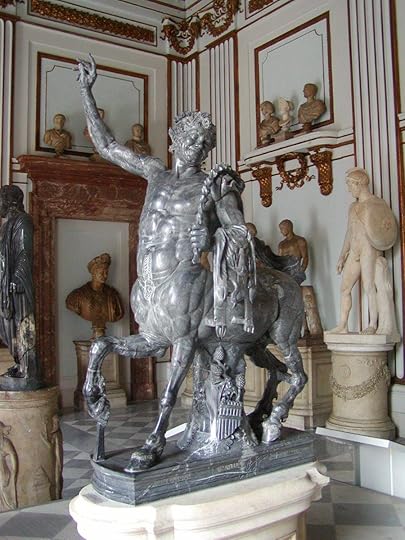 ÎλληνιÏÏικÏÏ ÎºÎνÏαÏ
ÏοÏ[13]
ÎλληνιÏÏικÏÏ ÎºÎνÏαÏ
ÏοÏ[13]ΠαÏÏλον ÏÏι Ïολλά αÏÏ Ïα κÏίÏια ÏÏ Î½Î´ÎονÏαι με διάÏημα οικοδομήμαÏα ή θÎÏÎµÎ¹Ï Ïε άλλα μÎÏη ÏÎ·Ï Î±Ï ÏοκÏαÏοÏίαÏ, οι ÏεÏνικÎÏ ÎºÎ±ÏαÏÎºÎµÏ Î®Ï ÏÎ¿Ï ÏÏηÏιμοÏοιοÏνÏαι είναι εμÏανÏικά ΡÏμαÏκÎÏ. ΣÏεδÏν Ïλα Ïα κÏίÏια είναι καÏαÏÎºÎµÏ Î±ÏμÎνα Ïε opus mixtum, μεικÏή ÏοιÏοδομία - ÎμÏλεκÏον ÎÏγον, αβακÏÏÏ / δικÏÏ ÏÏÏ,[15] ÏÏ Î½Î´Ï Î±ÏÎ¼Ï ÏÏιμÎνÏÎ¿Ï , μικÏÏν ÏοÏÏλιθÏν και ÏοÏβλÏν, ÏÎ¿Ï ÎµÎ¯Î½Î±Î¹ μια ÏεÏνική ÏÎ¿Ï ÎµÏινοήθηκε αÏÏ ÏÎ¿Ï Ï Î¡ÏÎ¼Î±Î¯Î¿Ï Ï.Îι ÏεÏνικÎÏ ÎºÎ±ÏαÏÎºÎµÏ Î®Ï Î´Î¯Î½Î¿Ï Î½ ÏÏÎ¿Ï Ï Î±ÏÏαιολÏÎ³Î¿Ï Ï Î¼ÎµÏικÎÏ ÏολÏÏÎ¹Î¼ÎµÏ ÏληÏοÏοÏÎ¯ÎµÏ ÏÎ¿Ï Î²Î¿Î·Î¸Î¿Ïν ÏÏη ÏÏονολÏγηÏη ÏÎ·Ï Î²Î¯Î»Î±Ï ÎºÎ±Î¹ ÏÏν εÏιμÎÏÎ¿Ï Ï ÎºÏιÏίÏν. Τα ÏοÏβλα είναι ÏÏ Ïνά ÏÏÏαγιÏμÎνα με Ïα ονÏμαÏα ÏÏν ΡÏμαίÏν ÏÏοξÎνÏν ÏÎ¿Ï ÎÏÎ¿Ï Ï ÏαÏαγÏÎ³Î®Ï ÎºÎ±Î¹ Î±Ï Ïή η ÏÏÏαγίδα ÏαÏÎÏει Îνα ÏÎλειο μÎÏον ÏÏονολογήÏεÏÏ Î³Î¹Î± Ïην καÏαÏÎºÎµÏ Î® ÏÏν μεμονÏμÎνÏν ÏοίÏÏν.
ΣÎÎÎÎΩΣÎÎΣ
[0]. Wikipedia, s.v. Adrian.
[0a]. McFarlane 2003, p. 30, nn. 23, 25. ÎÏ
ÏÎÏ Î¿Î¹ Ï
ÏαινικÏικÎÏ ÎµÎ³ÏάÏακÏÎµÏ Î® μή αναÏοÏÎÏ ÎµÎ¼ÏανίÏÏηκαν εÏίÏÎ·Ï ÏÏα ελληνιÏÏικά ανάκÏοÏα (Nielsen 1994 ÎαÏ. 20, για ÏαÏάδειγμα, Ïε Îναν ÎάιανδÏο - ÏοÏ
ÏÏ
νήθÏÏ Î»Î±Î¼Î²Î¬Î½ÎµÏαι ÏÏ Î±Î½Î±ÏοÏά Ïε Îνα ÎµÎ¯Î´Î¿Ï Î´Î¹Î±ÏλοÏ
ÏοÏ
θÏ
μίζει Ïον ÏοÏÎ±Î¼Ï ÎαίανδÏο - ÏÏο Î ÏολεμαÏÎºÏ Î±Î½Î¬ÎºÏοÏο ÏÏην ÎλεξάνδÏεια).
[0aa]. Pair of Centaurs Fighting Wild Cats Mosaic from Hadrianâs Villa, ca. 120-130 AD, Altes Museum Berlin.
[0aaa]. Google Arts & Cultures, s.v. Centaur mosaic from the Villa Hadriana, <https://artsandculture.google.com/ass...
[0aaaa]. Villa Adriana.
[1]. Villa Adriana (Tivoli), UNESCO, World Heritage Convention.
[2]. McFarlane 2003.
[4]. ÎνÏίγÏαÏο ÎÎ»Î»Î·Î½Î¹ÎºÎ¿Ï ÎÏγοÏ
. From the Heliocaminus Baths, the eastern side of the natatio pool. (Rome, Palazzo Massimo alle Terme).
[5]. Î ÎάνÏÏοÏ, αÏÏικÏÏ ÏÏÏÎ¿Ï ÎάνÏβοÏ, αÏανÏÏÎ¼ÎµÎ½Î¿Ï ÏÏοÏ
Ï ÎÏαÏοÏθÎνη και Î Ïολεμαίο, ήÏαν ÎÎ½Î±Ï ÎμÏ
ÎºÎ»Î±Î¯Î¿Ï Î³Î½ÏÏÏÏÏ Î±ÏÏ Ïο ÏÏι ÏÏ
μμεÏείÏε ÏÏην ΤÏÏική ÎκÏÏÏαÏεία ÏÏ Î¿ ÏλοίαÏÏÎ¿Ï ÎºÎ±Î¹ ÏλοηγÏÏ ÏοÏ
ÎενελάοÏ
.
[6]. Villa Adriana (Tivoli), UNESCO, World Heritage Convention.
[8]. Raddato 2016; Jo Adetunji 2018.
[10]. Mari and Sgalambro 2007, pp. 101-102.Jo Adetunji. 2018.
[13]. Îι λεγÏμενοι κÎνÏαÏ
Ïοι Furietti είναι δÏο μαÏμάÏινα γλÏ
ÏÏά, ανακαλÏ
ÏθÎνÏα αÏÏ Ïον Monsignor Furietti Ïον ÎεκÎμβÏιο ÏοÏ
1736 ÏÏα εÏείÏια ÏÎ·Ï ÎÏαÏλεÏÏ ÎδÏιανοÏ, ÏÏ
λάÏÏονÏαι δε ÏÏο ÎοÏ
Ïείο Capitoline. Τα αγάλμαÏα ÏαÏιÏÏοÏν Îναν νÎο, ÏαÏοÏμενο κÎνÏαÏ
Ïο και Îναν μεγαλÏÏεÏο, ÏÎ¹Ï ÏοβαÏÏ. Îι βάÏÎµÎ¹Ï ÏοÏ
Ï ÏÎÏοÏ
ν Ïην Ï
ÏογÏαÏή ÏοÏ
ÎΡÎΣΤÎΠκαι ÏοÏ
Î ÎÎ ÎÎ ÏÎ·Ï ÎÏÏοδιÏιάδοÏ.
[15]. Koutsoumpos 2021.
Villa Adriana (Tivoli), UNESCO, World Heritage Convention, <https://whc.unesco.org/en/list/907/?f... (3 August 2022).
https://kclpure.kcl.ac.uk/portal/file...
McFarlane, F. 2003. "The decorative use of water at Hadrian's Villa, Tivoli, and its ancient Roman context" (diss. King's College London).
Nielsen, I. 1994. Hellenistic Palaces tradition and renewal, Aarhus.
https://www.jstor.org/stable/40024582..., Z. and S. Sgalambro. 2007. "The Antinoeion of Hadrian's Villa: Interpretation and Architectural Reconstruction," AJA 111 (1), pp. 83-104. (22 pages), Ïελ. 101-102.. knowlellge of Hadrianic architecture is precisely from this point of view that we intend to underline the originality of the plan of the Antinoeion, which is explained by the particular nature of this complex. The similarities with the sanctuaries of Ptolemaic and Roman Egypt and with the Isea scattered throughout the empire [37] are, in fact, rather generic and relevant only to individual elements of the plan, such as the temenos or the exedra. In the absence of precise information on the architecture of the two temples and other elements that were entirelly of marble (such as the porch supported by the telamons or the principal entrance front the street), we are not in a position to establishe the degree of blending between the classical tradition and the Graeco-Alexandrian tradition in the Antinoeion. This mix was certainly more evident in the decoration inside the temples, but on the outside, there was a clear reference to Egyptâin the obelisk, the sculptural ornaments, and the plan. Finally, in comparing the complex with previous architectural forms associated with Isiac cult, we should consider the location chosen for the Antinoeion. It could not have been determined solely by the presence of the street along which the tomb happens to lie. In that stretch, in fact, the street that led to the Grand Vestiibule split into two branches (see fig. 2, 4 ). â¦.the brickstamps used in the wall support a date of 128 CE. [38] A few years later the Antinoeion was founded at the head or this ring road. At that point, what had been a simple access route to the villa, even if it was monumentalized, would have been reworked to become a kind of dromos, or ceremonial road (similar to examples known in other Graeco-Roman Isea), related to the funerary and divine cult that arose on that spot.
ΠγνÏÏη ÏÎ·Ï ÎδÏÎ¹Î¬Î½ÎµÎ¹Î±Ï Î±ÏÏιÏεκÏÎ¿Î½Î¹ÎºÎ®Ï ÎµÎ¯Î½Î±Î¹ ακÏιβÏÏ Î±ÏÏ Î±Ï Ïή Ïην άÏοÏη ÏÎ¿Ï ÏκοÏεÏÎ¿Ï Î¼Îµ να Ï ÏογÏαμμίÏÎ¿Ï Î¼Îµ Ïην ÏÏÏÏοÏÏ Ïία ÏÎ¿Ï ÏÏÎµÎ´Î¯Î¿Ï ÏÎ¿Ï ÎνÏÎ¹Î½Î¿ÎµÎ¯Î¿Ï , η οÏοία εξηγείÏαι αÏÏ Ïην ιδιαίÏεÏη ÏÏÏη Î±Ï ÏÎ¿Ï ÏÎ¿Ï ÏÏ Î³ÎºÏοÏήμαÏοÏ. Îι ομοιÏÏηÏÎµÏ Î¼Îµ Ïα ιεÏά ÏÎ·Ï Î ÏολεμαÏÎºÎ®Ï ÎºÎ±Î¹ ÏÎ·Ï Î¡ÏμαÏÎºÎ®Ï ÎιγÏÏÏÎ¿Ï ÎºÎ±Î¹ με Ïα ιεÏά ÏÎ·Ï ÎÏÎ¹Î´Î¿Ï Ïα διάÏÏαÏÏα Ïε Ïλην Ïην Î±Ï ÏοκÏαÏοÏία [37] είναι, ÏÏην ÏÏαγμαÏικÏÏηÏα, μάλλον γενικÎÏ ÎºÎ±Î¹ αÏοÏοÏν μÏνο μεμονÏμÎνα ÏÏοιÏεία ÏÎ¿Ï ÏÏÎµÎ´Î¯Î¿Ï , ÏÏÏÏ Ïο ÏÎÎ¼ÎµÎ½Î¿Ï Î® η εξÎδÏα. ÎλλείÏει ακÏιβÏν ÏληÏοÏοÏιÏν για Ïην αÏÏιÏεκÏονική ÏÏν δÏο ναÏν και άλλÏν ÏÏοιÏείÏν ÏÎ¿Ï Î®Ïαν εξ ολοκλήÏÎ¿Ï Î±ÏÏ Î¼Î¬ÏμαÏο (ÏÏÏÏ Î· εξÎδÏα - βεÏάνÏα ÏÎ¿Ï Ï ÏοÏÏηÏίζεÏαι αÏÏ ÏÎ¿Ï Ï ÏελαμÏÎ½ÎµÏ Î® η κÏÏια είÏÎ¿Î´Î¿Ï Î¼ÏÏοÏÏά αÏÏ Ïον δÏÏμο), δεν είμαÏÏε Ïε θÎÏη να καθοÏίÏÎ¿Ï Î¼Îµ Ïο Î²Î±Î¸Î¼Ï Î±Î½Î±Î¼ÎµÎ¯Î¾ÎµÏÏ Î¼ÎµÏÎ±Î¾Ï ÏÎ·Ï ÎºÎ»Î±ÏÎ¹ÎºÎ®Ï ÎºÎ±Î¹ ÏÎ·Ï ÎµÎ»Î»Î·Î½Î¿Î±Î»ÎµÎ¾Î±Î½Î´ÏÎ¹Î½Î®Ï ÏαÏαδÏÏεÏÏ ÏÏο ÎνÏινÏειο. ÎÏ ÏÏ Ïο μείγμα ήÏαν ÏÎ¯Î³Î¿Ï Ïα Ïιο εμÏανÎÏ ÏÏην διακÏÏμηÏη ÏÎ¿Ï ÎµÏÏÏεÏÎ¹ÎºÎ¿Ï ÏÏν ναÏν, αλλά εξÏÏεÏικά, Ï ÏήÏÏε ÏαÏÎ®Ï Î±Î½Î±ÏοÏά ÏÏην ÎÎ¯Î³Ï ÏÏο â ÏÏον οβελίÏκο, ÏÏα Î³Î»Ï ÏÏά διακοÏμηÏικά ÏÏοιÏεία και ÏÏο ÏÏÎδιο. ΤÎλοÏ, ÏÏ Î³ÎºÏίνονÏÎ±Ï Ïο ÏÏ Î³ÎºÏÏÏημα με ÏÏοηγοÏÎ¼ÎµÎ½ÎµÏ Î±ÏÏιÏεκÏονικÎÏ Î¼Î¿ÏÏÎÏ ÏÎ¿Ï ÏÏ Î½Î´ÎονÏαι με Ïη λαÏÏεία ÏÎ·Ï ÎÏιδοÏ, θα ÏÏÎÏει να Î»Î¬Î²Î¿Ï Î¼Îµ Ï ÏÏÏη Ïη θÎÏη ÏÎ¿Ï ÎµÏιλÎÏθηκε για Ïο ÎνÏινÏειον. Îεν θα μÏοÏοÏÏε να είÏε ÏÏοÏδιοÏιÏÏεί μÏνο αÏÏ Ïην ÏαÏÎ¿Ï Ïία ÏÎ¿Ï Î´ÏÏÎ¼Î¿Ï ÎºÎ±Ïά Î¼Î®ÎºÎ¿Ï ÏÎ¿Ï Î¿ÏÎ¿Î¯Î¿Ï ÏÏ Ïαίνει να βÏίÏκεÏαι ο ÏάÏοÏ. Σε Î±Ï ÏÏ Ïο Ïμήμα, μάλιÏÏα, ο δÏÏÎ¼Î¿Ï ÏÎ¿Ï Î¿Î´Î·Î³Î¿ÏÏε ÏÏον Îεγάλο Î Ïοθάλαμο ÏÏÏιζÏÏαν Ïε δÏο ÎºÎ»Î¬Î´Î¿Ï Ï (βλ. εικ. 2, 4). â¦.Ïα ÏοÏβλα ÏÎ¿Ï ÏÏηÏιμοÏοιήθηκαν ÏÏον ÏοίÏο Ï ÏοÏÏηÏÎ¯Î¶Î¿Ï Î½ μια ημεÏομηνία καÏά Ïο 128 μ.Χ. [38] Îίγα ÏÏÏνια αÏγÏÏεÏα ιδÏÏθηκε Ïο ÎνÏινÏειον ÏÏην κοÏÏ Ïή ή Ïε Î±Ï ÏÏν Ïον ÏεÏιÏεÏÎµÎ¹Î±ÎºÏ Î´ÏÏμο. Σε εκείνο Ïο Ïημείο, Î±Ï ÏÏ ÏÎ¿Ï Î®Ïαν μια αÏλή διαδÏομή ÏÏοÏβάÏεÏÏ ÏÏην ÎÏÎ±Ï Î»Î¹Î½, ακÏμη και αν ήÏαν μνημειακή, θα είÏε μεÏαÏÏαÏεί Ïε Îνα ÎµÎ¯Î´Î¿Ï Î´ÏÏÎ¼Î¿Ï , ή ÏελεÏÎ¿Ï ÏÎ³Î¹ÎºÎ¿Ï Î´ÏÏÎ¼Î¿Ï (ÏαÏÏμοια με ÏαÏαδείγμαÏα γνÏÏÏά Ïε Î¬Î»Î»ÎµÏ ÎµÎ»Î»Î·Î½Î¿ÏÏμαÏκÎÏ ÎÏαίεÏ), ÏÎ¿Ï ÏÏεÏίζονÏαι με Ïην ÏαÏική και θεία λαÏÏεία ÏÎ¿Ï ÏÏοÎÎºÏ Ïε Ïε εκείνο Ïο Ïημείο...
Nielsen, I. 1994. Hellenistic Palaces tradition and renewal, Aarhus.
https://www.academia.edu/19461652/The... Garcia. 2014. "The Maritime Theatre, Heliocaminus Baths and the Hall of the Philosophers,"
https://www.academia.edu/34799087/Had..., T., ed. 2016. Hadrian: Art, Politics and Economy, British Museum.
https://www.academia.edu/13750028/Pro..., P., F. Antonelli, L. Lazzarini, S. Cancelliere. 2012. "Provenance of marble sculptures and artifacts from the so-called Canopus and other buildings of âVilla Adrianaâ (Hadrianâs villa e Tivoli, Italy)," Journal of Archaeological Science 39 (5), pp. 1331-1337.
Raddato, C. 2016. "The Obelisk of Antinous," World history at cetera, <https://etc.worldhistory.org/travel/t... (6 August 2022).
https://www.jstor.org/stable/40024582..., Z., and S. Sgalambro. 2007. "The Antinoeion of Hadrian's Villa: Interpretation and Architectural Reconstruction," AJA 111 (1), pp. 83-104.
Jo Adetunji. 2018. "Romeâs Flaminian Obelisk: an epic journey from divine Egyptian symbol to tourist attraction," The Conversation, <https://theconversation.com/romes-fla... (8 Aygust 2022). https://books.google.gr/books?id=7h1Y...
Koutsoumpos, N. 2021.The Archaeological Dictionairy: English-Greek/Greek-English, Archaeopress.
https://sights.seindal.dk/italy/lazio... Villa, <https://sights.seindal.dk/italy/lazio...
July 31, 2022
FAR FASCIST BEHAVIOUR FROM LYN GREEN AND FACEBOOK GROUP 'FAYUM PORTAITS'!
ÎÎÎΡΤÎΣΠ- ÏεÏιÎÏÎ¿Ï Ïα μÏνον αÏοÏÏάÏμαÏα καÏαξιÏμÎνÏν εÏÎµÏ Î½Î·ÏÏν - Îνεκα ÏÎ·Ï Î¿ÏÎ¿Î¯Î±Ï Î´Î¹ÎµÎ³ÏάÏην αÏÏ Ïην ÏαÏιÏÏικÏν ανÏιλήÏεÏν ομάδα FAYUM PORTRAITS Ïη βοηθεία και ÏÎ·Ï 'εÏιÏÏημÏνιÏÏαÏ' Lyn Green (ROYAL ONTARIO MUSEUM).
[image error] The Girl with the Golden Wreathpainting and gold leaf on wooden panel; perhaps from Hawara (Fayum), Egypt; ca. 50â100 ce [Photography by Michiel Bootsman; courtesy of the Allard Pierson Museum]
The girlâs portrait offers the visitors a fascinating glimpse not only of the blending of Greek, Roman and Egyptian funerary practices and beliefs, but also the entanglements of Greek, Roman and Egyptian religious, cultural and artistic traditions. The panel portrait was originally inserted into the wrappings of the girlâs mummified remains. Mummification, to be sure, was an age-old Egyptian funerary practice dating back to the Early Dynastic Period (mid 3rd mill. bce [sometimes using Chios pistachio!]). This treatment of the deceased was believed to be necessary to preserve the body for the personâs spiritual entities beyond death, so that the individual could live on in the afterworld. The golden wreath in the girlâs short hair symbolizes her good fortune and divine protection in the afterlife after passing through the judgment before Osiris. During that Judgment, the deadâs heart is weighed against the feather of Maâat. Should they fail the judgement, a monstrous being, called Ammit, would devour the dead. .................................... Some of the wealthiest tombs show that GREEKS [Macedonians included] could also adorn their dead with golden wreaths even before the HELLENISTIC period, and this practice may be related to the mystery cults. In Hellenistic and Roman Egypt, these various funerary and religious traditions merged through the adoption and adaptation of different practices and beliefs. ...................................... The ENCAUSTIC painting technique was first developed in Classical Greece. The decoration of mummies with a panel portrait or one painted on linen was an invention of the Roman period. [NO THIS IS NOT TRUE:] (During the Hellenistic and Roman Imperial period, a more naturalistic stucco mask could be inserted into the mummy). It may be speculated that the invention was somehow related to the Roman conquest. Exactly why painted portraits were suddenly added to the mummified body of the deceased, however, remains uncertain. During her keynote address .. Susan Walker pointed out that the linden wood on which many Fayum portraits were painted generally derives from SE Europe, thus including the heartland of the MACEDONIAN veterans who settled in Egypt in the Hellenistic period. SOURCE: with minor mods & insertions [], "The Girl with the Golden Wreath: Four Perspectives on a Mummy Portrait", Judith Barr, Clara M. ten Berge, Jan M. van Daal and Branko F. van Oppen de Ruiter, mdpi
Egyptâs millennia-long tradition of accompanying the dead with protective gods is an international hallmark of iconography. Lifelike portraits combined with Egyptian imagery and symbols of the afterlife seem an incongruous juxtaposition but are characteristic during the first three-four centuries C.E., when funerary shrouds painted with traditional flat Egyptian registers of gods enacting rejuvenation rites accompanied lifelike portraits of the dead painted according to the Greek tradition (Riggs 2005:98, figure 39). Where in several centuries there will be a mixture of pagan and Christian symbolism, at this time thereis a co mbination of Greek, Roman, and Egyptian style and iconography that could have made possible the assembly of a triptych or shrine to the memory of a departed Roman who placed religious value in the powerful protection of Isis and Serapis (Rondot 2013:262 [quoting Lorelei Corcoran]). In the portraits of the gods, linearity is replaced by modulation and two-dimensionality by the use of a variety of hues to achieve a three-dimensional portrayal. With their reference to future iconic imagery, it can be seen that representing Egyptian gods in Hellenistic Greek form pointed toward traditional imagery associated with the icon.Pagan icons such as Isis and Serapis provide a historical context for that practice of worship, which in this format comingled with the cult of the dead and bound the living to the deceased in piety.It is only a step to consider the origin of icon painting in this context, and scholars have seen that the religious phenomenon of venerating the icon started in the home, and in Egypt, where Mary first received the epithet Theotokos, a title once reserved for Isis (Mathews 2005:47). SOURCE: Hart, M. L. 2016. âA Portrait of a Bearded Man Flanked by Isis and Serapis,â in Icon, Cult, and Context: Sacred Spaces and Objects in the Classical World, ed. M. K. Heyn, A. I. Steinsapir, Ann I, Cotsen Institute of Archaeology Press, pp. 79-89.
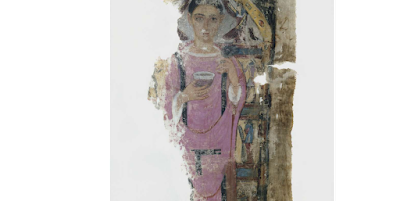 BRITISH MUSEUM EA68509, Christina Riggs. The Beautiful Burial in Roman Egypt: Art, Identity, and Funerary Religion, pl. 6
BRITISH MUSEUM EA68509, Christina Riggs. The Beautiful Burial in Roman Egypt: Art, Identity, and Funerary Religion, pl. 6Τα ολÏÏÏμα Ïάβανα με ÏÏ ÏιοκÏαÏικοÏÏ ÎÎÎÎÎÎÎÎΥΣ ÏÎ¯Î½Î±ÎºÎµÏ ÏÎ¿Ï ÎµÎºÎ»Î¹ÏÏνÏÎ¿Ï ÏÏ Î½Î¹ÏÏοÏν μοναδικÎÏ ÎµÏιβιÏÏÎµÎ¹Ï Î±ÏÏ Ïην ΡÏμαÏκή ÎÎ¯Î³Ï ÏÏο. Σε Î±Ï ÏÏ Ïο ÏαÏάδειγμα, μια Î³Ï Î½Î±Î¯ÎºÎ± με Ïοζ ÏιÏÏνα και μανδÏα κÏαÏά νεκÏικÎÏ ÏÏοÏÏοÏÎÏ Î¼Îµ οίνο και άνθη. Το ÏλαίÏιο με ημιÏολÏÏÎ¹Î¼Î¿Ï Ï Î»Î¯Î¸Î¿Ï Ï Ïε ÏοξÏÏή Î´Î¹ÎµÏ Î¸ÎÏηÏη ÏÎ¬Î½Ï Î±ÏÏ Ïην κεÏαλή ÏÎ·Ï Ïηγάζει αÏÏ ÏÎ¹Ï ÏÏÎ®Î»ÎµÏ ÏÏν Î±Î¹Î³Ï ÏÏιακÏν ÏκηνÏν δίÏλα ÏηÏ. ÎÏγÏαÏιÏμÎνο λινÏ, β' μιÏÏ 2Î¿Ï Î±Î¹. --------------------------------------------------------------------------------- Full length shroud with naturalistic GREEK paintings of the deceased are unique survivals from Roman Egypt. In this example a woman in pink tunic and mantle holds funerary offerings of wine and flowers. The jewelled frame arched over her head springs from the columns of Egyptian scenes beside her. Painted linen, 2nd half of the 2nd c. BRITISH MUSEUM EA68509, Christina Riggs. The Beautiful Burial in Roman Egypt: Art, Identity, and Funerary Religion, pl. 6
ÎÎÎÎÎÎÎΡÎΦÎÎ
Lyn Green, Royal Ontario Museum, Department of World Cultureshttps://rom.academia.edu/LynGreen?fbc...
https://www.academia.edu/1154089/Quee..., L. 1988. "Queens and Princesses of the Amarna Period" (diss. Univ. of Toronto.
https://www.mdpi.com/2076-0752/8/3/92..., J., C. M. ten Berge, J. M. van Daal and B. F. van Oppen de Ruiter. 2019. "The Girl with the Golden Wreath: Four Perspectives on a Mummy Portrait," Arts 8(3), 92; https://doi.org/10.3390/arts8030092
Hart, M. L. 2016. âA Portrait of a Bearded Man Flanked by Isis and Serapis,â in Icon, Cult, and Context: Sacred Spaces and Objects in the Classical World, ed. M. K. Heyn, A. I. Steinsapir, Ann I, Cotsen Institute of Archaeology Press, pp. 79-89.
Riggs, C. 2006. The Beautiful Burial in Roman Egypt: Art, Identity, and Funerary Religion, pl. 6, Oxford and New York: Oxford University Press, 2006.
http://oi.uchicago.edu/pdf/saoc56.pdf..., L. H. 1995. Portait Mummies from Roman Egypt (I-IV centuries), SAOC 56, Chicago.
Tarán, S. L. 1985. "Îá¼°Ïὶ ÏÏίÏεÏ: An Erotic Motif in the Greek Anthology," The Journal of Hellenic Studies 105, pp. 90-107.
https://www.jstor.org/stable/3822166h..., D. 1993. "The Representation of Young Males in 'Fayum Portraits'," The Journal of Egyptian Archaeology 79, pp. 215-225.
Ïελ. 216-7: ηλικιακÎÏ ÎºÎ±ÏηγοÏÎ¯ÎµÏ Î±Î½Î´ÏÏν: á¼ÏÏÎ¿Ï (untimely dead), á¼ÏÏι γενειάÏκÏν [αÏÏιγÎνειοÏ], á¼ÏÏι δ᾽ á¼ÏÏÏÎ±Ï á¼Ï Î¸Î±Î»Î¬Î¼Î¿Ï Ï ÎºÎ±Î»ÎÏν
Anth. Pal. VII, 123,â Els Îá½Ïήμιον ῬήÏÏÏ á¼Î½ ῥηÏá¿ÏÏιν, á¼Î¿Î¹Î´Î¿ÏÏÎ»Î¿Ï Î´á¾½ á¼Î½ á¼Î¿Î¹Î´Î¿á¿Ï, Îºá¿¦Î´Î¿Ï á¼á¿Ï ÏάÏÏηÏ, Îºá¿¦Î´Î¿Ï á¼á¿¶Î½ ÏοκÎÏν, á¼ÏÏι γενειάÏκÏν Îá½ÏήμιοÏ, á¼ÏÏι δ᾽ á¼ÏÏÏÎ±Ï á¼Ï Î¸Î±Î»Î¬Î¼Î¿Ï Ï ÎºÎ±Î»ÎÏν, ὥλεÏο' Ïεῦ ÏαθÎÏν" á¼Î½Ïὶ δὲ ÏαÏθενικá¿Ï ÏÏμβον λάÏεν, ἠδ᾽ á½Î¼ÎµÎ½Î±Î¯Ïν ὠἤμαÏα Î½Ï Î¼ÏιδίÏν á¼¦Î¼Î±Ï á¼Ïá¿Î»Î¸Îµ γÏÏν.
p. 218ceremonies of social inclusion. These typically include rituals of initiation at puberty, which can involve 'cultural work upon the body, and their effect is to transform the natural body into a social entity with rights and status.17 For the teenaged sons of the Hellenised elite in provincial Egypt, these rituals revolved around a public status declaration. in effect an affirmation of their membership of the paternal kin-group. This public status declaration or 'scrutiny` (εÏίκÏιÏÎ¹Ï or είÏκÏιÏιÏ) confirmed the boy's lineage and his inclusion in one of several privileged groups eligible for fiscal and other privileges: the 'metropolitan twelve drachma class' (μηÏÏοÏολίÏαι δÏδεκάδÏαÏμοι), 'the gymnasium members' (οι αÏÏ ÏÎ¿Ï Î³Ï Î¼Î½Î±ÏÎ¯Î¿Ï ). or the ephebate (εÏηβεία). Written declarations of εÏίκÏιÏÎ¹Ï or είÏκÏιÏÎ¹Ï were usually made in the year when the declarant reached the age of thirteen or fourteen, thus becoming liable to pay the full rate of capitation lax. They state that the boy 'has entered into the class of thirteen (or fourteen)-year-olds' (ÏÏοÏβάνÏÎ¿Ï ÎµÎ¹Ï ÏÏιÏκεδεκαεÏÎµÎ¯Ï / ÏεÏÏαÏεÏκαιδεκαεÏείÏ) in a given year.18 I have argued elsewhere''' that these status declarations signify more than a mere bureaucratic formality to gain tax relief, and that they were one component of an entire rites de passage system whose other elements could include 'cultural work upon the body' in the form of shearing off hair to mark transition, and also celebratory garlanding and banqueting. The epicrisis festivities could take place in important public buildings, such as the Capitolium, the traditional scene of Roman rites de passage.19 Formal enumeration of the hay's ancestry may also have played a part. Some icrisis declarations, such as P. Oxy. XVIII 2186, list forbears going back as far as seven generations, and these lists may well have been read out aloud at the time the document was drawn up or submitted. Reading out aloud would have served to underscore the boy's own name, (which characteristically followed that of a grandfather),21 and thus his standing and affiliation in the paternal kin-group, 'since having a name is an institutional mark of social membership.'22 The exact function and organisation in Roman Egypt of the other elite group for adolescents, the ephebate, is still unclear, as is its relationship to the Athenian body of youths with the same name and to the other selected social groups_ As P. Oxy. IV 7o5 tells us, some boys of the gymnasial class could be enrolled into it after a further examination of suitability. The length of a boy's ephebic service is uncertain, but was ..p. 220Conversely, there do not seem to be any purely Egyptian attestations of the wearing of moustaches by adolescents, which is unsurprising given the traditional Egyptian emphasis on hairlessness as a manifestation of physical and spiritual cleanliness. Furthermore, it would have been very difficult to indicate precise age categories within the representational canons of dynastic Egyptian art. The depiction of adolescent facial hair, therefore, suggests that we are dealing with a milieu in which the dominant cultural influence is Greek rather than Roman. This does not mean, however, that hair lacked symbolic potency in Pharaonic Egypt, or that rituals surrounding its shearing and preservation were Hellenistic innovations. At least as early as the New Kingdom, hair appears in contexts strongly suggestive of life-crisis rites.34 The showing of slight facial hair on the portrait of a young man, therefore, had a far wider symbolic value than might at first appear. It indicated that the deceased had died at a stage in his life when he was at his [NEXT PAGE IS 221]p. 221optimum sexual vitality and attractiveness, at least according to Hellenistic perceptions. It also made a statement about the social standing of the dead man as a Graeco-Egyptian who followed some Greek traditions associated with hair and puberty. Showing the moustache would have been one of the visual elements which helped to both idealise and eroticise the dead man so that he could be reborn in a perfect and vital form, in just the same way that Pharaonic tomb paintings can show a quintessential image or simulacrum of the deceased surrounded by erotic references.35 A variant set of symbols indicative of the connection between male physical vitality and bodily resurrection is found on the so-called 'tondo of the two brothers', found at Antinoopolis and how in Cairo (pl. XIII, I = Parlasca t, no. 166). The two men, both lightly moustached, ungarlanded and fully clothed, are flanked by golden figures of two syncre-tistic gods bath associated with death and renewal: Hermanubis on the viewer's right and Osirantinous on the left. Osirantinous is crowned and naked: as Hugo Meyer has suggested, his nudity is neither incidental nor erotic, but characteristic of the ephebe that he had been in life, and perhaps has further associations of the renaissance of Hellenism and Hellenic culture in Egypt under Hadrian.36 At the edge of the panel, by the pedestal of the Osirantinous statue, is the date 15 Pachon [ΠαÏÏν] (early May). The younger-looking man on the viewer's left wears a white tunic, its right shoulder ornamented with a gammadion or swastika-like symbol composed of four Î-shaped elements. This was later appropriated as a symbol of the trinity, the resurrection and of Christ himself,37 but in pre- Christianity it also had phallic connotations,38 making it an appropriate symbol for a context associated with death and rebirth. All in all, the Antinoοpolis tondo is an anomaly within the corpus of funerary portraits, and one wonders whether its unique format and array of symbols might commemorate something unusual about the two deceased men, such as the circumstances of death.39
p. 222: ephebate + garlandp. 223:
p. 270, Preisigke, F. 1915. Sammelbuch Griechischer Urkunden aus AÌgypten, Strassburg : K.J. TruÌbnerhttps://archive.org/details/sammelbuc.... Grabstein. Alexandria. Konstantinische Zeit. N&eroutsos, Rev. arch. 9 (1887) 5. 201 Nr. 4.
ÎάκÏÏ Ïον εἰÏοÏÏÏν με | ÎιÏÏκοÏον á¼Î»Î»Î¬Î´Î¿Ï Ï á¼±Ïν, | Ïὸν ÏοÏὸν á¼Î½ ÎοÏÏÎ±Î¹Ï | καὶ νÎον ἩÏακλÎα.
FAR FASCIST BEHAVIOUR FROM LYN GREEN AND FACEBOOK FROUP 'FAYUM PORTAITS'!
 The Girl with the Golden Wreath
The Girl with the Golden Wreathpainting and gold leaf on wooden panel; perhaps from Hawara (Fayum), Egypt; ca. 50â100 ce [Photography by Michiel Bootsman; courtesy of the Allard Pierson Museum] --------------------------------------------------------------------------------The girlâs portrait offers the visitors a fascinating glimpse not only of the blending of Greek, Roman and Egyptian funerary practices and beliefs, but also the entanglements of Greek, Roman and Egyptian religious, cultural and artistic traditions. The panel portrait was originally inserted into the wrappings of the girlâs mummified remains. Mummification, to be sure, was an age-old Egyptian funerary practice dating back to the Early Dynastic Period (mid 3rd mill. bce [sometimes using Chios pistachio!]). This treatment of the deceased was believed to be necessary to preserve the body for the personâs spiritual entities beyond death, so that the individual could live on in the afterworld. The golden wreath in the girlâs short hair symbolizes her good fortune and divine protection in the afterlife after passing through the judgment before Osiris. During that Judgment, the deadâs heart is weighed against the feather of Maâat. Should they fail the judgement, a monstrous being, called Ammit, would devour the dead. .................................... Some of the wealthiest tombs show that GREEKS [Macedonians included] could also adorn their dead with golden wreaths even before the HELLENISTIC period, and this practice may be related to the mystery cults. In Hellenistic and Roman Egypt, these various funerary and religious traditions merged through the adoption and adaptation of different practices and beliefs. ...................................... The ENCAUSTIC painting technique was first developed in Classical Greece. The decoration of mummies with a panel portrait or one painted on linen was an invention of the Roman period. [NO THIS IS NOT TRUE:] (During the Hellenistic and Roman Imperial period, a more naturalistic stucco mask could be inserted into the mummy). It may be speculated that the invention was somehow related to the Roman conquest. Exactly why painted portraits were suddenly added to the mummified body of the deceased, however, remains uncertain. During her keynote address .. Susan Walker pointed out that the linden wood on which many Fayum portraits were painted generally derives from SE Europe, thus including the heartland of the MACEDONIAN veterans who settled in Egypt in the Hellenistic period. SOURCE: with minor mods & insertions [], "The Girl with the Golden Wreath: Four Perspectives on a Mummy Portrait", Judith Barr, Clara M. ten Berge, Jan M. van Daal and Branko F. van Oppen de Ruiter, mdpi
Egyptâs millennia-long tradition of accompanying the dead with protective gods is an international hallmark of iconography. Lifelike portraits combined with Egyptian imagery and symbols of the afterlife seem an incongruous juxtaposition but are characteristic during the first three-four centuries C.E., when funerary shrouds painted with traditional flat Egyptian registers of gods enacting rejuvenation rites accompanied lifelike portraits of the dead painted according to the Greek tradition (Riggs 2005:98, figure 39). Where in several centuries there will be a mixture of pagan and Christian symbolism, at this time thereis a co mbination of Greek, Roman, and Egyptian style and iconography that could have made possible the assembly of a triptych or shrine to the memory of a departed Roman who placed religious value in the powerful protection of Isis and Serapis (Rondot 2013:262 [quoting Lorelei Corcoran]). In the portraits of the gods, linearity is replaced by modulation and two-dimensionality by the use of a variety of hues to achieve a three-dimensional portrayal. With their reference to future iconic imagery, it can be seen that representing Egyptian gods in Hellenistic Greek form pointed toward traditional imagery associated with the icon.Pagan icons such as Isis and Serapis provide a historical context for that practice of worship, which in this format comingled with the cult of the dead and bound the living to the deceased in piety.It is only a step to consider the origin of icon painting in this context, and scholars have seen that the religious phenomenon of venerating the icon started in the home, and in Egypt, where Mary first received the epithet Theotokos, a title once reserved for Isis (Mathews 2005:47). SOURCE: Hart, M. L. 2016. âA Portrait of a Bearded Man Flanked by Isis and Serapis,â in Icon, Cult, and Context: Sacred Spaces and Objects in the Classical World, ed. M. K. Heyn, A. I. Steinsapir, Ann I, Cotsen Institute of Archaeology Press, pp. 79-89.
ÎλÏÏÏμο Ïάβανο με ÏÏ ÏιοκÏαÏικοÏÏ ÎÎÎÎÎÎÎÎΥΣ ÏÎ¯Î½Î±ÎºÎµÏ ÏÎ¿Ï ÎµÎºÎ»Î¹ÏÏνÏÎ¿Ï ÎµÎ¯Î½Î±Î¹ μοναδικÎÏ ÎµÏιβιÏÏÎµÎ¹Ï Î±ÏÏ Ïην ΡÏμαÏκή ÎÎ¯Î³Ï ÏÏο. Σε Î±Ï ÏÏ Ïο ÏαÏάδειγμα, μια Î³Ï Î½Î±Î¯ÎºÎ± με Ïοζ ÏιÏÏνα και μανδÏα κÏαÏά νεκÏικÎÏ ÏÏοÏÏοÏÎÏ Î¼Îµ οίνο και άνθη. Το ÏλαίÏιο με ημιÏολÏÏÎ¹Î¼Î¿Ï Ï Î»Î¯Î¸Î¿Ï Ï Ïε ÏοξÏÏή Î´Î¹ÎµÏ Î¸ÎÏηÏη ÏÎ¬Î½Ï Î±ÏÏ Ïην κεÏαλή ÏÎ·Ï Ïηγάζει αÏÏ ÏÎ¹Ï ÏÏÎ®Î»ÎµÏ ÏÏν Î±Î¹Î³Ï ÏÏιακÏν ÏκηνÏν δίÏλα ÏηÏ. ÎÏγÏαÏιÏμÎνο λινÏ, β' μιÏÏ 2Î¿Ï Î±Î¹. --------------------------------------------------------------------------------- -Full length shroud with naturalistic GREEK paintings of the deceased are unique survivals from Roman Egypt. In this example a woman in pink tunic and mantle holds funerary offerings of wine and flowers. The jewelled frame arched over her head springs from the columns of Egyptian scenes beside her. Painted linen, 2nd half of the 2nd c. BRITISH MUSEUM EA68509, Christina Riggs. The Beautiful Burial in Roman Egypt: Art, Identity, and Funerary Religion, pl. 6
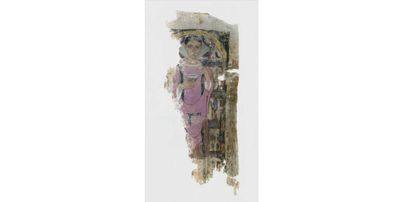 BRITISH MUSEUM EA68509, Christina Riggs. The Beautiful Burial in Roman Egypt: Art, Identity, and Funerary Religion, pl. 6
BRITISH MUSEUM EA68509, Christina Riggs. The Beautiful Burial in Roman Egypt: Art, Identity, and Funerary Religion, pl. 6ÎÎÎÎÎÎÎΡÎΦÎÎ
Lyn Green, Royal Ontario Museum, Department of World Cultureshttps://rom.academia.edu/LynGreen?fbc...
https://www.academia.edu/1154089/Quee..., L. 1988. "Queens and Princesses of the Amarna Period" (diss. Univ. of Toronto.
https://www.mdpi.com/2076-0752/8/3/92..., J., C. M. ten Berge, J. M. van Daal and B. F. van Oppen de Ruiter. 2019. "The Girl with the Golden Wreath: Four Perspectives on a Mummy Portrait," Arts 8(3), 92; https://doi.org/10.3390/arts8030092
Hart, M. L. 2016. âA Portrait of a Bearded Man Flanked by Isis and Serapis,â in Icon, Cult, and Context: Sacred Spaces and Objects in the Classical World, ed. M. K. Heyn, A. I. Steinsapir, Ann I, Cotsen Institute of Archaeology Press, pp. 79-89.
Riggs, C. 2006. The Beautiful Burial in Roman Egypt: Art, Identity, and Funerary Religion, pl. 6, Oxford and New York: Oxford University Press, 2006.



